Section 3 - National Topographic Database Production Information
1. Scope of this document
This Section of the Technical Specifications documents a variety of topics relating to the correct capture and revision of real world entities, as data, for the population of the National Topographic Database (NTDB). These topics include:
- the types of source material provided by Geoscience Australia to producers for the capture, revision and maintenance of NTDB. How this source material will be used, what producers will need to supply upon conversion of certain types of source material and how to communicate with Geoscience Australia when issues arise.
- defining the structure and structural rules of Geoscience Australia's NTDB.
- the cartographic principles which must be taken into account when capturing or maintaining data to allow easy production of the main map output of the databases (e.g. 1:250 000 and 1:100 000 National Topographic Map Series).
- specific feature capture and attribution rules for the translation of real world features and in certain cases their relationship to the surrounding environment to the digital data representation.
- information on data and map submission requirements to Geoscience Australia from their producers.
The methodology for both the updating and revision of the National Topographic Database (NTDB) may vary in the future, at the discretion of Geoscience Australia.
2. General Information
The NTDB is managed by the Oracle Relational Database Management System (RDBMS) and ESRI's ArcSDE software, and contain the relevant data tables and indexes.
The NTDB:
- is used for the revision and maintenance of topographic data captured at best available planimetric and attribute accuracy.
- is used to generate topographic and other spatial products at scales ranging from 1:25,000 to 1:10,000,000 including Geoscience Australia's flagship topographic 1:250 000 spatial products.
- is used to revise and generate the National Topographic Map Series (NTMS) maps and associated customised mapping products
- must comply with the standards and rules set out in Sections 1, 2 and 3 of this specification and in the Appendices. The only exception is when a project instruction is issued specifically allowing a variation.
The appendices to this specification include important descriptive information for the databases. In particular, appendices A, C and H should be referred to obtain a full understanding of the NTDB. Appendix A is the feature type dictionary. Appendix C is the Fence and Water Facilities Guide which separates Australia into regions of densely, moderately and sparsely settled areas which for certain features impact on the level of capture. Appendix H lists the range of paper sizes and geographic limits for adjusted (i.e. non-standard) map extents.
3. Revision
3.1 Revision sources
Information sources to allow revision of the features in the NTDB may be supplied by Geoscience Australia. Whenever possible the revision information will be supplied on a "change only" basis (i.e. following initial NMIG database review, those features subject to inclusion, change or deletion will be identified and will constitute the information supplied). Where this approach is not deemed to be either possible or practical, due to such factors as the quantum amount of change or complexity of errors, an overall "thematic" review of particular themes may be requested of the producer. In this instance, appropriate Base Material/Digital Data, Reference and Supporting Material to allow revision of the features in the NTDB will be supplied by Geoscience Australia, and these sources should suffice. Where producers have access to other information sources, they may be used; however, approval must be obtained from Geoscience Australia before use. All changed features visible on the imagery or contained in the other supplied information sources and meeting the criteria established in the feature type dictionary (see Appendix A) will be captured in the database.
Guidance on resolving conflict between sources is given in Section 3 Chapter 5.5 Priorities in Use of References, Map and Imagery. Where there is an unresolvable problem it should be referred to Geoscience Australia. Where use of the Reference Material creates an anomaly it should also be referred to Geoscience Australia. See Section 3 Chapter 3.4 Communication with Geoscience Australia in relation to data and map production
In instances where specific directives are contained in the Project Instructions or Action Requests issued by Geoscience Australia that take precedence over the Specifications, the Producer should provide a Production Note that references the source (i.e. Project Instruction or Action Request etc) and the subsequent change. These Production Notes should be populated in the ProductionNotePoints FeatureType in the Production Feature Dataset. See Section 3 Chapter 3.4 Communication with Geoscience Australia in relation to data and map production and Appendix A Production Note
3.2 Reference Material and Information Supplied by Geoscience Australia
3.2.1 Documentation
Documentation can be separated into two categories:
- Geoscience Australia's Topographic Data and Map Specifications: These Version 6 Specifications are used for the revision and maintenance of 1:25 000 to 1:10 000 000 scale topographic data and to facilitate the production of revised topographic maps. The Specifications include such things as: Data model description, Data structure information, Glossary of terms, Mapping specifications, Data dictionary and feature cross reference, Map format sheets and Guides.
- Project Instructions Project Instructions are unique to each Work Package and outline to the Producer the specific requirements of the project. These instructions accompany GA Specifications and will take precedence where indicated. Details are provided on the extent of work, number of Work Units (WU), features to be revised, imagery to be used, VAT testing applied, feature revision instructions and deliverables. Where the project extent covers a non-standard area, several files may be provided to give all relevant information.
| MATERIALS / INFORMATION DETAILS | FORMAT / DESCRIPTION |
|---|---|
| GEOSCIENCE AUSTRALIA TOPOGRAPHIC DATA AND MAP SPECIFICATIONS |
Specifications format HTML documents on the World Wide Web at the following address: http://www.ga.gov.au/mapspecs/topographic/v6 In some instances, the Specifications may be supplied on an individual basis through the Geoscience Australia QA process. |
| Project Instructions To be supplied for each work unit. |
File format Project File with associated information. This file may include plots and Geodatabase (mdb) files indicating the changes that are required to be made. |
3.2.2 Base Material
Base Material/Digital Data refers to hardcopy material or digital data which Geoscience Australia has designated as the starting point on which producers build a new dataset and apply any appropriate revision. This includes entities such as the NTDB, Digital Data derived from Geoscience Australia Stakeholders (e.g. State Mapping Authorities) as well as to a lessor extent reproduction material and latest previous edition maps produced by Geoscience Australia or Geoscience Australia Stakeholders (e.g. State Mapping Authorities).
In general, when no later information is available and an entity existing on the base material cannot be confirmed by imagery or a secondary source, the entity will be retained in the revised data with the attribution as shown on the designated base material.
Regardless of the spatial data integrity or quality of attribution of the designated base material, producers must ensure that the data submitted to Geoscience Australia (for Validation and Testing after revision, capture or maintenance activities) complies with all quality requirements and standards detailed in these specifications. The only exception is when Geoscience Australia has detailed an exemption within the project file.
| MATERIALS / INFORMATION DETAILS | FORMAT / DESCRIPTION |
|---|---|
| Digital Data from Geoscience Australia . |
Data format Geodatabase files; (Including possible replica databases) Geographical (GDA94) coordinate system Data Media Data will be supplied on one of the following media; External Hard Drives DVD CD-ROM |
| Digital Data from Geoscience Australia Stakeholders . |
Data format Geodatabase files; various coordinate systems (see project files) Data Media Data will be supplied on one of the following media; External Hard Drives DVD CD-ROM |
| PRINTED MAPS The printed maps being supplied for each Work Unit will be listed in the Project File and will generally be referenced by map name, edition and scale. |
Data Media/Format Printed Maps will be supplied on one of the following Media/data format; Paper Image files formats (GeoPDF, EPS, ECW, TIFF, GeoTIFF, JPEG) on External Hard Drives, DVD, CD-ROM |
| REPRODUCTION MATERIAL (repromat) Copies of reproduction material used to generate the latest previous map editions may be supplied where appropriate for revision and production purposes for 1:25 000 and 1:100 000 scale, but is unlikely to be supplied for 1:250 000 scale or smaller scales (larger areas). This reproduction material may only be supplied for revision of specific themes as outlined in the Project Instructions eg. to enable the capture of additional features not previously depicted. |
Repromat datum (all sheets) Repromat supplied will typically be on the AGD66 datum. When another datum is used this will be identified on the repromat. Repromat details A comprehensive listing of the repromat supplied will be included in the Project Instructions and Delivery Record documentation to accompany the Work Package. |
3.2.3 Reference and Supporting Material
Reference Material refers to all the relevant sources of information which must be used to directly revise the position and/or attributes of features during revision. This information can be internal data maintained by Geoscience Australia or externally sourced. In exceptional circumstances where the use or application of certain designated reference material may result in an illogical outcome, a producer should highlight these issues to Geoscience Australia and request direction on how to proceed.
Reference Material can be separated into a variety of categories:
- GIS data
- Imagery
- Hard-copy publications
- Error/Correction Reports
- Printed maps
- Reproduction Material
Supporting Material is information provided as a guide for data capture and attribution that may not be part of the scope of revision. Supporting Material is not used to directly revise features. For example: Powerline data may be provided to aid in the interpretation of linear features so they are not mistakenly captured as other linear features such as roads.
When using Reference and Supporting material it is important to understand its quality, content, completeness and appropriate use, therefore metadata defining the supplied material should be referred to by Producers. All digital dataset supplied by Geoscience Australia will be accompanied by a 'Metadata Statement'.
| MATERIALS / INFORMATION DETAILS | FORMAT / DESCRIPTION |
|---|---|
| GIS DATA See Individual Project Instructions for more details |
Data Format GIS data may be supplied in various formats including, but not limited to: ESRI shapefile, ArcInfo pGDB & fGDB or coverage. Mapinfo - tab, dat, map CAD dgn, dxf |
| SATELLITE IMAGERY / PHOTOGRAPHY Satellite imagery for the revision of the NTDB will be supplied as deemed appropriate for each Work Unit. For data capture at scales of 1:250 000 and smaller (larger areas), a combination of LANDSAT TM, SPOT or AlOS 10m and differing high resolution imagery may be supplied, together with various photography. For data capture at scales of 1:25 000 and 1:100 000, a combination of 60cm-100cm colour orthophotos, Quickbird, IKONOS, LIDAR and 2.5m resolution SPOT data may be supplied. Combinations of these items will vary according to availability of the geographical extent and nature of the respective areas being revised. |
Data Media DVD External Hard Drive All of the files will be written to DVD or large format USB drives. Imagery format The satellite imagery will be delivered as ARC/INFO 'imagename'.bil images with the associated 'imagename'.hdr file or 'imagename'.ecw. Each 'imagename'.hdr file will contain the basic information required by ARC/INFO and additional information to assist with a more complete description and projection information of the associated image. Orthophotography will generally be supplied as georeferenced ecw files, with associated .ers, .rtf and .tab files. |
| Hard Copy Publications Refers to commercial publications that contain specific information often relating to the attribution of topographic features. These publications are useful for specific Work Packages and therefore are only supplied to Producers at allocation of work. See Individual Project Instructions for more details |
|
| ERROR/CORRECTION REPORTS Only those errors (VAT, Map Correction and NTDB error points) that have not been incorporated in the "NMD Change Report" in the Project File will be supplied to producers. Where these reports are included they typically contain errors found during the VAT process and errors, or changes, reported subsequently by internal and external sources. They contain details of errors to be corrected in the production of the new product. Features to be corrected are typically referenced by their coordinate location, together with a brief description of the problem. To be supplied for only selected work units. |
Format Printed reports Errors Feature Class |
| PRINTED MAPS The printed maps being supplied for each Work Unit will be listed in the Project File and will generally be referenced by map name, edition and scale. |
Data Media/Format Printed Maps will be supplied on one of the following Media/data format; Paper Image files formats (GeoPDF, EPS, ECW, TIFF, GeoTIFF, JPEG) on External Hard Drives, DVD, CD-ROM |
| REPRODUCTION MATERIAL (repromat) Copies of reproduction material used to generate the latest previous map editions may be supplied where appropriate for revision and production purposes for 1:25 000 and 1:100 000 scale, but is unlikely to be supplied for 1:250 000 scale or smaller scales (larger areas). This reproduction material may only be supplied for revision of specific themes as outlined in the Project Instructions eg. to enable the capture of additional features not previously captured. |
Repromat datum (all sheets) Repromat supplied will typically be on the AGD66 datum. When another datum is used this will be identified on the repromat. Repromat details A comprehensive listing of the repromat supplied will be included in the Project Instructions and Delivery Record documentation to accompany the Work Package. |
3.2.4 Map marginalia information
| MATERIALS / INFORMATION DETAILS | FORMAT / DESCRIPTION |
|---|---|
| Information required for the production of the map surrounds (marginalia); This would typically include the following information supplied for each work unit each time a new Work Unit project is allocated. Other information may also be supplied as required;
|
Delivery method These numbers, dates or figures will be supplied with the individual Work Unit |
The following marginalia information will be issued on a "once-only" basis; i.e. as a standard issue at the beginning of the program or until a variation is provided via an Action Request. This information will not be generated for each issue of the Work Unit.
|
Delivery method These will be supplied in ArcInfo export file (.e00) format |
3.3 Scanning Transformation Error Report
The scanning transformation RMS error report will give the difference between known control points and their scanned locations for each piece of material scanned. Points will not be accepted with a difference greater than plus or minus 50 metres at 1:250 000 and plus or minus 20 metres at 1:100 000.
A sample report follows. The report layout may vary but area and coverage information, identification of the control points used, individual residual errors and RMS must be included. Producers will be required to supply a scanning transformation RMS error report for each repromat or equivalent hardcopy information scanned for raster to vector conversion.
AFFINE Transformation Report Mon Dec 23 11:47:19 1996 ******************************************************** Units quoted are in MASTER UNITS unless specified. Datafile: C:\SUSIE\BETOOHYD.DGN Masterfile: C:\SUSIE\BETOOHYM.DGN ID Master Control Monuments (x,y) Data Transformed Monuments (x,y) -------------------------------------------------------------------------------------------- 1 [ 349872.300000 , 7123444.600000 ] [ 349873.929659 , 7123428.288025 ] 2 [ 349242.300000 , 7178826.600000 ] [ 349237.220023 , 7178833.546668 ] 3 [ 348623.700000 , 7234205.100000 ] [ 348626.543897 , 7234209.506276 ] 4 [ 399086.600000 , 7234670.500000 ] [ 399094.244822 , 7234674.842476 ] 5 [ 449544.500000 , 7234949.600000 ] [ 449550.005428 , 7234942.321504 ] 6 [ 500000.000000 , 7235042.700000 ] [ 499992.392353 , 7235023.575531 ] 7 [ 500000.000000 , 7179676.300000 ] [ 499998.063041 , 7179687.991801 ] 8 [ 500000.000000 , 7124306.200000 ] [ 500002.834445 , 7124315.153958 ] 9 [ 449960.600000 , 7124210.500000 ] [ 449969.185596 , 7124205.623738 ] 10 [ 399918.800000 , 7123923.300000 ] [ 399914.162437 , 7123917.921840 ] 11 [ 399498.900000 , 7179298.700000 ] [ 399490.300307 , 7179310.844932 ] 12 [ 449750.700000 , 7179581.900000 ] [ 449749.517992 , 7179586.383251 ] List of Residuals ******************* ID Weight X-Component Y-Component VectorNorm -------------------------------------------------------------------------------------------- 1 1.00 -1.629659414 16.311974859 16.393178874 2 1.00 5.079977336 -6.946668010 8.605949464 3 1.00 -2.843897290 -4.406276007 5.244332183 4 1.00 -7.644821656 -4.342475807 8.792064279 5 1.00 -5.505427580 7.278496484 9.126129733 6 1.00 7.607646697 19.124468721 20.582069675 7 1.00 1.936959281 -11.691800690 11.851160898 8 1.00 -2.834445248 -8.953958160 9.391881952 9 1.00 -8.585596244 4.876261763 9.873722280 10 1.00 4.637563426 5.378159508 7.101520558 11 1.00 8.599692800 -12.144931703 14.881333352 12 1.00 1.182007866 -4.483250976 4.636451435 Residuals (Sum) - X : -2.625165507E-08 Y : -1.862645149E-08 Residuals (Sum of Squares - X & Y) : 1574.040141472 Scaling - X : 1.250257 Y : 1.250349 Translation - X : 338898.447172 Y : 7114096.609280 Rotation - 0.351557 degrees Non-orthogonality - -0.004027 degrees End of report. Checked :............ .../.../... ********************************************************************************************
3.4 Communication with Geoscience Australia in relation to data and map production
Action Requests and Production Notes are an important means of communication available to Producers when they wish to query specific project or feature instructions (Action Requests) or document specific action they have taken during the production phase (Production Notes).
These forms of communication are important in that they provide Geoscience Australia in general, and Validation And Testing Unit (VAT) in particular, a clearer and more complete picture of the issues addressed by the Producer. These documents can then be used in the assessment and validation of the submitted data etc. It is in the interest of the Producer to supply this documentation (where deemed necessary), so that VAT can take these issues and decisions into consideration, particularly where a specific course of action has been sanctioned by Geoscience Australia.
It is important that the Producer follows the guidelines below on the use of Action Requests, Production Notes and general communication.
Action Requests should be used to:
- Clarify any feature revision instructions within the Project Instructions.
- Highlight any major anomalies with features in the data not identified within the Project Instructions.
- Request further information not provided in the Project Instruction or Delivery record.
- Seek guidance on feature editing or revision when a decision or course of action cannot reasonably be determined from the information/instructions supplied.
Note: Action Requests submitted for this purpose should be used sparingly and only when unable to resolve the issue following investigation of supplied information. - Inform Geoscience Australia of any issues with the data (e.g. quality/accessibility of data received, or notes on data generated and submitted by the Producer), or advice or explanation for any delays in delivery.
Important: Hard copies of Action Requests (with the response by Geoscience Australia) should be placed on the Project File at submission, and preferably in a chronological order. Where an Action Request response is generic and applicable to a number of different Work Packages, the Action Request should be copied by the Producer and placed on each respective individual Work Package file.
Production Notes should be used to:
- Detail any interpretation of features that require further explanation.
- Detail any alteration of features that link back to an action request response.
- Provide justification or explanation for any revision or actions carried out where they are inconsistent with relevant Project Instructions or Specifications.
Note: It will be assumed that the Project Instructions and relevant Specifications have been complied with, and Production Notes are only required to explain actions that deviate from them.
Production Notes should be created using the Production Note feature type within the Production Feature Dataset. For more information, refer to the Production Note feature type entry within Appendix A.
Action Requests should be created using the template supplied to producers by Geoscience Australia. This template is not part of the specifications but rather part of the general reference information provided to each contractor.
If instances arise where the Action Request/Production Notes system is not appropriate and the Producer feels it necessary to contact someone in Geoscience Australia, then please contact the Work Package Team Leader as your first point of call. The contact information for the Work Package Team Leader will be supplied within the project instructions.
4. The National Topographic Database Structure
This chapter is broken into 5 sub chapters, namely 'Structure Overview', 'Domains', 'Subtype Defaults', 'Non Spatial Tables and Relationship Classes' and 'Topology Rules'.
The first sub chapter 'Structure Overview' documents the Feature Datasets, Feature Classes, Feature Types and their associated attributes for the NTDB.
The second sub chapter 'Domains' documents the rational behind the use of domains within the NTDB. It also provides information on the definition of all of the domains used in the model.
The third sub chapter 'Subtype Defaults' documents all the subtype defaults which exist in the NTDB. It also provides information on the recommended method of utilising these defaults.
The fourth sub chapter 'Non Spatial Tables and Relationship Classes' documents the use and definition of related non spatial tables in the NTDB.
The fifth and final sub chapter 'Topology Rules' documents the use, benefits and definition of topology rule sets in the NTDB.
4.1 Structure Overview
The following lists every Feature Dataset, Feature Class, their associated Feature Types, attribute fields and geometry. The attributes are listed in the order required for the NTDB.
All Database Structure is sorted by feature dataset and then internally by geometry type and then feature class in alphabetic order.
Open the Data Structure in a new window:
These specifications and the associated tables above and below represents the Production geodatabase schema, using the names of feature datasets, feature classes, and feature types and associated attributes as termed in the production environment. This schema differs in structure and precision to the Distribution geodatabase schema supplied by Geoscience Australia to the public via on-line downloads and packaged products. A distribution schema to production schema cross reference, as well as a production schema to distribution schema cross reference is provided to assist in translation by users.
4.2 Domains
Domains have been established on the NTDB. Domains are dropped as part of the translation from the production model to distribution schemas.
Domains throughout the specifications will be referred by their generic name (e.g.dm_UpperScale), however when used for specific model a suffix will be added to the generic name to differentiate the domain when in the SDE environment. For example in the production model the dm_Upperscale domain will be named dm_UpperscaleMultScle but in a custom model designed for Solar work it would be named dm_UpperscaleSolar.
Domains have been implemented into the data structure to provide a means to limit and standardise the range of values which are acceptable to specific item field. This assists in controlling the quality of data attribution and should provide confidence to both producers and Geoscience Australia that minor errors such as spelling mistakes and spacing errors do not occur for those fields which have domains established.
Geoscience Australia has chosen that a domain code and its associated value will be identical. This has been established to minimise difficulties in the importing and exporting of data and when model upgrades occur. In addition, the translation of the data from the production to distribution model is simplified. Most domains in the NTDB are textual in nature, providing producers and users of the database a more innate grasp of the concept a particular domain code may be representing than a representative numeric value.
Domains have only been established on items which are considered stable and limited in acceptable values. For example a name field with an infinite set of possible values is not appropriate to utilise domains however the road formation item which has only 4 acceptable values of 'Sealed', 'Unimproved', 'Unknown' and 'Unsealed' is suitable.
Domains have been established both at the feature class level and at the subtype level as appropriate. Certain subtypes within a feature class may vary in the need to populate certain items and in these cases the domain will only be assigned to the subtypes which require the item to be attributed.
A complete list of Domain and their definition/content can be found in 'Appendix X - Listing of Domain Tables and Definitions'. The table below lists the domains which occur under each feature class. Each domain entry in the table below is hyperlinked directly to its domain definition in 'Appendix X - Listing of Domain Tables and Definitions'.
| FeatureClass | FieldName | Domain | Specific Subtype Only |
|---|---|---|---|
| AdministrationAnno100K | FEATURE | dm_AdministrationFCs | |
| AdministrationAnno250K | FEATURE | dm_AdministrationFCs | |
| AdministrationAreas | CLASS | dm_Access | 1 |
| AdministrationAreas | RESTRICTIONS | dm_Restrictions | |
| AdministrationAreas | STATE | dm_IslandState | |
| AdministrationAreas | UPPERSCALE | dm_UpperScale | |
| AdministrationAreas | USCERTAINTY | dm_USCertainty | |
| AircraftFacilityAreas | AIRPORTDESIGNATION | dm_AirportDesignation | |
| AircraftFacilityAreas | FACILITIES | dm_AviationFacilities | |
| AircraftFacilityAreas | STATUS | dm_AviationStatus | |
| AircraftFacilityAreas | SURFACE | dm_Surface | |
| AircraftFacilityAreas | UPPERSCALE | dm_UpperScale | |
| AircraftFacilityAreas | USAGES | dm_Usages | |
| AircraftFacilityAreas | USCERTAINTY | dm_USCertainty | |
| AircraftFacilityAreas | VERIFICATIONSTATUS | dm_VerificationStatus | |
| AircraftFacilityLines | FACILITIES | dm_AviationFacilities | |
| AircraftFacilityLines | LANDINGACCESS | dm_LandingAccess | 3 |
| AircraftFacilityLines | STATUS | dm_AviationStatus | |
| AircraftFacilityLines | SURFACE | dm_Surface | |
| AircraftFacilityLines | UPPERSCALE | dm_UpperScale | |
| AircraftFacilityLines | USAGES | dm_Usages | |
| AircraftFacilityLines | USCERTAINTY | dm_USCertainty | |
| AircraftFacilityLines | VERIFICATIONSTATUS | dm_VerificationStatus | |
| AircraftFacilityPoints | FACILITIES | dm_AviationFacilities | |
| AircraftFacilityPoints | STATUS | dm_AviationStatus | |
| AircraftFacilityPoints | UPPERSCALE | dm_UpperScale | |
| AircraftFacilityPoints | USAGES | dm_Usages | |
| AircraftFacilityPoints | USCERTAINTY | dm_USCertainty | |
| AircraftFacilityPoints | VERIFICATIONSTATUS | dm_VerificationStatus | |
| AviationAnno100K | FEATURE | dm_AviationFCs | |
| AviationAnno250K | FEATURE | dm_AviationFCs | |
| BathymetryAnno2_5MIL | FEATURE | dm_BathymetryFCs | |
| BathymetryAnno5MIL | FEATURE | dm_BathymetryFCs | |
| BathymetryAnno10MIL | FEATURE | dm_BathymetryFCs | |
| Bores | UPPERSCALE | dm_UpperScale | |
| Bores | USCERTAINTY | dm_USCertainty | |
| BuildingAreas | BUILDINGFUNCTION | dm_BuildingFunctionEdu | 1 |
| BuildingAreas | BUILDINGFUNCTION | dm_BuildingFunctionHW | 2 |
| BuildingAreas | BUILDINGFUNCTION | dm_BuildingFunctionEm | 3 |
| BuildingAreas | BUILDINGFUNCTION | dm_BuildingFunctionRes | 4 |
| BuildingAreas | BUILDINGFUNCTION | dm_BuildingFunctionCoC | 5 |
| BuildingAreas | BUILDINGFUNCTION | dm_BuildingFunctionII | 6 |
| BuildingAreas | BUILDINGSTATUS | dm_BuildingStatus | |
| BuildingAreas | SIGNIFICANCE | dm_HeritageSignificance | |
| BuildingAreas | UPPERSCALE | dm_UpperScale | |
| BuildingAreas | USCERTAINTY | dm_USCertainty | |
| BuildingPoints | BUILDINGFUNCTION | dm_BuildingFunctionEdu | 1 |
| BuildingPoints | BUILDINGFUNCTION | dm_BuildingFunctionHW | 2 |
| BuildingPoints | BUILDINGFUNCTION | dm_BuildingFunctionEm | 3 |
| BuildingPoints | BUILDINGFUNCTION | dm_BuildingFunctionRes | 4 |
| BuildingPoints | BUILDINGFUNCTION | dm_BuildingFunctionCoC | 5 |
| BuildingPoints | BUILDINGFUNCTION | dm_BuildingFunctionII | 6 |
| BuildingPoints | BUILDINGSTATUS | dm_BuildingStatus | |
| BuildingPoints | SIGNIFICANCE | dm_HeritageSignificance | |
| BuildingPoints | UPPERSCALE | dm_UpperScale | |
| BuildingPoints | USCERTAINTY | dm_USCertainty | |
| BuiltUpAreas | UPPERSCALE | dm_UpperScale | |
| BuiltUpAreas | USCERTAINTY | dm_USCertainty | |
| CanalAreas | UPPERSCALE | dm_UpperScale | |
| CanalAreas | USCERTAINTY | dm_USCertainty | |
| CanalLines | UPPERSCALE | dm_UpperScale | |
| CanalLines | USCERTAINTY | dm_USCertainty | |
| CartographicLines | UPPERSCALE | dm_UpperScale | 6 and 7 |
| CartographicLines | USCERTAINTY | dm_USCertainty | 6 and 7 |
| CartographyAnno100K | FEATURE | dm_CartographyFCs | |
| CartographyAnno250K | FEATURE | dm_CartographyFCs | |
| CartographyAnnoWAC | FEATURE | dm_CartographyFCs | |
| CartographyAnno2_5MIL | FEATURE | dm_CartographyFCs | |
| CartographyAnno5MIL | FEATURE | dm_CartographyFCs | |
| CartographyAnno10MIL | FEATURE | dm_CartographyFCs | |
| Caves | UPPERSCALE | dm_UpperScale | |
| Caves | USCERTAINTY | dm_USCertainty | |
| CemeteryPoints | UPPERSCALE | dm_UpperScale | |
| CemeteryPoints | USCERTAINTY | dm_USCertainty | |
| CultivatedAreas | PRODUCT | dm_OrchardProduct | 1 |
| CultivatedAreas | PRODUCT | dm_PlantationProduct | 2 |
| CultivatedAreas | UPPERSCALE | dm_UpperScale | |
| CultivatedAreas | USCERTAINTY | dm_USCertainty | |
| CultureAnno100K | FEATURE | dm_CultureFCs | |
| CultureAnno250K | FEATURE | dm_CultureFCs | |
| CultureAnnoWAC | FEATURE | dm_CultureFCs | |
| DamWalls | UPPERSCALE | dm_UpperScale | |
| DamWalls | USCERTAINTY | dm_USCertainty | |
| DeformationAreas | UPPERSCALE | dm_UpperScale | |
| DeformationAreas | USCERTAINTY | dm_USCertainty | |
| Discontinuities | UPPERSCALE | dm_UpperScale | |
| Discontinuities | USCERTAINTY | dm_USCertainty | |
| DrainageAnno100K | FEATURE | dm_DrainageFCs | |
| DrainageAnno250K | FEATURE | dm_DrainageFCs | |
| DrainageAnnoWAC | FEATURE | dm_DrainageFCs | |
| DrainageAnno2_5MIL | FEATURE | dm_DrainageFCs | |
| DrainageAnno5MIL | FEATURE | dm_DrainageFCs | |
| DrainageAnno10MIL | FEATURE | dm_DrainageFCs | |
| EmergencyFacilityPoints | UPPERSCALE | dm_UpperScale | |
| EmergencyFacilityPoints | USCERTAINTY | dm_USCertainty | |
| Errors | IMPORTANCE | dm_ErrorImportance | |
| Fences | UPPERSCALE | dm_UpperScale | |
| Fences | USCERTAINTY | dm_USCertainty | |
| FerryRouteLines | UPPERSCALE | dm_UpperScale | |
| FerryRouteLines | USCERTAINTY | dm_USCertainty | |
| FieldInspectionIndex | FIELDINSPECTIONTYPE | dm_FieldInspections | |
| Flats | UPPERSCALE | dm_UpperScale | |
| Flats | USCERTAINTY | dm_USCertainty | |
| FootBridges | CROSSINGSTRUCTURE | dm_CrossingStructure | |
| FootTracks | FORMATION | dm_FoottrackFormation | |
| FootTracks | SIGNIFICANCE | dm_Significance | |
| FootTracks | UPPERSCALE | dm_UpperScale | |
| FootTracks | USCERTAINTY | dm_USCertainty | ForeshoreFlats | UPPERSCALE | dm_UpperScale |
| ForeshoreFlats | USCERTAINTY | dm_USCertainty | |
| FrameworkAnno100K | FEATURE | dm_FrameworkFCs | |
| FrameworkAnno250K | FEATURE | dm_FrameworkFCs | |
| FrameworkAnnoWAC | FEATURE | dm_FrameworkFCs | |
| FrameworkAnno2_5MIL | FEATURE | dm_FrameworkFCs | |
| FrameworkAnno5MIL | FEATURE | dm_FrameworkFCs | |
| FrameworkAnno10MIL | FEATURE | dm_FrameworkFCs | |
| HabitationAnno100K | FEATURE | dm_HabitationFCs | |
| HabitationAnno250K | FEATURE | dm_HabitationFCs | |
| HabitationAnnoWAC | FEATURE | dm_HabitationFCs | |
| HabitationAnno2_5MIL | FEATURE | dm_HabitationFCs | |
| HabitationAnno5MIL | FEATURE | dm_HabitationFCs | |
| HabitationAnno10MIL | FEATURE | dm_HabitationFCs | |
| HorizontalControlPoints | UPPERSCALE | dm_UpperScale | |
| HorizontalControlPoints | USCERTAINTY | dm_USCertainty | |
| IndustryAnno100K | FEATURE | dm_IndustryFCs | |
| IndustryAnno250K | FEATURE | dm_IndustryFCs | |
| IndustryAnnoWAC | FEATURE | dm_IndustryFCs | |
| InternationalBoundaries | UPPERSCALE | dm_UpperScale | |
| InternationalBoundaries | USCERTAINTY | dm_USCertainty | |
| Islands | STATE | dm_IslandState | |
| IslandsWAC | STATE | dm_IslandState | |
| Islands2_5MIL | STATE | dm_IslandState | |
| Islands5MIL | STATE | dm_IslandState | |
| Islands10MIL | STATE | dm_IslandState | |
| Lakes | PERENNIALITY | dm_Perenniality | |
| Lakes | UPPERSCALE | dm_UpperScale | |
| Lakes | USCERTAINTY | dm_USCertainty | |
| LandmarkPoints | UPPERSCALE | dm_UpperScale | |
| LandmarkPoints | USCERTAINTY | dm_USCertainty | |
| LiquidFuelDepotPoints | OWNER | dm_LiquidFuelOwners | |
| LiquidFuelDepotPoints | SPATIALACCURACY | dm_SpatialAccuracyConfidence | |
| LiquidFuelDepotPoints | STATE | dm_IslandState | |
| LiquidFuelRefineryPoints | OWNER | dm_LiquidFuelOwners | |
| LiquidFuelRefineryPoints | PRODUCT | dm_LiquidFuelProducts | |
| LiquidFuelRefineryPoints | SPATIALACCURACY | dm_SpatialAccuracyConfidence | |
| LiquidFuelRefineryPoints | STATE | dm_IslandState | |
| LiquidFuelTerminalPoints | OWNER | dm_LiquidFuelOwners | |
| LiquidFuelTerminalPoints | PRODUCT | dm_LiquidFuelProducts | |
| LiquidFuelTerminalPoints | SPATIALACCURACY | dm_SpatialAccuracyConfidence | |
| LiquidFuelTerminalPoints | STATE | dm_IslandState | |
| Locations | UPPERSCALE | dm_UpperScale | |
| Locations | USCERTAINTY | dm_USCertainty | |
| Mainlands | STATE | dm_MainlandState | |
| MainlandsWAC | STATE | dm_MainlandState | |
| Mainlands2_5MIL | STATE | dm_MainlandState | |
| Mainlands5_MIL | STATE | dm_MainlandState | |
| Mainlands10MIL | STATE | dm_MainlandState | |
| MapIndexes100K | LAYOUTGUIDE | dm_MapLayout | |
| MapIndexes250K | LAYOUTGUIDE | dm_MapLayout | |
| MapIndexesWAC | LAYOUTGUIDE | dm_MapLayoutWAC | |
| MarineAnno100K | FEATURE | dm_MarineFCs | |
| MarineAnno250K | FEATURE | dm_MarineFCs | |
| MarineAnnoWAC | FEATURE | dm_MarineFCs | |
| MarineAnno2_5MIL | FEATURE | dm_MarineFCs | |
| MarineAnno5MIL | FEATURE | dm_MarineFCs | |
| MarineAnno10MIL | FEATURE | dm_MarineFCs | |
| MarineHazardAreas | RELATIONSHIP | dm_MarineRelationship | |
| MarineHazardAreas | UPPERSCALE | dm_UpperScale | |
| MarineHazardAreas | USCERTAINTY | dm_USCertainty | |
| MarineHazardPoints | RELATIONSHIP | dm_MarineRelationship | |
| MarineHazardPoints | UPPERSCALE | dm_UpperScale | |
| MarineHazardPoints | USCERTAINTY | dm_USCertainty | |
| MarineInfrastructureLines | UPPERSCALE | dm_UpperScale | |
| MarineInfrastructureLines | USCERTAINTY | dm_USCertainty | |
| MinePoints | UPPERSCALE | dm_UpperScale | |
| MinePoints | USCERTAINTY | dm_USCertainty | |
| NativeVegetationAreas | COVERDENSITY | dm_CoverDensity | |
| NativeVegetationAreas | UPPERSCALE | dm_UpperScale | |
| NativeVegetationAreas | USCERTAINTY | dm_USCertainty | |
| NavigationAids | RELATIONSHIP | dm_AviationRelationship | |
| NavigationLights | LIGHTFUNCTION | dm_LightFunction | |
| PetrolStationPoints | OWNER | dm_PetrolStationOwners | |
| PetrolStationPoints | SPATIALACCURACY | dm_SpatialAccuracyConfidence | |
| PetrolStationPoints | STATE | dm_IslandState | |
| PhysiographyAnno100K | FEATURE | dm_PhysiographyFCs | |
| PhysiographyAnno250K | FEATURE | dm_PhysiographyFCs | |
| Pinnacles | UPPERSCALE | dm_UpperScale | |
| Pinnacles | USCERTAINTY | dm_USCertainty | |
| Pipelines | RELATIONSHIP | dm_PipelineRelationship | |
| Pipelines | RESTRICTIONS | dm_Restrictions | |
| Pipelines | STATUS | dm_PipelineStatus | |
| Pipelines | UPPERSCALE | dm_UpperScale | |
| Pipelines | USCERTAINTY | dm_USCertainty | |
| PondageAreas | UPPERSCALE | dm_UpperScale | |
| PondageAreas | USCERTAINTY | dm_USCertainty | |
| PowerlineDistributionNetwork | REALIGNMENTSTATUS | dm_RealignmentStatus | |
| PowerlineDistributionNetwork | RELATIONSHIP | dm_PowerlineRelationship | |
| PowerlineDistributionNetwork | RESTRICTIONS | dm_Restrictions | |
| PowerlineDistributionNetwork | SPATIALACCURACY | dm_SpatialAccuracyConfidence | |
| PowerlineDistributionNetwork | STATE | dm_IslandState | |
| PowerlineDistributionNetwork | STATUS | dm_PowerlineStatus | |
| PowerlineDistributionNetwork | UPPERSCALE | dm_UpperScale | |
| PowerlineDistributionNetwork | USCERTAINTY | dm_USCertainty | |
| PowerlineTransmissionNetwork | RELATIONSHIP | dm_PowerlineRelationship | |
| PowerlineTransmissionNetwork | RESTRICTIONS | dm_Restrictions | |
| PowerlineTransmissionNetwork | SPATIALACCURACY | dm_SpatialAccuracyConfidence | |
| PowerlineTransmissionNetwork | STATE | dm_IslandState | |
| PowerlineTransmissionNetwork | STATUS | dm_PowerlineStatus | |
| PowerlineTransmissionNetwork | UPPERSCALE | dm_UpperScale | |
| PowerlineTransmissionNetwork | USCERTAINTY | dm_USCertainty | |
| PowerStations | CLASS | dm_PowerStationClass | |
| PowerStations | FUELTYPE | dm_PowerStationFuel | |
| PowerStations | RESTRICTIONS | dm_Restrictions | |
| PowerStations | SPATIALACCURACY | dm_SpatialAccuracyConfidence | |
| PowerStations | STATE | dm_IslandState | |
| PowerStations | STATUS | dm_PowerStationStatus | |
| RailTransportAnno100K | FEATURE | dm_RailTransportFCs | |
| RailTransportAnno250K | FEATURE | dm_RailTransportFCs | |
| RailTransportAnnoWAC | FEATURE | dm_RailTransportFCs | |
| RailTransportAnno2_5MIL | FEATURE | dm_RailTransportFCs | |
| RailwayCrossingPoints | STATUS | dm_RailwayStatus | |
| RailwayCrossingPoints | PURPOSE | dm_PurposeOfConstruction | |
| RailwayCrossingPoints | UPPERSCALE | dm_UpperScale | |
| RailwayCrossingPoints | USCERTAINTY | dm_USCertainty | |
| RailwayCrossingLines | STATUS | dm_RailwayStatus | |
| RailwayCrossingLines | PURPOSE | dm_PurposeOfConstruction | |
| Railways | GAUGE | dm_RailwayGauge | |
| Railways | STATUS | dm_RailwayStatus | |
| Railways | TRACKS | dm_RailwayTracks | |
| Railways | UPPERSCALE | dm_UpperScale | |
| Railways | USCERTAINTY | dm_USCertainty | |
| RailwayStopPoints | RAILSTATIONSTATUS | dm_RailStationStatus | 1 |
| RailwayStopPoints | RAILSTATIONSTATUS | dm_RailSidingStatus | 2 |
| RailwayStopPoints | UPPERSCALE | dm_UpperScale | |
| RailwayStopPoints | USCERTAINTY | dm_USCertainty | |
| RecreationAreas | UPPERSCALE | dm_UpperScale | |
| RecreationAreas | USCERTAINTY | dm_USCertainty | |
| ReliefAnno100K | FEATURE | dm_ReliefFCs | |
| ReliefAnno250K | FEATURE | dm_ReliefFCs | |
| ReliefAnnoWAC | FEATURE | dm_ReliefFCs | |
| ReliefAnno2_5MIL | FEATURE | dm_ReliefFCs | |
| ReliefAnno5MIL | FEATURE | dm_ReliefFCs | |
| ReliefAnno10MIL | FEATURE | dm_ReliefFCs | |
| Reservoirs | UPPERSCALE | dm_UpperScale | |
| Reservoirs | USCERTAINTY | dm_USCertainty | |
| RoadCrossingLines | CROSSINGSTRUCTURE | dm_CrossingStructure | 2 and 5 |
| RoadCrossingLines | PURPOSE | dm_PurposeOfConstruction | |
| RoadCrossingPoints | CROSSINGSTRUCTURE | dm_CrossingStructure | 2 |
| RoadCrossingPoints | PURPOSE | dm_PurposeOfConstruction | |
| RoadCrossingPoints | UPPERSCALE | dm_UpperScale | |
| RoadCrossingPoints | USCERTAINTY | dm_USCertainty | |
| Roads | AUTHORITY | dm_RoadAuthority | |
| Roads | CLASS | dm_RoadClassification | |
| Roads | FORMATION | dm_RoadFormation | |
| Roads | FUNCTION | dm_RoadFunction | |
| Roads | MAINTAINER | dm_RoadAuthority | |
| Roads | NUMBEROFLANES | dm_NumberOfLanes | |
| Roads | RESTRICTIONS | dm_Restrictions | |
| Roads | ROADSTATUS | dm_RoadStatus | |
| Roads | TRAFFICABILITY | dm_RoadAccess | |
| Roads | TRAVELDIRECTION | dm_TravelDirection | |
| Roads | UPPERSCALE | dm_UpperScale | |
| Roads | USCERTAINTY | dm_USCertainty | |
| Roads | USERACCESS | dm_UserAccess | |
| RoadTransportAnno100K | FEATURE | dm_RoadTransportFCs | |
| RoadTransportAnno250K | FEATURE | dm_RoadTransportFCs | |
| RoadTransportAnnoWAC | FEATURE | dm_RoadTransportFCs | |
| RoadTransportAnno2_5MIL | FEATURE | dm_RoadTransportFCs | |
| SandRidges | UPPERSCALE | dm_UpperScale | |
| SandRidges | USCERTAINTY | dm_USCertainty | |
| Sands | UPPERSCALE | dm_UpperScale | |
| Sands | USCERTAINTY | dm_USCertainty | |
| Seas | OCEANNAME | dm_OceanNames | |
| Seas | OTHERWATERNAME | dm_OtherWaterNames | |
| Seas | SEANAME | dm_SeaNames | |
| SeasWAC | OCEANNAME | dm_OceanNames | |
| SeasWAC | OTHERWATERNAME | dm_OtherWaterNames | |
| SeasWAC | SEANAME | dm_SeaNames | |
| Seas2_5MIL | OCEANNAME | dm_OceanNames | |
| Seas2_5MIL | OTHERWATERNAME | dm_OtherWaterNames | |
| Seas2_5MIL | SEANAME | dm_SeaNames | |
| Seas5MIL | OCEANNAME | dm_OceanNames | |
| Seas5MIL | OTHERWATERNAME | dm_OtherWaterNames | |
| Seas5MIL | SEANAME | dm_SeaNames | |
| SettlementDensityBoundaries | CLASS | dm_RoadClassification | |
| SettlementDensityBoundaries | FORMATION | dm_RoadFormation | |
| SettlementDensityIndex | REGIONDESCRIPTION | dm_SettlementRegion | |
| SewageTreatmentPlants | SPATIALACCURACY | dm_SpatialAccuracyConfidence | |
| SewageTreatmentPlants | STATE | dm_IslandState | |
| SewageTreatmentPlants | STATUS | dm_PowerStationStatus | |
| SpotElevations | ACCURACY | dm_SpotAccuracy | |
| SpotElevations | CLASS | dm_SpotElevationClass | |
| SpotElevations | ORIGIN | dm_SpotElevationOrigin | |
| SpotElevations | UPPERSCALE | dm_UpperScale | |
| SpotElevations | USCERTAINTY | dm_USCertainty | |
| StorageTanks | PRODUCT | dm_StorageTankProduct | |
| StorageTanks | UPPERSCALE | dm_UpperScale | |
| StorageTanks | USCERTAINTY | dm_USCertainty | |
| SubStations | CLASS | dm_SubstationClassification | |
| SubStations | RESTRICTIONS | dm_Restrictions | |
| SubStations | SPATIALACCURACY | dm_SpatialAccuracyConfidence | |
| SubStations | STATE | dm_IslandState | |
| SubStations | STATUS | dm_SubStationStatus | |
| SurveyMarksAnno100K | FEATURE | dm_SurveyMarksFCs | |
| SurveyMarksAnno250K | FEATURE | dm_SurveyMarksFCs | |
| SurveyMarksAnno2_5MIL | FEATURE | dm_SurveyMarksFCs | |
| TelephoneExchanges | SPATIALACCURACY | dm_SpatialAccuracyConfidence | |
| TelephoneExchanges | STATE | dm_IslandState | |
| TouristPoints | TOURISTTYPE | dm_TouristType | |
| TouristPoints | UPPERSCALE | dm_UpperScale | |
| TouristPoints | USCERTAINTY | dm_USCertainty | |
| TrafficControlDevices | NUMBEROFLANES | dm_NumberOfLanes | 4 |
| TrafficControlDevices | UPPERSCALE | dm_UpperScale | |
| TrafficControlDevices | USCERTAINTY | dm_USCertainty | |
| UtilityAnno100K | FEATURE | dm_UtilityFCs | |
| UtilityAnno250K | FEATURE | dm_UtilityFCs | |
| UtilityAnnoWAC | FEATURE | dm_UtilityFCs | |
| VegetationAnno100K | FEATURE | dm_VegetationFCs | |
| VegetationAnno250K | FEATURE | dm_VegetationFCs | |
| VegetationAnnoWAC | FEATURE | dm_VegetationFCs | |
| VerticalObstructions | GROUPSINGLE | dm_GroupSingle | |
| VerticalObstructions | LIGHTING | dm_Lighting | |
| VerticalObstructions | MAST | dm_MastExistence | |
| VerticalObstructions | STATIONTYPE | dm_VOStationType | |
| VerticalObstructions | RESTRICTIONS | dm_Restrictions | |
| VerticalObstructions | UPPERSCALE | dm_UpperScale | |
| VerticalObstructions | USCERTAINTY | dm_USCertainty | |
| WasteManagementAreas | LANDFILL | dm_WasteManagementStatus | |
| WasteManagementAreas | REPROCESSING | dm_WasteManagementStatus | |
| WasteManagementAreas | RESTRICTIONS | dm_Restrictions | |
| WasteManagementAreas | SPATIALACCURACY | dm_SpatialAccuracyConfidence | |
| WasteManagementAreas | STATE | dm_IslandState | |
| WasteManagementAreas | TRANSFERSTATION | dm_WasteManagementStatus | |
| WasteManagementPoints | LANDFILL | dm_WasteManagementStatus | |
| WasteManagementPoints | REPROCESSING | dm_WasteManagementStatus | |
| WasteManagementPoints | RESTRICTIONS | dm_Restrictions | |
| WasteManagementPoints | SPATIALACCURACY | dm_SpatialAccuracyConfidence | |
| WasteManagementPoints | STATE | dm_IslandState | |
| WasteManagementPoints | TRANSFERSTATION | dm_WasteManagementStatus | |
| WasteManagementPoints | UPPERSCALE | dm_UpperScale | |
| WasteManagementPoints | USCERTAINTY | dm_USCertainty | |
| WaterbodiesAnno100K | FEATURE | dm_WaterbodiesFCs | |
| WaterbodiesAnno250K | FEATURE | dm_WaterbodiesFCs | |
| WaterbodiesAnnoWAC | FEATURE | dm_WaterbodiesFCs | |
| WaterbodiesAnno2_5MIL | FEATURE | dm_WaterbodiesFCs | |
| WaterbodiesAnno5MIL | FEATURE | dm_WaterbodiesFCs | |
| WaterbodiesAnno10MIL | FEATURE | dm_WaterbodiesFCs | |
| WatercourseAreas | HIERARCHY | dm_Hierarchy | |
| WatercourseAreas | PERENNIALITY | dm_Perenniality | |
| WatercourseAreas | UPPERSCALE | dm_UpperScale | |
| WatercourseAreas | USCERTAINTY | dm_USCertainty | |
| WatercourseLines | HIERARCHY | dm_Hierarchy | |
| WatercourseLines | PERENNIALITY | dm_Perenniality | |
| WatercourseLines | UPPERSCALE | dm_UpperScale | |
| WatercourseLines | USCERTAINTY | dm_USCertainty | |
| WaterfallPoints | UPPERSCALE | dm_UpperScale | |
| WaterfallPoints | USCERTAINTY | dm_USCertainty | |
| Waterholes | PERENNIALITY | dm_Perenniality | |
| Waterholes | UPPERSCALE | dm_UpperScale | |
| Waterholes | USCERTAINTY | dm_USCertainty | |
| WaterPoints | UPPERSCALE | dm_UpperScale | |
| WaterPoints | USCERTAINTY | dm_USCertainty | |
| WaterStoragePoints | UPPERSCALE | dm_UpperScale | |
| WaterStoragePoints | USCERTAINTY | dm_USCertainty | |
| Windbreaks | UPPERSCALE | dm_UpperScale | |
| Windbreaks | USCERTAINTY | dm_USCertainty | |
| Windpumps | UPPERSCALE | dm_UpperScale | |
| Windpumps | USCERTAINTY | dm_USCertainty | |
| WorkPackageIndex | REVISIONTYPE | dm_RevisionType | |
| Yards | UPPERSCALE | dm_UpperScale | |
| Yards | USCERTAINTY | dm_USCertainty |
4.3 Subtype Defaults
Subtype Default values have been established on the NTDB. Subtype Default values are dropped as part of the translation from the production models to the distribution schemas.
Subtype Default values have been implemented into the Data Structure to provide assistance to producers in populating fields, which when a subtype is assigned, only has a single valid entry. This assists in controlling the quality of data attribution and should increase the efficiency of attributing a feature. It will also assist in preventing minor errors such as spelling mistakes and spacing errors when the subtype default controls are utilised.
The main attribute field populated via subtype defaults is 'FEATURETYPE. It is recommended that when first capturing a feature it is assigned a subtype simultaneously, this will allow all default values to be populated prior to a producer assigning the remaining values. Resetting a subtype to the same value will generally not reset the default values but this is not guaranteed. When changing a features subtype the default values will also change, replacing any values held in that field.
The table below lists the Subtype Defaults which occur under each feature class.
| Feature Class | Subtype | Field Attributes |
Default Value/String Attributes |
|---|---|---|---|
| AdministrationAreas | 1 | FEATURETYPE | Defence And Prohibited |
| AdministrationAreas | 2 | FEATURETYPE | Forestry Reserve |
| AdministrationAreas | 3 | FEATURETYPE | Indigenous Land |
| AdministrationAreas | 4 | FEATURETYPE | Mining Reserve |
| AdministrationAreas | 5 | FEATURETYPE | Nature Conservation Reserve |
| AdministrationAreas | 6 | FEATURETYPE | Reserved Crown Land |
| AdministrationAreas | 7 | FEATURETYPE | Sundry Reserve |
| AdministrationAreas | 8 | FEATURETYPE | Vacant Crown Land |
| AdministrationAreas | 9 | FEATURETYPE | Water Supply Reserve |
| AircraftFacilityAreas | 1 | FEATURETYPE | Runway |
| AircraftFacilityAreas | 5 | FEATURETYPE | Apron |
| AircraftFacilityLines | 3 | FEATURETYPE | Landing Ground |
| AircraftFacilityLines | 4 | FEATURETYPE | Taxiway |
| AircraftFacilityLines | 5 | FEATURETYPE | Runway Centreline |
| AircraftFacilityPoints | 2 | FEATURETYPE | Heliport |
| BuildingAreas | 1 | FEATURETYPE | Educational Building |
| BuildingAreas | 2 | FEATURETYPE | Health And Welfare Building |
| BuildingAreas | 3 | FEATURETYPE | Emergency Services Building |
| BuildingAreas | 4 | FEATURETYPE | Residential Building |
| BuildingAreas | 5 | FEATURETYPE | Community Or Commercial Building |
| BuildingAreas | 6 | FEATURETYPE | Industry Infrastructure Building |
| BuildingAreas | 7 | FEATURETYPE | Other Building |
| BuildingPoints | 1 | FEATURETYPE | Educational Building |
| BuildingPoints | 2 | FEATURETYPE | Health And Welfare Building |
| BuildingPoints | 3 | FEATURETYPE | Emergency Services Building |
| BuildingPoints | 4 | FEATURETYPE | Residential Building |
| BuildingPoints | 5 | FEATURETYPE | Community Or Commercial Building |
| BuildingPoints | 6 | FEATURETYPE | Industry Infrastructure Building |
| BuildingPoints | 7 | FEATURETYPE | Other Building |
| CartographicLines | 1 | FEATURETYPE | Arrow |
| CartographicLines | 3 | FEATURETYPE | International Boundary |
| CartographicLines | 4 | FEATURETYPE | Pointer |
| CartographicLines | 5 | FEATURETYPE | Runway Centreline |
| CartographicLines | 6 | FEATURETYPE | Salt Evaporator Internal Line |
| CartographicLines | 7 | FEATURETYPE | Settling Pond Internal Line |
| CartographicLines | 8 | FEATURETYPE | Tropic Of Capricorn |
| CartographicLines | 9 | FEATURETYPE | Lock Line |
| CartographicLines | 10 | FEATURETYPE | Identification Panel Line |
| CartographicLines | 11 | FEATURETYPE | Isogonal Line |
| CartographicPoints | 1 | FEATURETYPE | Distance Indicator |
| CartographicPoints | 2 | FEATURETYPE | Flow Direction Arrow |
| CartographicPoints | 4 | FEATURETYPE | Road Marker National |
| CartographicPoints | 5 | FEATURETYPE | Road Marker State |
| CartographicPoints | 6 | FEATURETYPE | Transition Point |
| Contours100K | 1 | FEATURETYPE | Connector Discontinuity |
| Contours100K | 2 | FEATURETYPE | Connector Standard |
| Contours100K | 3 | FEATURETYPE | Depression Contour |
| Contours100K | 4 | FEATURETYPE | Interpolated Contour |
| Contours100K | 5 | FEATURETYPE | Standard Contour |
| Contours100K | 6 | FEATURETYPE | Limit Of Data |
| Contours100K | 7 | FEATURETYPE | Auxiliary Contour |
| Contours250K | 1 | FEATURETYPE | Connector Discontinuity |
| Contours250K | 2 | FEATURETYPE | Connector Standard |
| Contours250K | 3 | FEATURETYPE | Depression Contour |
| Contours250K | 4 | FEATURETYPE | Interpolated Contour |
| Contours250K | 5 | FEATURETYPE | Standard Contour |
| Contours250K | 6 | FEATURETYPE | Limit Of Data |
| ContoursWAC | 1 | FEATURETYPE | Connector Discontinuity |
| ContoursWAC | 2 | FEATURETYPE | Connector Standard |
| ContoursWAC | 3 | FEATURETYPE | Depression Contour |
| ContoursWAC | 4 | FEATURETYPE | Interpolated Contour |
| ContoursWAC | 5 | FEATURETYPE | Standard Contour |
| ContoursWAC | 6 | FEATURETYPE | Limit Of Data |
| ContoursWAC | 7 | FEATURETYPE | Auxiliary Contour |
| Contours2_5MIL | 1 | FEATURETYPE | Connector Discontinuity |
| Contours2_5MIL | 2 | FEATURETYPE | Connector Standard |
| Contours2_5MIL | 3 | FEATURETYPE | Depression Contour |
| Contours2_5MIL | 4 | FEATURETYPE | Interpolated Contour |
| Contours2_5MIL | 5 | FEATURETYPE | Standard Contour |
| Contours2_5MIL | 6 | FEATURETYPE | Limit Of Data |
| Contours5MIL | 1 | FEATURETYPE | Connector Discontinuity |
| Contours5MIL | 2 | FEATURETYPE | Connector Standard |
| Contours5MIL | 3 | FEATURETYPE | Depression Contour |
| Contours5MIL | 4 | FEATURETYPE | Interpolated Contour |
| Contours5MIL | 5 | FEATURETYPE | Standard Contour |
| Contours5MIL | 6 | FEATURETYPE | Limit Of Data |
| Contours10MIL | 1 | FEATURETYPE | Connector Discontinuity |
| Contours10MIL | 2 | FEATURETYPE | Connector Standard |
| Contours10MIL | 3 | FEATURETYPE | Depression Contour |
| Contours10MIL | 4 | FEATURETYPE | Interpolated Contour |
| Contours10MIL | 5 | FEATURETYPE | Standard Contour |
| Contours10MIL | 6 | FEATURETYPE | Limit Of Data |
| CultivatedAreas | 1 | FEATURETYPE | Orchard |
| CultivatedAreas | 2 | FEATURETYPE | Plantation |
| DeformationAreas | 1 | FEATURETYPE | Distorted Surface |
| DeformationAreas | 2 | FEATURETYPE | Outcrop |
| Discontinuities | 1 | FEATURETYPE | Cliff |
| Discontinuities | 2 | FEATURETYPE | Cutting |
| Discontinuities | 3 | FEATURETYPE | Embankment |
| Discontinuities | 4 | FEATURETYPE | Levee |
| Discontinuities | 8 | FEATURETYPE | Razorback |
| EmergencyFacilityPoints | 1 | FEATURETYPE | Communication Device |
| EmergencyFacilityPoints | 2 | FEATURETYPE | Rescue Point |
| EmergencyFacilityPoints | 3 | FEATURETYPE | Signage |
| EmergencyFacilityPoints | 4 | FEATURETYPE | Water Access |
| Fences | 1 | FEATURETYPE | Fence Vermin Proof |
| Fences | 2 | FEATURETYPE | Fence Standard |
| Flats | 1 | FEATURETYPE | Land Subject To Inundation |
| Flats | 2 | FEATURETYPE | Marine Swamp |
| Flats | 3 | FEATURETYPE | Saline Coastal Flat |
| Flats | 4 | FEATURETYPE | Swamp |
| FrameworkBoundaries | 1 | FEATURETYPE | Junction |
| FrameworkBoundaries | 2 | FEATURETYPE | Shoreline |
| FrameworkBoundaries | 3 | FEATURETYPE | State Border |
| FrameworkBoundaries | 4 | FEATURETYPE | Limit Of Data |
| FrameworkBoundariesWAC | 1 | FEATURETYPE | Junction |
| FrameworkBoundariesWAC | 2 | FEATURETYPE | Shoreline |
| FrameworkBoundariesWAC | 3 | FEATURETYPE | State Border |
| FrameworkBoundariesWAC | 4 | FEATURETYPE | Limit Of Data |
| FrameworkBoundaries2_5MIL | 1 | FEATURETYPE | Junction |
| FrameworkBoundaries2_5MIL | 2 | FEATURETYPE | Shoreline |
| FrameworkBoundaries2_5MIL | 3 | FEATURETYPE | State Border |
| FrameworkBoundaries2_5MIL | 4 | FEATURETYPE | Limit Of Data |
| FrameworkBoundaries5MIL | 1 | FEATURETYPE | Junction |
| FrameworkBoundaries5MIL | 2 | FEATURETYPE | Shoreline |
| FrameworkBoundaries5MIL | 3 | FEATURETYPE | State Border |
| FrameworkBoundaries5MIL | 4 | FEATURETYPE | Limit Of Data |
| FrameworkBoundaries10MIL | 1 | FEATURETYPE | Junction |
| FrameworkBoundaries10MIL | 2 | FEATURETYPE | Shoreline |
| FrameworkBoundaries10MIL | 3 | FEATURETYPE | State Border |
| FrameworkBoundaries10MIL | 4 | FEATURETYPE | Limit Of Data |
| InternationalBoundaries | 8 | FEATURETYPE | International Boundary General |
| InternationalBoundaries | 9 | FEATURETYPE | Fisheries Jurisdiction Boundary |
| InternationalBoundaries | 10 | FEATURETYPE | International Boundary Water |
| InternationalBoundaries | 11 | FEATURETYPE | International Boundary Land |
| InternationalBoundaries | 12 | FEATURETYPE | Limit Of Territorial Sea |
| InternationalBoundaries | 13 | FEATURETYPE | Protection Zone |
| InternationalBoundaries | 14 | FEATURETYPE | Seabed and Fisheries Jurisdctn |
| InternationalBoundaries | 15 | FEATURETYPE | Seabed Jurisdiction Line |
| LandmarkAreas | 1 | FEATURETYPE | Agricultural Production |
| LandmarkAreas | 2 | FEATURETYPE | Educational Institution |
| LandmarkAreas | 3 | FEATURETYPE | Intensive Animal Production |
| LandmarkAreas | 4 | FEATURETYPE | Landmark Area General |
| LandmarkAreas | 5 | FEATURETYPE | Hospital |
| LandmarkAreas | 6 | FEATURETYPE | Power Generation Facility |
| LandmarkAreas | 7 | FEATURETYPE | Scientific Facility |
| Locations | 1 | FEATURETYPE | Bay |
| Locations | 2 | FEATURETYPE | Beach |
| Locations | 3 | FEATURETYPE | Cape |
| Locations | 4 | FEATURETYPE | Gorge |
| Locations | 5 | FEATURETYPE | Mountain |
| Locations | 6 | FEATURETYPE | Pass |
| Locations | 7 | FEATURETYPE | Road Junction |
| Locations | 8 | FEATURETYPE | Waterbody Island |
| Locations | 9 | FEATURETYPE | Place Name |
| MarineHazardAreas | 1 | FEATURETYPE | Reef |
| MarineHazardAreas | 2 | FEATURETYPE | Shoal |
| MarineHazardPoints | 1 | FEATURETYPE | Offshore Rock |
| MarineHazardPoints | 2 | FEATURETYPE | Wreck |
| MarineInfrastructureLines | 1 | FEATURETYPE | Boat Ramp Line |
| MarineInfrastructureLines | 2 | FEATURETYPE | Breakwater |
| MarineInfrastructureLines | 3 | FEATURETYPE | Jetty |
| MarineInfrastructureLines | 4 | FEATURETYPE | Sea Wall |
| MarineInfrastructureLines | 5 | FEATURETYPE | Wharf Line |
| MarineInfrastructurePoints | 6 | FEATURETYPE | Dry Dock Point |
| MarineInfrastructurePoints | 8 | FEATURETYPE | Lighthouse |
| MarineInfrastructurePoints | 9 | FEATURETYPE | Lightship |
| MarineInfrastructurePoints | 10 | FEATURETYPE | Marine Light |
| NativeVegetationAreas | 1 | FEATURETYPE | Forest Or Shrub |
| NativeVegetationAreas | 2 | FEATURETYPE | Mangrove |
| NativeVegetationAreas | 3 | FEATURETYPE | Rainforest |
| Pipelines | 1 | FEATURETYPE | Gas Pipeline |
| Pipelines | 2 | FEATURETYPE | Oil Pipeline |
| Pipelines | 3 | FEATURETYPE | Water Pipeline |
| Pipelines | 4 | FEATURETYPE | Pipeline Other |
| PondageAreas | 1 | FEATURETYPE | Aquaculture Area |
| PondageAreas | 2 | FEATURETYPE | Salt Evaporator |
| PondageAreas | 3 | FEATURETYPE | Settling Pond |
| RailwayCrossingLines | 1 | FEATURETYPE | Railway Bridge Line |
| RailwayCrossingLines | 2 | FEATURETYPE | Railway Causeway |
| RailwayCrossingLines | 3 | FEATURETYPE | Railway Overpass |
| RailwayCrossingLines | 6 | FEATURETYPE | Railway Tunnel Line |
| RailwayCrossingPoints | 1 | FEATURETYPE | Railway Bridge Point |
| RailwayCrossingPoints | 6 | FEATURETYPE | Railway Tunnel Point |
| RailwayStopPoints | 1 | FEATURETYPE | Railway Station |
| RailwayStopPoints | 2 | FEATURETYPE | Railway Siding Point |
| RecreationAreas | 1 | FEATURETYPE | Civic Square |
| RecreationAreas | 2 | FEATURETYPE | Gardens |
| RecreationAreas | 3 | FEATURETYPE | Golf Course |
| RecreationAreas | 4 | FEATURETYPE | Multiple Use |
| RecreationAreas | 5 | FEATURETYPE | Miscellaneous Area |
| RecreationAreas | 6 | FEATURETYPE | Oval Area |
| RecreationAreas | 7 | FEATURETYPE | Race Course |
| RecreationAreas | 8 | FEATURETYPE | Recreation Area |
| RecreationAreas | 9 | FEATURETYPE | Rifle Range |
| RecreationAreas | 10 | FEATURETYPE | Show Ground |
| Reservoirs | 1 | FEATURETYPE | Flood Irrigation Storage |
| Reservoirs | 2 | FEATURETYPE | Rural Water Storage |
| Reservoirs | 3 | FEATURETYPE | Town Water Storage |
| RoadCrossingLines | 1 | FEATURETYPE | Ford Line |
| RoadCrossingLines | 2 | FEATURETYPE | Road Bridge Line |
| RoadCrossingLines | 3 | FEATURETYPE | Road Causeway |
| RoadCrossingLines | 5 | FEATURETYPE | Road Overpass |
| RoadCrossingLines | 6 | FEATURETYPE | Road Tunnel Line |
| RoadCrossingLines | 7 | FEATURETYPE | Culvert Line |
| RoadCrossingPoints | 1 | FEATURETYPE | Ford Point |
| RoadCrossingPoints | 2 | FEATURETYPE | Road Bridge Point |
| RoadCrossingPoints | 6 | FEATURETYPE | Road Tunnel Point |
| RoadCrossingPoints | 7 | FEATURETYPE | Culvert Point |
| Roads | 1 | FEATURETYPE | Standard Road |
| Roads | 2 | FEATURETYPE | Dual Carriageway |
| Roads | 4 | FEATURETYPE | Roundabout |
| Roads | 5 | FEATURETYPE | Ramp |
| Roads | 6 | FEATURETYPE | Vehicular Track |
| Roads | 8 | FEATURETYPE | Road Connector |
| Sands | 1 | FEATURETYPE | Sand Area |
| Sands | 2 | FEATURETYPE | Sand Dune |
| TrafficControlDevices | 1 | FEATURETYPE | Level Crossing |
| TrafficControlDevices | 2 | FEATURETYPE | Traffic Light |
| TrafficControlDevices | 3 | FEATURETYPE | Permanent Barrier |
| TrafficControlDevices | 4 | FEATURETYPE | Roundabout Point |
| TrafficControlDevices | 5 | FEATURETYPE | Toll |
| TrafficControlDevices | 6 | FEATURETYPE | Gate |
| TrafficControlDevices | 6 | SYMBOL | 26 |
| TrafficControlDevices | 7 | FEATURETYPE | Grid |
| TrafficControlDevices | 7 | SYMBOL | 25 |
| TrafficControlDevices | 8 | FEATURETYPE | Fixed Speed Camera |
| TrafficControlDevices | 9 | FEATURETYPE | Pedestrian Crossing |
| TrafficControlDevices | 10 | FEATURETYPE | Traffic Control Device Gen |
| WatercourseAreas | 2 | FEATURETYPE | Watercourse Area |
| WatercourseAreas | 4 | FEATURETYPE | Estuary |
| WatercourseLines | 1 | FEATURETYPE | Connector |
| WatercourseLines | 2 | FEATURETYPE | Watercourse |
| WatercourseLines | 3 | FEATURETYPE | DEMConnector |
| WaterPoints | 1 | FEATURETYPE | Gnamma Hole |
| WaterPoints | 2 | FEATURETYPE | Native Well |
| WaterPoints | 3 | FEATURETYPE | Pool |
| WaterPoints | 4 | FEATURETYPE | Rockhole |
| WaterPoints | 5 | FEATURETYPE | Soak |
| WaterStoragePoints | 2 | FEATURETYPE | Dam |
| WaterStoragePoints | 3 | FEATURETYPE | Swimming Pool |
| WaterStoragePoints | 4 | FEATURETYPE | Water Tank |
4.4 Non Spatial Tables and Relationship Classes
Non Spatial Tables have been established on the NTDB, these tables generally contain specialised information. The majority of these tables have relationships with specific feature class/es within the database. They are connected via attributes consistent between both the spatial tables of the feature class/es and their related non spatial tables
A complete list of Non Spatial Tables and their definition/content can be found in 'Appendix F - Listing of Non Spatial Tables'. The table below lists the non spatial tables, their associated feature class/es and the linking relationship class (where they exist). Each Non Spatial Table entry in the table below is hyperlinked directly to its table definition in 'Appendix F - Listing of Non Spatial Tables'.
| Non Spatial Table | Relationship Class | Associated Feature Class |
|---|---|---|
| FeatureClassesFieldInspected | FII_FCFI | FieldInspectionIndex |
| FeatureClassesRevised | WPI_FCR_WUN | WorkPackageIndex |
| LiquidFuelDepotSpecialised | LiqFuelDepotRel | LiquidFuelDepotPoints |
| LiquidFuelRefinSpecialised | LiqFuelRefinRel | LiquidFuelRefineryPoints |
| LiquidFuelTermSpecialised | LiqFuelTermRel | LiquidFuelTerminalPoints |
| PetrolStationSpecialised | PetrolStationRel | PetrolStationPoints |
| PowerlineTransmissionNetworkSpecialised | PowerlineTransRel | PowerlineTransmissionNetwork |
| PowerStationSpecialised | PowerStationRel | PowerStations |
| RoadsSpecialised | RoadsRel | Roads |
| SewageTreatmentSpecialised | SewageTreatRel | SewageTreatmentPlants |
| SubstationSpecialised | SubStationRel | SubStations |
| TelephoneExchangeSpecialised | TelephoneExRel | TelephoneExchanges |
| WasteManagementPointSpecialised | WMPRel | WasteManagementPoints |
Each Relationship Class links a feature class's spatial table to a non spatial table.
All relationship classes allow independent existence of records both in the spatial and non spatial tables (eg a record can exist in one table without an associated record existing in the other table).
All relationships classes are a One to Many relationship (eg for one record in the feature class, many records can exist in the related non spatial table). While a One to Many relationship is enabled, only for the two relationships FII_FCFI and WPI_FCR_WUN should this option be currently utilised.
All relationships classes allow notification between tables in both directions.
Below is the definition of the relationships classes.
| Relationship Class | Class Property | Class Definition |
|---|---|---|
| FII_FCFI | ||
| TableName | FeatureClassesFieldInspected | |
| RelatedFeatureClass | FieldInspectionIndex | |
| ForwardLabel | IndextoInspectionTable | |
| BackwardLabel | InspectionTabletoIndex | |
| OriginPrimaryKey | FIELDINSPECTIONNAME | |
| DestPrimaryKey | FIELDINSPECTIONNAME | |
| LiqFuelDepotRel | ||
| TableName | LiqFuelDepotSpecialised | |
| RelatedFeatureClass | LiquidFuelDepotPoints | |
| ForwardLabel | FeatureClasstoLiqDepotSpecTable | |
| BackwardLabel | LiqDepotSpecTabletoFeatureClass | |
| OriginPrimaryKey | GlobalID | |
| DestPrimaryKey | SRCFEATURECLGIDLINK | |
| LiqFuelRefinRel | ||
| TableName | LiqFuelRefinSpecialised | |
| RelatedFeatureClass | LiquidFuelRefineryPoints | |
| ForwardLabel | FeatureClasstoLiqRefinSpecTable | |
| BackwardLabel | LiqRefinSpecTabletoFeatureClass | |
| OriginPrimaryKey | GlobalID | |
| DestPrimaryKey | SRCFEATURECLGIDLINK | |
| LiqFuelTermRel | ||
| TableName | LiqFuelTermSpecialised | |
| RelatedFeatureClass | LiquidFuelTerminalPoints | |
| ForwardLabel | FeatureClasstoLiqTermSpecTable | |
| BackwardLabel | LiqTermSpecTabletoFeatureClass | |
| OriginPrimaryKey | GlobalID | |
| DestPrimaryKey | SRCFEATURECLGIDLINK | |
| PetrolStationRel | ||
| TableName | PetrolStationSpecialised | |
| RelatedFeatureClass | PetrolStationPoints | |
| ForwardLabel | FeatureClasstoPetrolStnSpecTable | |
| BackwardLabel | PetrolStnSpecTabletoFeatureClass | |
| OriginPrimaryKey | GlobalID | |
| DestPrimaryKey | SRCFEATURECLGIDLINK | |
| PowerlineTransRel | ||
| TableName | PowerlineTransmissionNetworkSpecialised | |
| RelatedFeatureClass | PowerlineTransmissionNetwork | |
| ForwardLabel | FeatureClasstoPowerTransSpecTable | |
| BackwardLabel | PowerTransSpecTabletoFeatureClass | |
| OriginPrimaryKey | GlobalID | |
| DestPrimaryKey | SRCFEATURECLGIDLINK | |
| PowerStationRel | ||
| TableName | PowerStationSpecialised | |
| RelatedFeatureClass | PowerStations | |
| ForwardLabel | FeatureClasstoPowerStnSpecTable | |
| BackwardLabel | PowerStnSpecTabletoFeatureClass | |
| OriginPrimaryKey | GlobalID | |
| DestPrimaryKey | SRCFEATURECLGIDLINK | |
| RoadsRel | ||
| TableName | RoadsSpecialised | |
| RelatedFeatureClass | Roads | |
| ForwardLabel | FeatureClasstoRoadsSpecTable | |
| BackwardLabel | RoadsSpecTabletoFeatureClass | |
| OriginPrimaryKey | GlobalID | |
| DestPrimaryKey | SRCFEATURECLGIDLINK | |
| SewageTreatRel | ||
| TableName | SewageTreatmentSpecialised | |
| RelatedFeatureClass | SewageTreatmentPlants | |
| ForwardLabel | FeatureClasstoSewageTreatSpecTable | |
| BackwardLabel | SewageTreatSpecTabletoFeatureClass | |
| OriginPrimaryKey | GlobalID | |
| DestPrimaryKey | SRCFEATURECLGIDLINK | |
| SubStationRel | ||
| TableName | SubstationSpecialised | |
| RelatedFeatureClass | SubStations | |
| ForwardLabel | FeatureClasstoSubStnSpecTable | |
| BackwardLabel | SubStnSpecTabletoFeatureClass | |
| OriginPrimaryKey | GlobalID | |
| DestPrimaryKey | SRCFEATURECLGIDLINK | |
| TelephoneExRel | ||
| TableName | TelephoneExchangeSpecialised | |
| RelatedFeatureClass | TelephoneExchanges | |
| ForwardLabel | FeatureClasstoTelephExSpecTable | |
| BackwardLabel | TelephExSpecTabletoFeatureClass | |
| OriginPrimaryKey | GlobalID | |
| DestPrimaryKey | SRCFEATURECLGIDLINK | |
| WMPRel | ||
| TableName | WasteManagementPointSpecial | |
| RelatedFeatureClass | WasteManagementPoints | |
| ForwardLabel | FeatureClasstoWMPSpecTable | |
| BackwardLabel | WMPSpecTabletoFeatureClass | |
| OriginPrimaryKey | GlobalID | |
| DestPrimaryKey | SRCFEATURECLGIDLINK | |
| WPI_FCR_WUN | ||
| TableName | FeatureClassesRevised | |
| RelatedFeatureClass | WorkPackageIndex | |
| ForwardLabel | IndextoWorkPackageTable | |
| BackwardLabel | WorkPackageTabletoIndex | |
| OriginPrimaryKey | WPWUSSCODE | |
| DestPrimaryKey | WPWUSSCODE |
4.5 Topology Rules
Note: Topology Rule Sets will only be able to be utilised when working within an ESRI ArcGIS environment.
Topology Rules Sets have been established in the Data Structure to provide a means to implement initial spatial inter-relationship quality control mechanisms to limit, detect and assist in the correction of spatial errors. It should provide confidence to both producers and Geoscience Australia that minor errors such as overlapping features, intersection errors and other basic topological structuring issues identified in the rule set have been addressed. This system has not been established in place of full quality control/validation systems but as a complementary functionality within database design to allow for the limiting of progressive errors while data is being captured/maintained. Topology Rule Sets are dropped as part of the translation from the production schema to the distribution schemas such as TOPO100K GEODATA LITE and TOPO250K GEODATA.
Topology Rule Sets are restricted to the inter-relationships of feature classes within specific feature datasets (ie they do not address inter-relationship errors across feature datasets). In addition, the rules tested are restricted by the functionality allowed within the ESRI ArcGIS system.
The Topology Rules established within each Topology Rule Set reflect inter-relationship rules established throughout this specification including those discussed within 'Appendix A - Feature Type Dictionary'. In general, only one Rule Set is established per Feature Dataset. However, in certain cases, multiple Topology Rule Sets have been created (to minimise impacts on production processes) when scale specific topology rules are required.
Topology Rules within each Rule Set may have been established both at the feature class level and at the subtype level as appropriate. Certain subtypes within a feature class may vary in its inter-relationship requirements and this is reflected by the Rule Sets.
A complete list of the Topology Rule Sets and their definition/content can be found in 'Appendix Z - Listing of Topology Rule Sets'. The table below lists the Topology Rule Sets which occur under each feature class. Each Topology Rule Set entry in the table below is hyperlinked directly to its definition in 'Appendix Z - Listing of Topology Rule Sets'.
| Feature DataSet | Topology Rule Set |
|---|---|
| Administration | Administration Topology |
| Aviation | Aviation Topology |
| Cartography | Cartography Topology |
| Culture | Culture Topology |
| Drainage | Drainage Topology |
| Framework | Framework Topology |
| FrameworkMIL | FrameworkMIL Topology |
| Habitation | Habitation Topology |
| Industry | Industry Topology |
| Marine | Marine Topology |
| Physiography | Physiography Topology |
| RailTransport | RailTransport Topology |
| Relief | Relief Topology 100K |
| Relief | Relief Topology 250K |
| Relief | Relief Topology WAC |
| Relief | Relief Topology MIL |
| RoadTransport | RoadTransport Topology |
| Utility | Utility Topology |
| Vegetation | Vegetation Topology |
| Waterbodies | Waterbodies Topology |
5. General Notes
5.1 Extents of maps generated from the NTDBs
The National Topographic Mapping Series (NTMS), World Aeronautical Charts (WACs) and customised maps are generated from the NTDB via filtering and cartographic enhancement.
A standard NTMS 1:250 000 sheet area will extend 4' to the north and 6' to the east beyond the defined 1 degree in latitude by 1 degree 30 minutes in longitude. This will also apply to 1:250 000 custom map extents unless otherwise stated. Adjusted 1:250 000 NTMS map sheets stated in Appendix H have had these extensions taken into account.
For a standard 1:100 000 NTMS there will be no extension. The map extents for 1:250 000 and 1:100 000 products are outlined in Appendix H, together with a complete list of adjusted sheet extents.
WACs and smaller scale mapping (eg 1:2.5 million to 1:10 million) will be based on the map indexes held within the NTDB.
5.2 Annotation and Paper Trimming
Annotation will be placed within the extents of the associated map index such that it will not be clipped when the printed map is trimmed.
At 1:250 000 annotation will not extend past the 3' and 5' bleed edge limits, i.e. not extend within 1' of the northern and eastern map index extents. Particular care should be taken to allow for the 'tilt' of the sheet. For example, trimming a sheet on the western edge of a UTM zone will cause a Bleed Edge of less than 5' at the south east corner.
5.3 Cartographic Selection, Generalisation and Overlap
The NTDB is not a cartographically generalised database. Features in these databases should maintain the best possible planimetric accuracy available based on imagery, reference material and digitising method. When adding new features to, or editing existing features in the databases, the position should be as accurate as possible using the reference material available.
Minimal filtering of features will occur when capturing/including features into the NTDB. This filtering will be based one or more of the following:
- the minimum size for inclusion; and/or
- minimum size for data capture; and/or
- specific feature capture rules indicated in appendix A.
It is important that along the sides of designated work unit/package data capture/maintenance boundaries the digital data must be identical spatially and in its attribution to allow for edge matching (see Section 1 3.9 Edge Match) prior to cartographic selection and filtering process. Data that is not able to be edge matched will cause abnormalities when approaching automatic filtering processes.
The exceptions to this rule are:
- temporal changes in features since the earlier data was produced
- errors in the data structure (see Appendix J Chapter 2.1.1 Logical Consistency)
- changes in the selection rules as set out in Appendix A - Feature Type Dictionary.
- differences between versions of the specification (see Appendix J Chapter 3.2 Impact of Specification Changes)
Apparent errors in attributes along a work unit/package data capture/maintenance boundary or difficulties in identifying the continuity of features where they extend beyond/or into the work unit/package should be referred to Geoscience Australia.
Geoscience Australia generates a variety of high quality scale-specific digital and hardcopy map/data products from the NTDB. As such every entity in the database must be considered for it appropriateness at each of the standard scales utilised by Geoscience Australia and the associated cartographic enhancements needed for that scale.
The selection of NTDB features for each scale will be identified by the use of two complementary fields 'UPPERSCALE' and 'DIMENSION'. While the inclusion of a feature in the NTDB is defined by criterion stated above, what feature is appropriate for each scale is not as analytical. The cartographic selection of features for each specified scale must take into account:
- the minimum size criteria for 'Data Capture and Map Representation' for the applicable scale (as defined by the feature type dictionary in Appendix A),
- additional filtering rules (as defined by the feature type dictionary in Appendix A),
- whether the resultant density level of the initial size criteria filter is sufficient or does it produce a cluttered result,
- whether the resultant density level is representative of the features importance to the area,
- whether a conversion from polygon/line representation to a point representation is appropriate;
- specific attribution which effects applicability for certain scales eg status or restrictions; and
- the inter-relationships with other features (eg a Dam Wall with it Reservoir)
The 'UPPERSCALE' field is used for points and complex line and polygon features (such as watercourse linear networks) and allows Geoscience Australia to control the cartographic aspects of data filtering, where the aim will be to preserve the essential character of the terrain which the hardcopy or digital map/data portrays. Priority should be given to features with high landmark value and to ensuring the connectivity of transport features. For example, major roads would take precedence over vehicle tracks or minor watercourses.
The 'UPPERSCALE' field is used to define the highest map scale (largest area extent) that is considered suitable to show an entity either in its current representation or in a different geometry representation. This field works in combination with the 'USCERTAINTY' field which defines whether the upperscale value is the known highest map scale or whether the feature has yet to be determined that it may be suitable to be represented at a higher scale.
When capturing new features based on a single theme approach and minimum size criteria, the application of the UPPERSCALE value should be based on the minimum data capture and map representation size criteria to which the data capture is being conducted and any additional rules set out in Appendix A - Feature Type Dictionary for that feature which can be implemented with supporting/reference material provided. The 'USCERTAINTY' will be 'Unknown' as it will be unclear how the data captured will relate to other features at the same scale.
When work is being conducted in relation to the single scale of capture only (eg work being conducted for the 1:25 000 data capture program) then by default the 'UPPERSCALE' will be that of the scale of capture (eg 25 000) and 'USCERTAINTY' will be indefinite as it will be unclear how the data captured will relate to smaller scales (larger areas). When data is being captured or included using specifications not derived from Geoscience Australia then the UPPERSCALE value should be set to '0' and the 'USCERTAINITY' value to 'Unknown' to allow for review by Geoscience Australia at a later date.
When modifying existing features the 'UPPERSCALE' and 'USCERTAINITY' values should not be modified unless alterations to their spatial or attribute representation is significant enough to reconsider the entity's importance to its surrounding landscape.
The 'DIMENSION' field is used to record the dimension of the linear feature in metres or the polygon feature in square metres as measured in the MGA94 projection of the appropriate zone. This field is used as quantitative filter based purely on map representation size criteria only. This is used for simple line and polygon features where an entity is generally formed by one singular continuous feature (eg Road Tunnel Line). At times one feature class may contain both the 'UPPERSCALE' and 'DIMENSION' fields and in these cases the 'UPPERSCALE' field will be given precedence with the 'DIMENSION' field only existing for ease of querying feature sizes as one aspect of the qualitative process that is undergone to populate the 'UPPERSCALE' field. This 'DIMENSION' field will be populated internally by Geoscience Australia and should not be altered in any form by producers.
Once cartographic filtering has been resolved for each scale then cartographic offsetting/generalisation and overlap issues need to be resolved. These issues need to be resolved to derive high quality hardcopy and digital map products from the NTDB. It is important that the filtering issues are addressed first to ensure offsetting/generalisation is not occurring against a feature not being included at that scale.
Where cartographic offsetting/generalisation is required to produce a high quality map products, the Cartographic Representation Technology established under the appropriate symbol(scale) and symbol(scale)oride fields (eg Symbol100K and Symbol100KOride) should be utilised to provide alternative spatial representations. Where possible the standard offset symbols established within the schema should be used as this will minimise impost on database memory. In addition standard symbols have been included to represent polygon/line features as point representations. Representation technology can also be used to smooth or generalise alternative spatial representatives without altering the underlying data held in the best available planimetric accuracy. Examples of standard offsetting that will occur include offsetting railway features from road features and offsetting vertical obstructions from building points. Where possible offsets should be restricted to within ((4 * Map Representation Scale)/5000)mm unless in an extreme case where multiple features require offsetting from each other.
Cartographic Overlap issues will be resolved via a combination of masking and the resolution of inter-relationship rules.
For more information on the impact of generalisation see Section 2 2.2.3 Impact of Generalisation
5.4 The Use of Satellite Imagery and Aerial Photography
As a general rule a feature should not be captured solely from satellite imagery or aerial photography. These sources are generally used to position new features, and other information is used to verify existence and attribute the features. Guidelines for the use of satellite imagery and aerial photography will be issued to producers so that its use will be consistent.
When requested by Geoscience Australia to add features from imagery alone, the features should generally be given the lowest classification available for that type of entity e.g. Lake Non Perennial, Watercourse Minor Non Perennial, Vehicular Track.
The only exception to the above rule is when Geoscience Australia requests Producers to classify a feature by an interpretation of their apparent importance on the imagery. This occurs most frequently on work conducted within the 1:25 000 data capture program, especially with roads and waterbodies.
5.5 Priorities in Use of References, Map and Imagery
As listed in Section 3 Chapter 3.2, Source Material and Information Supplied by Geoscience Australia, information for production, revision and maintenance of the NTDB is drawn from a wide range of sources. Appendix A - Feature Type Dictionary includes specific rules for the use of some sources. Supplementary guidelines for resolving conflicts between sources will be issued to producers so that use of sources will be consistent.
5.6 Datum Shift
TOPO250K Series 1 GEODATA, which may be supplied to revise spot elevations, is in the AGD66 datum. In addition, some revision information may be supplied to producers in paper, repromat or digital form situated on the AGD66 datum. It would be unusual for producers to be supplied digital data in AGD66 but if this does occur the media (e.g. tape, CD, DVD) will be labelled as such. Producers need to be aware of the source datum and projection of all information supplied.
Any information in AGD66 will need to be shifted into the GDA94 datum before merging/inclusion into the NTDB.
The following diagrams illustrate the effect of the datum shift on the position of the tile edges and the features that cross those tile edges. Additional information on GDA94 can be found in Appendix M.
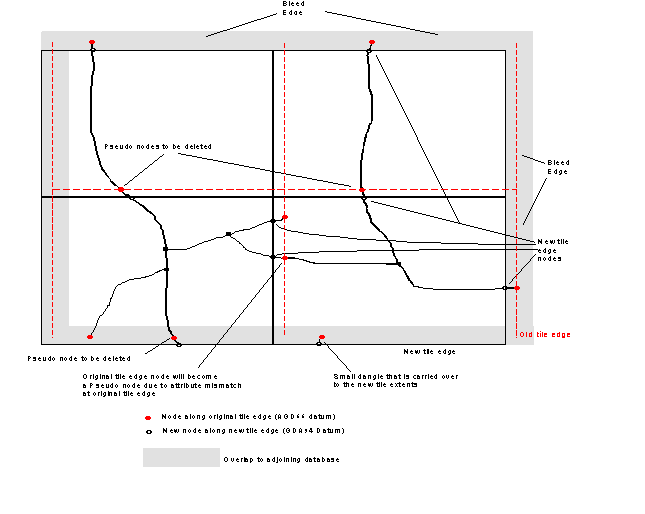
Where data is digitised from repromat or generated from AGD66 source material, data from the adjacent tiles to the south and west will need to be included to allow for the datum shift. This is illustrated by the diagram below:
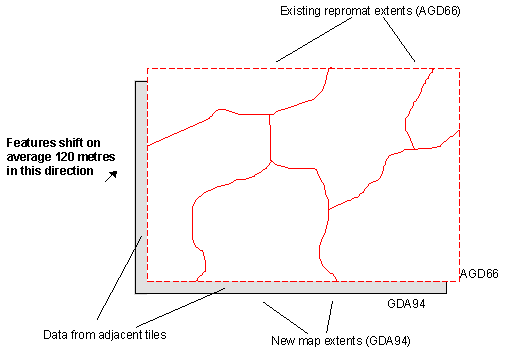
Graphical mismatches that were not resolved within source material/data will also manifest themselves within the new tile boundaries as shown below. These mismatches become internal to the tile when in the new datum, and must be resolved.
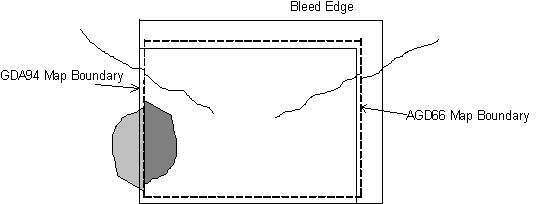
5.7 Direction of Digitising
For some features, such as cliffs, embankment and administration area boundaries the direction of digitising is important. For administration area boundaries the direction of digitising will be anti-clockwise, as shown in the following diagram. This will place the verge of the symbol on the correct side of the digitised line.
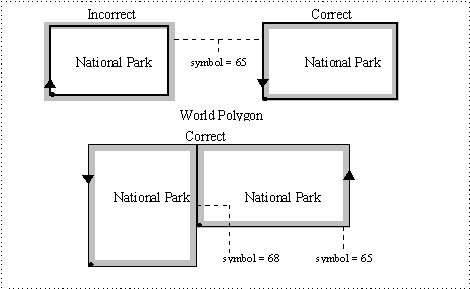
Where direction of digitising is used in symbology it is noted in the feature type dictionary, see Appendix A.
5.8 Feature Width Attribute
The feature width attribute is inbuilt into many representation symbols (eg Bridge Pt FeatWid 08 Orient 118). The feature width attribute may be used to control two aspects of symbology:
- The width of a symbol, where the attribute controls the line weight of the symbol, for example, the line weight of roads under construction.
- The internal gap between two sides of a symbol, where the attribute controls the distance between two elements of a symbol, for example the distance between the two sides of a bridge to accommodate road symbols of varying width.
Example:

The usage of the feature width attribute for particular features is given in Appendix A Feature Type Dictionary.
5.9 Orientation Attribute
The orientation attribute is inbuilt into many representation symbols (eg Bridge Pt FeatWid 08 Orient 118).The angle of orientation is anti-clockwise and as illustrated on the following diagram. The axis of oriented symbols is shown in Appendix S Symbol Dictionary.

The following diagram illustrates the effect of orientation on the plotting of a bridge symbol.

5.10 Type, Name and Text Note Attributes and Annotation Features
All type displayed on the face of the map will be stored as annotation features. Where the type relates to an entity feature, the text held in the blob element of the annotation feature must be consistent with the data stored in the relevant attributes of the entity. For example, description, height and TextNote attributes are all relevant attributes for a Vertical Obstruction - tower. Note: that the text that appears on the face of the map may be a combination of several attributes in the databases.
Annotation should not exist on the map face that is not associated with a feature contained within the digital data except where that annotation is a general descriptor of the area (e.g. 'numerous bores and wells').
Annotation should not exist on the map face when its associated feature is not symbolised (note: Polygons may be symbolised/represented by shading, by their boundary line or a combination of both). The following exceptions exist for this rule:
- Airports
- Dams (when coincident with roads)
- Fords
- Fences (non printing where follows state border or road)
- Grid Lines (when follows the central meridian)
- Localities (non-printing)
- Offshore rocks (in close proximity to lighthouses)
- Pipelines (non printing when adjacent to another pipeline)
- Waterfalls
- LargeAreaFeatures
Where the name attribute exists, it is used to store the name of a feature. The name must be stored against each spatial object making up the entity, unless otherwise stated in Appendix A Feature Type Dictionary. e.g. each chain along the course of a river.
TextNote is intended to provide additional textual information for the map face. The TextNote field will not duplicate text in other data attribute fields. Where previously the textnote may have replicated the feature type or status fields, it should now not do so, as annotation will be created directly from those fields or via scripting based on those fields. A TextNote should be applied to each feature requiring clarification on the map face regardless of whether the resultant derived annotation is generalised into a plural form (e.g. 3 landmark point features within close proximity in the data, should each have a TextNote "water capture net" but will result with a singular piece of generalised annotation on the map face "water capture nets"). Where the Map rules in Appendix A Feature Type Dictionary require or allow the naming of a feature and there is no name field the name will be held in the TextNote field. One TextNote or Name may be divided between two or more annotation features.
Examples:
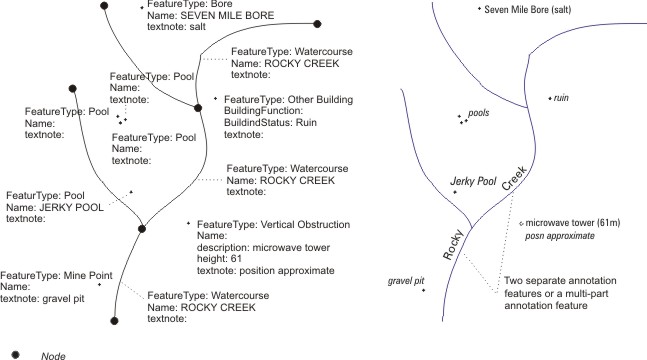
All attributes values should be stored in the casing indicated in Section 1 Chapter 3.8 Item formatting and attribution but all annotation derived from the attribute values should be in the casing indicated in the appropriate scale type specifications (as detailed at the bottom of the chapter). Where the casing differs from the attribute value to that specified for the associated annotation, this conversion will occur as annotation is generated. In the case of Vertical Obstruction features where the height is shown on the face of the map the abbreviation for metres ('m') will not be included in either the height or TextNote attributes rather this will be added when annotation is generated using available software or scripting. Parentheses will not be included in TextNotes. Where Parenthesis are required to separate two attribute values stored with the entity these will again be created as the annotation is generated. e.g. A vertical obstruction with a description field value of 'mast' and a height value of '56', will have a derived annotation of 'mast (56m)'.
For the NTDB, annotation will be held in the associated feature dataset annotation feature class for the applicable scale product e.g. DrainageAnno100K, CultureAnno250K etc. When Annotation is generated and loaded into the feature dataset annotation class it should be assigned the appropriate feature attribute value to designate its source feature class entity. Annotation derived for Map grid representation including those outside the neat line will be included in the CartographyAnno(Scale) feature class and assigned the feature 'Grids'. Annotation derived for Graticule representation including those outside the neat line will be included in the CartographyAnno(Scale) feature class and assigned the feature 'Graticules'.
For additional information on font and text sizes for annotation see Section 2:
- Chapter 9 (1:100 000 Scale Type Specifications);
- Chapter 10 (1:250 000 Scale Type Specifications);
- Chapter 11 (1:1 000 000 Scale Type Specifications);
- Chapter 12 (1:2 500 000 Scale Type Specifications);
- Chapter 13 (1:5 000 000 Scale Type Specifications); and
- Chapter 14 (1:10 000 000 Scale Type Specifications).
5.11 Spatial Coincidence
The spatial object for some feature types have a physical or assumed link to the spatial objects of other feature types in the database. There are four types of linkages:
- Cloned features
- Coincident features
- Node on Chord
- Vertex on Chord
5.11.1 Cloned features
A feature is cloned when its spatial attributes are to be exactly the same as those of another feature. Cloned features are of the same geometry type, that is, a line will be cloned to a line, a point to a point. The following table lists some example clone relationships. The data rules sections of the feature type dictionary indicate where a feature is cloned from another - see Appendix A.
| ORIGINAL FEATURE | CLONE OF ORIGINAL |
|---|---|
| Wharf Line | Sea Wall |
5.11.2 Coincident Features
Features are coincident when they share one or more coordinate pairs. For example, a point feature may need to be coincident with a linear feature, or two linear features may be coincident sharing a number of points. Point features may need to be coincident with a node rather than a vertex, for example a road junction needs to be coincident with the nodes of intersecting roads. Where linear features are coincident one line may leave the other part way down a chord. However, at the point where one line deviates from the other the vertex of the deviating line must be within one 1metre of the chord in both geographical and MGA coordinates.
Examples:
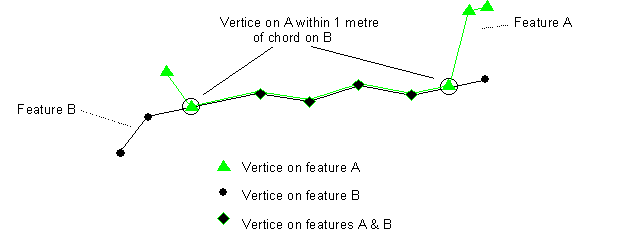
When point features are required to be coincident with a node in a line feature they must have exactly the same coordinates as the node in the line feature.
The following table lists some of these point-over-node coincidence relationships. The two inter-relationship rules sections of the feature type dictionary give a more complete listing of relationships - see Appendix A.
| LINEAR FEATURE WITH NODE | POINT FEATURE |
|---|---|
| Road | Road junction |
When point features are required to be coincident with a vertex in a line feature they must have exactly the same coordinates as the vertex in the line feature.
The following table lists some of these point-over-vertex coincidence relationships. The two inter-relationship rules sections of the feature type dictionary give a more complete listing of relationships - see Appendix A.
| LINEAR FEATURE WITH VERTEX | POINT FEATURE |
|---|---|
| Connector | Lock |
| Railway | Railway Station, Railway Siding Point, Railway Bridge Point, Railway Tunnel Point |
| Road | Road Bridge Point, Road Tunnel Point, Ford Point, Gate |
| Road | Populated Place |
| Watercourse Line | Waterhole, Waterfall |
| Road, Railway | Transition Point |
The following table lists some of the linear feature to linear feature relationships. The two inter-relationship rules sections of the feature type dictionary give a more complete listing of coincidence relationships - see Appendix A.
| ORIGINAL LINEAR FEATURE | COINCIDENT LINEAR FEATURE |
|---|---|
| Road | Road Bridge Line, Railway Overpass, Road Causeway, Road Tunnel Line |
| Railway | Railway Bridge Line, Railway Overpass, Railway Causeway, Railway Tunnel Line |
| Shoreline | Wharf Line, Sea Wall |
5.11.3 Node of Line Feature on Chord of another Line Feature
In the database, some features are required to end exactly on another. For instance, connectors are often required to end on a junction feature, even though the junction feature resides in a different layer. When one feature is required to end on another feature the coordinates of its end node are required to be exactly the same as the coordinates of a vertex in the cross feature.
The following diagram illustrates this relationship. The two inter-relationship rules sections of the feature type dictionary give a more complete listing of these relationships - see Appendix A.
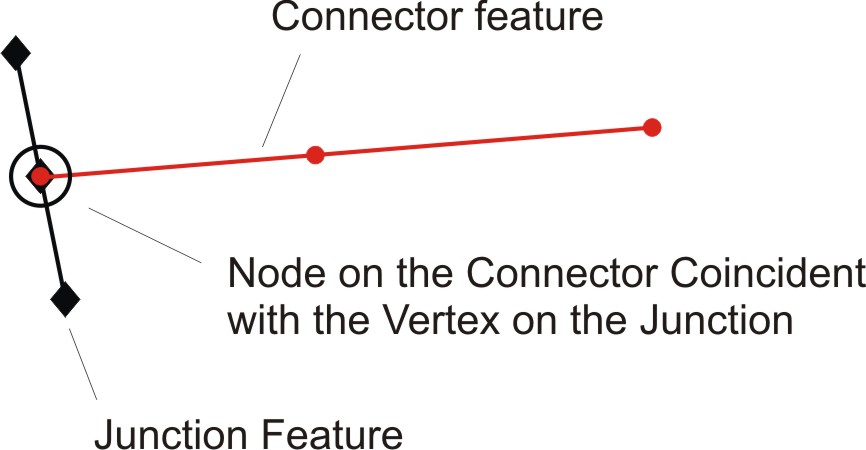
5.12 Nodes and Vertices on the Limit Of Data
Where the Limit Of Data forms a polygon boundary it is important that a node is present where the polygon meets the Limit Of Data
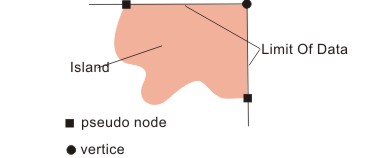
All Limit Of Data features should be densified so that there is a vertice at least every 0.002 degrees, which is approximately every 200 metres. Limit Of Data features in different layers will be coincident with each other where they overlap, such that their vertices are coincident.
5.13 Precision
For information on the Precision, Resolution and Tolerance of the NTDB refer to Section 1 3.3 Precision, Resolution and Tolerance
5.14 Maintaining Global IDs
Users of the database should not attempt to alter the entries within GlobalID fields, which are a proprietary ESRI Format.
The NTDB will use a Global Identifier (GlobalID) attribute to identify individual features inside the database.
The GlobalID will be assigned to each feature as the database is populated. The GlobalID will be maintained by the database functionality and will remain stable during attribute and spatial adjustments. The GlobalID consists of 36 characters enclosed in curly brackets (eg '{EB07A3A0-A7C3-4A84-AA29-BCE26FDA6838}').
During revision and maintenance processes, producers should not conduct actions which may cause the unnecessary loss of GlobalIDs. While producers must still meet topological, structural and attribute requirements, they should only make necessary modifications and not undertake automated processing which may alter the GlobalIDs, without any fundamental change to the resultant data. Valid changes include operations such as removing pseudo nodes, increased planimetric accuracy or improved attribute consistency or currency.
Loss of some GlobalIDs will be unavoidable when:
- Two or more features with different GlobalIDs are combined into one feature. (One GlobalID will be retained in this case)
- A single feature is split into two or more features.(The GlobalID will be retained generally on the larger feature and a new GlobalID will be produced for the lesser feature)
- A feature changes feature class.
- When a feature is deleted
5.15 Printing and Non-printing Features
The determination of whether a feature will be printed on a map is defined by a series of factors, which include:
- Whether the feature is applicable to the specific map product type as specified in the 'Related Products' entry of Appendix A - Feature Type Dictionary
- Whether a feature has an attribute value in the 'Restrictions' field defining it as acceptable for NMI Map Products, see Section 3 Chapter 5.20 Restrictions on Data Use
- Whether a feature meets the minimum size criteria for 'Map Representation', see Appendix A - Feature Type Dictionary Layout
- Whether a feature has been assigned an applicable UPPERSCALE value as appropriate, see Section 3 Chapter 5.3 Cartographic Generalisation, Selection and Overlap
- Whether a feature has been assigned symbol number other than Polygon/Line/Point No Draw
- Whether the symbology of polygon edge as defined by 5.19 Symbology of Polygon Edges permits it to be printed
- Whether the feature is masked by another, see Section 2 Chapter 2.9 Masking
For more information of on printing orders see Appendix W - Map Printing Orders.
5.16 Merging Features
Merging of features should occur when all attributes other than those listed below are identical and the features are adjacent (touching):
- MapNumber (unless related to a cartographic feature)
- FeatureReliability
- FeatureSource
- AttributeReliability
- AttributeSource
- PlanimentricAccuracy
- ElevationAccuracy
- Source
- Revised
- GlobalID
- EDITCODE (Note: This attribute may not be supplied for NTDBs production purposes)
When two features are merged to form a single feature the following items will be populated with the values held in the component feature with the most recent FeatureReliability Date:
- FeatureReliability
- FeatureSource
- AttributeReliability
- AttributeSource
- PlanimentricAccuracy
- ElevationAccuracy
- Source
The following items will be given a NULL value when merged:
- EDITCODE
The following items will be updated automatically either at the time of the merge if connected to the SDE Environment or upon reconciliation with the SDE Environment if disconnected during the editing process:
- Revised
- GlobalID
- EDITCODE
5.16.1 Creating Multi-part Features
The NTDB functionality has the capacity to group multiple disparate entities of the same geometry into a single feature. While previous versions of the specifications accepted multi-part polygon features for certain feature classes, no multi-part features are acceptable in the version 6 NTDB.
5.17 Polygon bounding lines
Where boundary lines are applicable to the NTDB (eg FrameworkBoundaries such as shoreline, junction, stateborder and Limit of data), they must be an exact clone of the polygon edge to which they surround.
For the NTDB, no boundary line priorities need to be set for the FrameworkBoundaries as all boundary lines within these feature classes follow their defined purpose (see Appendix A - Feature Type Dictionary - Framework).
5.18 Defined Holes in Polygon Feature Types
Polygon features may contain holes or voids, which cannot be assigned to any Feature Class within that Feature Dataset.
For example:
1. An isolated area of dry land which is fully surrounded by, or contained within, a Lake feature type polygon in the Waterbodies feature dataset.
2. An isolated area of dry land which is fully surrounded by, or contained between , two or more polygons within the Waterbodies feature dataset such as a Lake and a Saline Coastal Flat.
These empty areas, within or fully surrounded by polygons, are collectively known as defined holes (areas of universe polygon) in polygons in the NTDB. For the NTDB, these empty areas must meet a size criterion as prescribed in the following table before they may be included or captured as a defined hole in a polygon feature type.
In the tables below, Capture means 'Data Capture and Map Representation'. For more information on the difference between minimum size for 'Inclusion' vs 'Data Capture and Map Representation' see 'Appendix A - The Feature Type Dictionary Layout 2. Structure of an Entry'
| Feature Dataset | Minimum Size Criteria for Inclusion (Area sq m) |
Minimum Size Criteria for 25K Capture (Area sq m) |
Minimum Size Criteria for 100K Capture (Area sq m) |
Minimum Size Criteria for 250K Capture (Area sq m) |
Qualifications |
|---|---|---|---|---|---|
| Administration | 0 | 0 | 62500 | 390625 | This size criteria applies to universe polygons within a Defence and Prohibited (feature type) polygon. No size criteria exists for universe polygon contained between a Defence and Prohibited (feature type) polygon and another Administration Area (feature class) polygon. |
| Administration | 0 | 0 | 40000 | 250000 | This size criteria applies to universe polygons within an AdministrationAreas (feature class) polygon with the exception of the Defence and Prohibited feature type. No size criteria exists for universe polygon contained between a Defence and Prohibited (feature type) polygon and another AdministrationArea (feature class) polygon. |
| Aviation | 0 | 0 | 0 | N/A | |
| Cartography | 0 | 0 | 0 | N/A | |
| Culture (Cemetery Area feature type polygon) |
N/A | N/A | N/A | N/A | No areas of universe polygons should exist within Cemetery Areas other than those required to complete empty areas created by polygons which can not overlap as defined in the interrelationship rules in Appendix A. When used for this purpose the minimum size will be that of the feature that creates the hole. |
| Culture (except Cemetery Area feature type polygon) |
1406 | 1406 | 22500 | 390625 | This size criteria applies to universe polygons within a Culture feature dataset polygon other than Cemetery Areas. In addition, defined holes will be required to complete empty areas created by polygons which can not overlap as defined in the interrelationship rules in Appendix A. When used for this purpose the minimum size will be that of the feature that creates the hole. |
| Framework | N/A | N/A | N/A | N/A | No universe polygon is allowed within the defined extent of the NTDB. |
| FrameworkMIL | N/A | N/A | N/A | N/A | No universe polygon is allowed within the defined extent of the NTDB. |
| Habitation | 3906 | 3906 | 62500 | 390625 | No universe polygon is allowed within Building Area feature type polygons. This size criteria applies to universe polygons within a Built Up Area feature type polygon. In addition, defined holes will be required to complete empty areas created by polygons which can not overlap as defined in the interrelationship rules in Appendix A. When used for this purpose the minimum size will be that of the feature that creates the hole. For example 1406 sq m at 1:100 000 if the void is created by an existing cemetery area. |
| Industry | 625 | 625 | 10000 | 62500 | This size criteria applies to universe polygons within a Industry feature dataset polygons. In addition, defined holes will be required to complete empty areas created by polygons which can not overlap as defined in the interrelationship rules in Appendix A. When used for this purpose the minimum size will be that of the feature that creates the hole. For example 1406 sq m at 1:100 000 if the void is created by an existing cemetery area. |
| Marine | 0 | 0 | 0 | 0 | |
| Physiography | 625 | 625 | 10000 | 62500 | This size criteria applies to universe polygons within a Physiography feature dataset polygons. In addition, defined holes will be required to complete empty areas created by polygons which can not overlap as defined in the interrelationship rules in Appendix A. When used for this purpose the minimum size will be that of the feature that creates the hole. For example 1406 sq m at 1:100 000 if the void is created by an existing cemetery area. |
| Production | N/A | N/A | N/A | N/A | |
| Relief | N/A | N/A | N/A | N/A | Complete polygon coverage must exist over land features (Mainland and Island feature types) in the NTDB |
| Spatial Index | N/A | N/A | N/A | N/A | |
| Vegetation (except Mangrove feature type polygon) |
2500 | 2500 | 40000 | 250000 | This size criteria applies to universe polygons within a Vegetation feature dataset polygons except the Mangrove feature type polygon. In addition, defined holes will be required to complete empty areas created by polygons which can not overlap as defined in the interrelationship rules in Appendix A. When used for this purpose the minimum size will be that of the feature that creates the hole. For example 625 sq m at 1:100 000 if the hole is created by an existing building area (ruin). |
| Vegetation (Mangrove feature type polygon) |
625 | 625 | 10000 | 62500 | This size criteria applies to universe polygons within the Mangrove feature type polygon. In addition, defined holes will be required to complete empty areas created by polygons which can not overlap as defined in the interrelationship rules in Appendix A. When used for this purpose the minimum size will be that of the feature that creates the hole. For example 625 sq m at 1:100 000 if the hole is created by an existing building area (ruin). |
| Waterbodies | 625 | 625 | 10000 | 62500 | This feature will be used for areas of dry land contained or surrounded by waterbody polygons. This size criteria applies to universe polygons within the Waterbodies feature dataset polygon. In addition, defined holes will be required to complete empty areas created by polygons which can not overlap as defined in the interrelationship rules in Appendix A. When used for this purpose the minimum size will be that of the feature that creates the hole. For example 3906 sq m at 1:100 000 if the hole is created by an existing deformation area feature class polygon). |
| Feature Dataset | Minimum Size Criteria for 1M Capture (Area sq m) |
Minimum Size Criteria for 2.5M Capture (Area sq m) |
Minimum Size Criteria for 5M Capture (Area sq m) |
Minimum Size Criteria for 10M Capture (Area sq m) |
Qualifications |
|---|---|---|---|---|---|
| Aviation | 0 | N/A | N/A | N/A | |
| Culture (except Cemetery Area feature type polygon) |
2250000 | NA | NA | NA | This size criteria applies to universe polygons within a Culture feature dataset polygon other than Cemetery Areas. In addition, defined holes will be required to complete empty areas created by polygons which can not overlap as defined in the interrelationship rules in Appendix A. When used for this purpose the minimum size will be that of the feature that creates the hole. |
| Framework | N/A | N/A | N/A | N/A | No universe polygon is allowed within the defined extent of the NTDB. |
| FrameworkMIL | N/A | N/A | N/A | N/A | No universe polygon is allowed within the defined extent of the NTDB. |
| Habitation | 2250000 | 14062500 | NA | NA | No universe polygon is allowed within Building Area feature type polygons. This size criteria applies to universe polygons within a Built Up Area feature type polygon. In addition, defined holes will be required to complete empty areas created by polygons which can not overlap as defined in the interrelationship rules in Appendix A. When used for this purpose the minimum size will be that of the feature that creates the hole. For example 1406 sq m at 1:100 000 if the void is created by an existing cemetery area. |
| Industry | 1000000 | 6250000 | NA | NA | This size criteria applies to universe polygons within a Industry feature dataset polygons. In addition, defined holes will be required to complete empty areas created by polygons which can not overlap as defined in the interrelationship rules in Appendix A. When used for this purpose the minimum size will be that of the feature that creates the hole. For example 1406 sq m at 1:100 000 if the void is created by an existing cemetery area. |
| Marine | 0 | 0 | 0 | 0 | |
| Physiography | 1000000 | NA | NA | NA | This size criteria applies to universe polygons within a Physiography feature dataset polygons. In addition, defined holes will be required to complete empty areas created by polygons which can not overlap as defined in the interrelationship rules in Appendix A. When used for this purpose the minimum size will be that of the feature that creates the hole. For example 1406 sq m at 1:100 000 if the void is created by an existing cemetery area. |
| Production | N/A | N/A | N/A | N/A | |
| Relief | N/A | N/A | N/A | N/A | Complete polygon coverage must exist over land features (Mainland and Island feature types) in the NTDB |
| Spatial Index | N/A | N/A | N/A | N/A | |
| Vegetation (Mangrove feature type polygon) |
1000000 | 6250000 | 25000000 | NA | This size criteria applies to universe polygons within the Mangrove feature type polygon. In addition, defined holes will be required to complete empty areas created by polygons which can not overlap as defined in the interrelationship rules in Appendix A. When used for this purpose the minimum size will be that of the feature that creates the hole. For example 625 sq m at 1:100 000 if the hole is created by an existing building area (ruin). |
| Waterbodies | 1000000 | 6250000 | 25000000 | 100000000 | This feature will be used for areas of dry land contained or surrounded by waterbody polygons. This size criteria applies to universe polygons within the Waterbodies feature dataset polygon. In addition, defined holes will be required to complete empty areas created by polygons which can not overlap as defined in the interrelationship rules in Appendix A. When used for this purpose the minimum size will be that of the feature that creates the hole. For example 3906 sq m at 1:100 000 if the hole is created by an existing deformation area feature class polygon). |
5.19 Symbology of Polygon Edges
In the NTDB many feature datasets do not have defined boundary line feature types and therefore the application of symbology around the boundaries of polygons for map production purposes is defined by a combination of the polygon symbol and the table in this chapter.
The following tables define the symbology hierarchy in priority order (from highest to lowest) for polygon edges based upon the polygons to which they are adjacent. Where two Datasets are categorised together, the boundary is influenced by both datasets. When the polygon symbol incorporates the polygon boundary symbol it does not infer that the entire boundary will be shown, this will still depend on the table below. For example, if producing a 100K NTMS from NTDB the shared boundary between Built Up Area and Landmark Area (with symbol 63) will not be shown as the Built Up Area boundary hierarchy is higher in the list.
Note: The symbology of polygon edges for the Administration feature dataset is not included in the table below as all edge symbology will be represented on the map face with no hierarchy applied
Feature Dataset : Aviation
| Boundary Symbol No. |
Polygon Symbol No. |
Feature Class Polygon | Qualifications |
|---|---|---|---|
| 702 | 700 | AircraftFacilityAreas (Runway) | |
| 0 | 0 | AirportAreas | |
| 0 | 0 | AircraftFacilityAreas (Apron) |
Feature Dataset : Culture & Habitation
| Boundary Symbol No. |
Polygon Symbol No. |
Feature Class Polygon | Qualifications |
|---|---|---|---|
| 0 | 420 | Built Up Area | |
| 0 | 24 | Recreation Area | |
| 0 | 26 | Building Area - Operational | |
| 170 | 170 | Waste Management Area | Note: Boundary line symbol 170 is incorporated as part of the 170 polygon symbol for Waste Management Area. Symbols 170 (bounding Waste Management Area) will be masked out by symbolised linear features such as roads. Symbols 170 (bounding Waste Management Area) will be masked where black type unavoidably overprints the feature. The break measurement will be 0.2mm on either side of the type where it crosses the feature. (Note: the feature will be masked only on the map and will be complete in the data). |
| 60 | 60 | Cemetery Area | Note: Boundary line symbol 60 is incorporated as part of the 60 polygon symbol for Cemetery Area. Symbols 60 (bounding Cemetery) will be masked out by symbolised linear features such as roads. Symbols 60 (bounding Cemetery) will be masked where black type unavoidably overprints the feature. The break measurement will be 0.2mm on either side of the type where it crosses the feature. (Note: the feature will be masked only on the map and will be complete in the data). |
| 60 | 60 | Building Area - Ruin | Note: Boundary line symbol 60 is incorporated as part of the 60 polygon symbol for Cemetery Area. Symbols 60 (bounding Building Area - Ruin) will be masked where black type unavoidably overprints the feature. The break measurement will be 0.2mm on either side of the type where it crosses the feature. (Note: the feature will be masked only on the map and will be complete in the data). |
| 63 | 63 | Landmark Area | Note: Boundary line symbol 63 is incorporated as part of the 63 polygon symbol for Landmark Area. Bounding Landmark Area with description Agricultural Production (see map rules), Intensive Agricultural Production (see map rules), Landmark Area General, Scientific Facility |
| 0 | 0 | Landmark Area | Bounding Landmark Area with description Agricultural Production (see map rules), Educational Institution, Hospital, Intensive Agricultural Production (see map rules), Power Generation Facility |
Feature Dataset : Industry
| Boundary Symbol No. |
Polygon Symbol No. |
Feature Class Polygon | Qualifications |
|---|---|---|---|
| 102 | 102 | Mine Area | Note: Boundary line symbol 102 is incorporated as part of the 102 polygon symbol for Mine Area. Symbol 102 (bounding Mine Areas) will be masked where black type unavoidably overprints the Feature. The break measurement will be 0.2 mm on either side of the type where it crosses the feature. (Note: the feature will be masked only on the map and will be complete in the data.) |
Feature Dataset : Marine
| Boundary Symbol No. |
Polygon Symbol No. |
Feature Class Polygon | Qualifications |
|---|---|---|---|
| 0 | 97 | Marine Hazard Area -Reef | |
| 0 | 22 | ForeshoreFlats | |
| 95 | 95 | Marine Hazard Area - Shoal | Note: Boundary line symbol 95 is incorporated as part of the 95 polygon symbol for Shoal. |
Feature Dataset : Physiography
| Boundary Symbol No. |
Polygon Symbol No. |
Feature Class Polygon | Qualifications |
|---|---|---|---|
| 0 | 22 | Sands - Sand Area | |
| 0 | 25 | Sands - Sand Dune | |
| 90 | 900 | DeformationAreas - Distorted Surface | Note: Boundary line symbol 90 is incorporated as part of the 900 polygon symbol for Distorted Surface. Symbol 90 (DeformationAreas - Distorted Surface), will be masked where black type unavoidably overprints the Feature. The break measurement will be 0.2 mm on either side of the type where it crosses the feature. (Note: the feature will be masked only on the map and will be complete in the data.) |
| 912 | 912 | DeformationAreas - Outcrop | Note: Boundary line symbol 912 is incorporated as part of the 912 polygon symbol for Outcrop. Symbol 912 (DeformationAreas - Outcrop), will be masked where black type unavoidably overprints the Feature. The break measurement will be 0.2 mm on either side of the type where it crosses the feature. (Note: the feature will be masked only on the map and will be complete in the data.) |
| 90 | 901 | Craters | Note: Boundary line symbol 90 is incorporated as part of the 901 polygon symbol for Crater. Symbol 90 (bounding Craters), will be masked where black type unavoidably overprints the Feature. The break measurement will be 0.2 mm on either side of the type where it crosses the feature. (Note: the feature will be masked only on the map and will be complete in the data.) |
Feature Dataset : Vegetation
| Boundary Symbol No. |
Polygon Symbol No. |
Feature Class Polygon | Qualifications |
|---|---|---|---|
| 0 | 2 | Forest or Shrub (250K and Closed 25K 100K) | |
| 0 | 201 | Forest Or Shrub - Sparse (25K and 100K Only) | |
| 0 | 200 | Forest Or Shrub - Dense (25K and 100K Only) | |
| 0 | 7 | Mangrove | |
| 0 | 4 | Rainforest | |
| 0 | 4 | Rainforest | |
| 0 | 5 | Cultivated Areas - Orchard | |
| 0 | 6 | Cultivated Areas - Plantation (All Scales) | |
| 0 | 600 | Cultivated Areas - Plantation (25K and 100K only) |
5.20 Restrictions on Data Use
A restriction categorisation may need to be applied to certain features to ensure Geoscience Australia does not compromise any licence or contractual agreements with data suppliers or Geoscience Australia Stakeholders. In additional the restrictions field allows for individual landowners, councils or government departments to supply information for emergency management or governmental requirements with confidence that it will not then be available for public consumption. Some examples of these may be:
- A landowner requesting that a road on his property is not placed on maps or supplied to the public but is open to it being used for all governmental purpose: Whole of Govt Only
- Data supplied from the defence department relating to defence facilities: NMI Use for 3rd Party
- Data supplied from private/commercial companies, to which licence agreements state data can not be on-supplied without alteration but data can be used to produce NMI maps: NMI Only plus NMI Map Products
A production note should be placed in the database in the vicinity of the restricted data to supply Geoscience Australia with additional information on the restriction details. In the future a database will be developed detailing locations of restricted data and details on those restrictions.
When data is altered to such an extent as it breaks the licence agreement constraints, its restricted status would be reviewed to a lower level e.g public access.
The below Restrictions are based on the spatial representation of the feature. Restrictions on Attribute release would be based on documentation of individual layers.
| Restrictions | Definition of Use |
|---|---|
| NMI Only | This data is available for use in NMI only it can not be distributed, published and/or its existence acknowledged in digital form. |
| NMI Only plus NMI Map Products | This data is available for use in NMI only it can not be distributed, published and/or its existence acknowledged in digital form. The data is restricted in its use but can appear in map form for NMI products |
| NMI Use for 3rd Party | This data is available for NMI Use in producing 3rd Party Products including customised requests by HEMA, Customs, Emergency Management or individual State Agencies. |
| NMI Use for 3rd Party plus NMI Map Products | This data is available for NMI Use in producing 3rd Party Products including customised requests by HEMA, Customs, Emergency Management or individual State Agencies. The data is restricted in its use but can appear in map form for NMI products |
| Geoscience Australia Only | This data is only available for use within Geoscience Australia. |
| Geoscience Australia plus NMI Map Products | This data is only available for use within Geoscience Australia. The data is restricted in its use but can appear in map form for NMI products. |
| Australian Federal Govt Only | The data is available for use for all Federal Government activities only. |
| Australian Federal Govt plus NMI Map Products | The data is available for use for all Federal Government activities only. The data is restricted in its use but can appear in map form for NMI products |
| Whole of Govt Only | This data is available for use for all local, State and Federal Government activities including EM |
| Whole of Govt plus NMI Map Products | This data is available for use for all local, State and Federal Government activities including EM. The data is restricted in its use but can appear in map form for NMI products |
| Public Access | Unrestricted use for data and map production distribution in the public arena |
6. Feature Specific Notes
6.1 Limit Of Data
The 'Limit Of Data' feature in the NTDB defines the spatial extents and limit of known data. 'Tile Edge' features in the GEODATA product which have been retained in the NTDBs after the edge matching process (due to non-resolution of the spatial or attribute mismatches while populating the NTDB) have been converted to the Limit Of Data feature type in applicable boundary line feature classes. The position of the Limit Of Data will be variable according to the source material received. The Limit Of Data feature will be used to bound and close off polygons which meet the limit of known source data (Including the edges of the NTDBs).
6.2 Contours and Hypsometric Areas
Contours are to be attributed with one of the following subtypes:
| Type | Subtype Description | USAGE |
|---|---|---|
| 1 | Connector Discontinuity | To be used for Contours added to the data where contours on the repromat were broken for either a cliff, cutting, embankment or razorback symbol. |
| 2 | Connector Standard | To be used for Contours where the contour's position is not known, for example in a Watercourse Area, Salt Evaporators, Settling Ponds, Aquaculture Area, Canal Area or Rapid Area |
| 3 | Depression Contour | To be used for depression Contours. |
| 4 | Interpolated Contour | To be used to join broken Contours or to replace a Contour absent in the source material for cartographic reasons (where not associated with a feature from the discontinuity feature class). |
| 5 | Standard Contour | To be used for standard (not depression) Contours. |
| 6 | Limit Of Data | To be used to close hypsometric areas where they touch the edge of either known data (and can not be closed by using an interpolated contour) or the edge of the defined NTDBs. |
| 7 | Auxiliary Contour | See Appendix A, Not to be used in connection with Hypsometric Areas. |
Hypsometric areas will be defined as the areas in between consecutive contours (with the exception of auxiliary contours) and will carry the elevation of the lowest contour bounding the polygon. Hypsometric areas will not cover the sea and no voids apply to it, for instance, lakes do not form voids in hypsometric areas.
The coastline, including junctions, will be considered to be the 0 metre contour, i.e. it will be cloned as the 0 metre contour. The contours resulting from cloning coastal junctions will be attributed as "connector standard", other 0 metre contours along the coastline will be attributed as "standard". Depression contours will be used for closed contours bounding or on the slope of a depression. Standard contours will be used for areas of higher land within a depression.
6.2.1 Connectors Discontinuity
A contour that is broken by a cliff, cutting, embankment or razorback will be re-connected by a Connector Discontinuity.
When connectors for these features are required, they will be treated in a similar manner to the following cliff situation. If more than one contour is broken by a cliff then the associated connectors must not intersect or overlap, but rather be offset from one another by a minimum of 5 metres.
For features within the Contours250K feature class these connectors will be within 75 metres of the cliff feature on the downslope side and within 25 metres on the upslope side. For features within the Contours100K feature class these connectors will be within 30 metres of the cliff feature on the downslope side and within 10 metres on the upslope side.
There are two different Cliff situations, coastal Cliffs and inland Cliffs. The method of dealing with each are detailed below.
6.2.1.1 Coastal Cliffs
Coastal Cliffs are relatively straightforward compared to inland Cliffs. Where a Cliff is cloned to the coastline (zero elevation Contour), all ascending Contours entering that Cliff should be staggered inland from the coast by approximately 5m each. The diagram below illustrates the correct representation of the Contours entering a Cliff edge at the coastline. Note how the Contours do not intersect or overlap at any point.
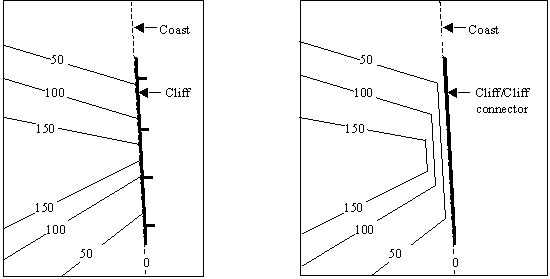
Above: Representation on Previous Map; Representation in Data
Note: The horizontal separation between the Cliff connectors should be approx. 5m (at scale).
6.2.1.2 Inland Cliffs
Inland Cliffs differ from coastal Cliffs as the Connector Discontinuity with the highest elevation value should always be coincident with the Cliff feature in the physiography feature dataset. All descending Contours entering that Cliff should have their Connector Discontinuities staggered downslope by approximately 5m each. The below diagrams illustrate the correct representation of the Contours entering an inland Cliff in a variety of situations. Note how the Contours do not intersect each other.
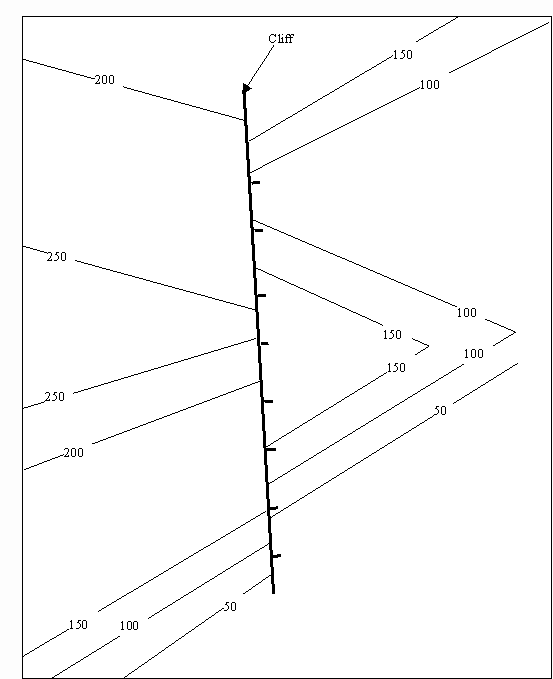
Above: Representation on Previous Map;
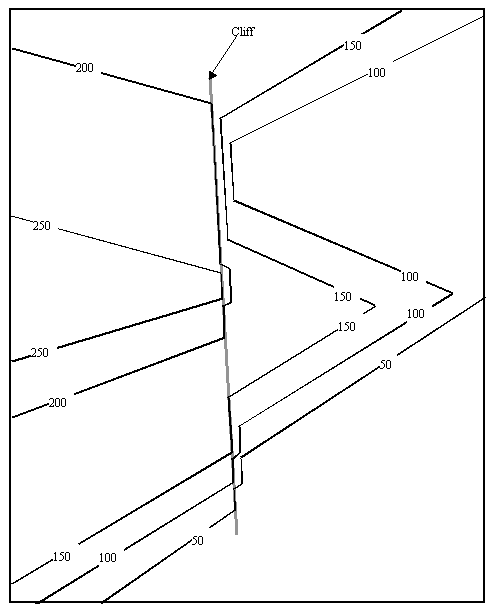
Above: Representation in Data
Note: The horizontal separation between the Cliff connectors should be approx. 5m (at scale).
The only deviation from the above cases is when Contours pass directly through the Cliffs. If Contours pass through Cliffs without aligning to them for any length of time they should be maintained as such and not edited in any manner.
6.2.2 Contours and Perennial Waterbodies
If contour features pass through perennial lake or reservoir (feature class) polygons, the corrective action required is dependant on one of the 3 cases as represented in the diagram below.
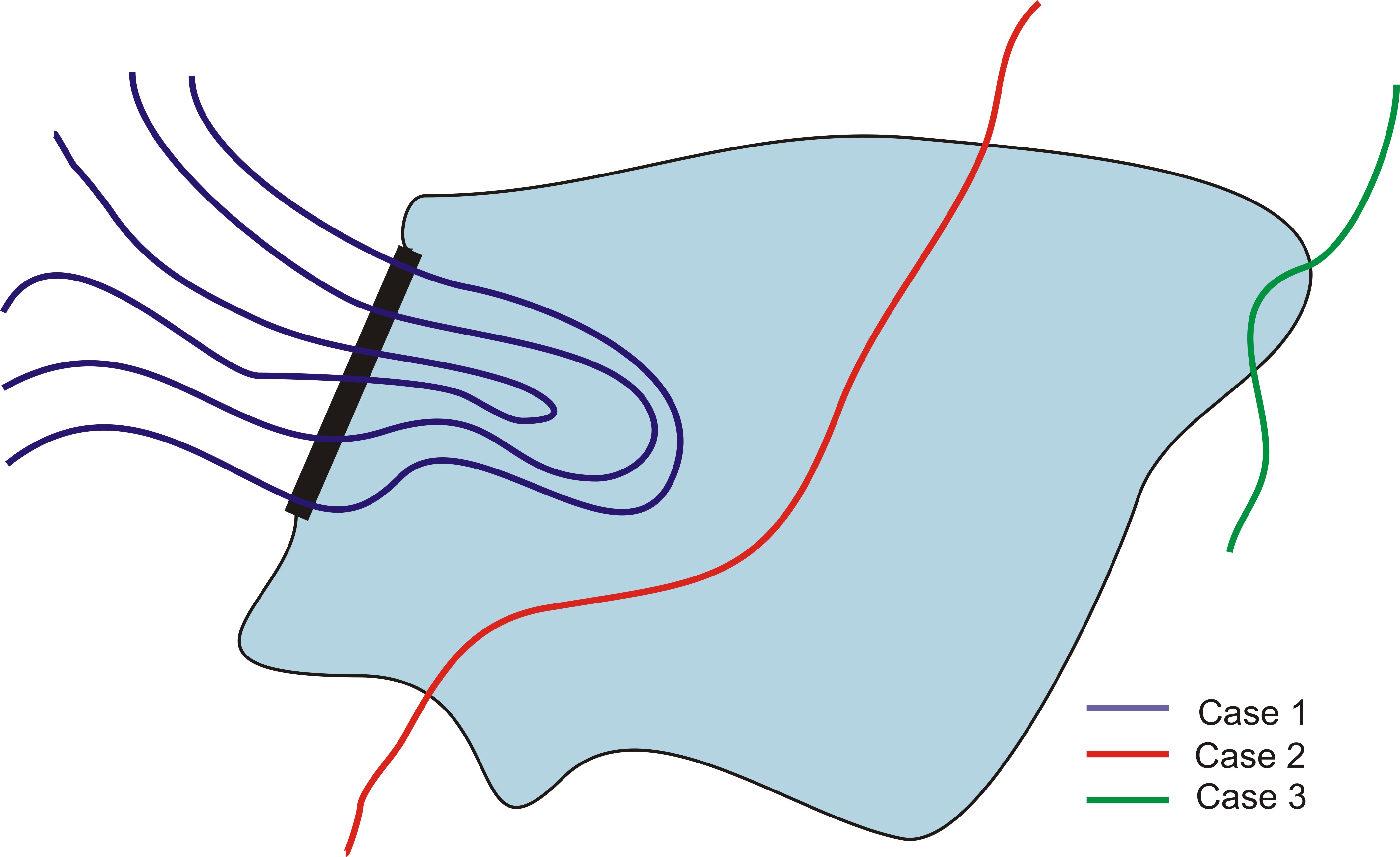
For Case 1 , the contours approaching from below the dam should be interpolated across the dam wall, if one exists. Where contours run up to a dam wall from below, the highest contour will be made coincident with the portion of the dam wall required to complete the contour connection (i.e. contours will not enter the waterbody). The section that runs across will be a non printing interpolated contour. A similar approach will be taken as per contour/cliff relationship. Each lower elevation contour subsequently broken by the dam, will also be joined by a non printing interpolated contour that is parallel to, and offset from the higher elevation contour.
For Case 2 , source imagery or ortho-photography provided should be investigated to determine the landform of the area. Contour should be logically adjusted in accordance with the landform, where possible. The portion of contour altered should be reclassified as an interpolated contour. The interpolated contour will be symbolised as per the abutting sections of contours.
If the resolution of imagery or ortho-photography is not sufficient to provide a clear direction, an action request should be sent to Geoscience Australia, seeking guidance.
For Case 3 , the contour will be realigned outside the waterbody using source imagery provided, and the portion of contour altered should be reclassified as an interpolated contour. The interpolated contour will be symbolised as per the abutting sections of contours.
6.3 Cleared Areas within Vegetation
The polygon edges surrounding Forest Or Shrub areas will be highly detailed, showing the convolutions of the edge of the Woody Vegetation, given that the segment length of the boundary may approach but not be less than 25 metres at 1:250 000 scale and 10 metres at 1:100 000.
6.4 Kilometric Distance Indicators
Kilometric distance indicators and the associated distances will be placed to avoid ambiguity and allow the calculation of route distances. Particular care should be taken around the map edges with the placement of kilometric distance indicators. Placement of indicators should be consistent between adjacent sheets and allow calculation of distances to continue from one sheet to another.
1:250 000 map distance measurement
A Kilometric Distance Indicator will be placed at the intersection of the road and the neatline on the south and west edges when associated with a destination arrow. For the north and east edges, a Kilometric Distance Indicator will be placed at the intersection of the road and the graticule line at the inner edge of the map bleed, and preferably will be aligned so that the symbol falls within the bleed edge. Where there is a destination to be indicated within the bleed edge, a road distance will be given to that destination from the graticule line. A MapNumber associated with a Kilometric Distance Indicator will not need to be maintained at 1:250 000.
1:100 000 map distance measurement
A Kilometric Distance Indicator will be placed at the intersection of the road and the neatline for all map edges when associated with a destination arrow, and aligned so that the symbol falls within the map sheet. A MapNumber associated with a Kilometric Distance Indicator will only be maintained for those Kilometric Distance Indicators falling on a neatline.
1:250 000 Scale example: 1:100 000 Scale example: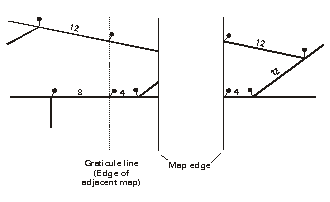
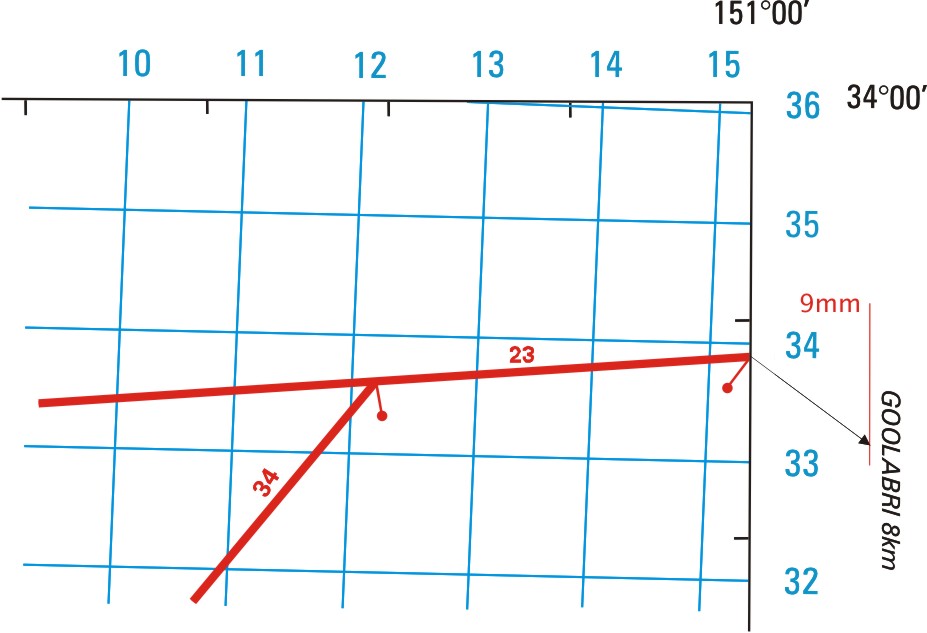
6.5 Place Names and Populated Places
All place names or populated places appearing in the base material/digital data or existing in the NTDB prior to revision/maintenance will be included/retained in the NTDB unless there is clear evidence the named feature no longer exists.
The following diagram illustrates how large built up areas generally have within their extents one or more localities of type "place name".
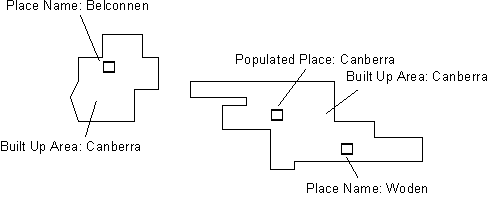
6.6 Mountains, Spot Elevations and Horizontal Control Points
Mountains, Spot Elevations And Horizontal Control Points may appear in close proximity (within a distance of 1mm at map scale from one another) when first extracted from the reference data. When this occurs the following rules will be applied.
Mountains will be left in their current location. The name of the mountain will be shown on the map in preference to the alpha-numeric code for the horizontal control point. The mountain will have a symbol number of 2 - Point No Draw.
Where a horizontal control point and a spot elevation are in close proximity to one another and have the same elevation to the nearest metre, the spot elevation will be moved to have the same location as the horizontal control point and the spot elevation will have a symbol number of 2 - Point No Draw.
Where a horizontal control point and a spot elevation are in close proximity to one another but the elevations differ by more than a metre, their respective positions will be maintained. Normally the spot elevation will have a symbol number of 2 - Point No Draw and the elevation of the horizontal control point will be shown. However, if the spot elevation is the highest elevation on the map or is higher than the horizontal control point by more than half a standard contour interval (eg 25 metres at 1:250 000), the spot elevation will be symbolised and its elevation shown on the map and the horizontal control point will have a symbol number of 2 - Point No Draw.
Where a horizontal control point and a bench mark are in close proximity to one another, the bench mark will have a symbol number of 2 - Point No Draw.
Where a vertical obstruction feature lies in close proximity to a horizontal control point, bench mark, spot elevation or symbolised mountain, the vertical obstruction feature has precedence and will be the only symbol shown, unless the spot elevation is the highest spot elevation on the map.
6.6.1 Spot Elevations
Where shoreline is realigned during revision, resultant spot elevations which fall into the sea, shall not be captured/retained in the NTDB.
Reference will also be made to the latest previous edition map when not produced by Geoscience Australia. If as a result of comparison significant logical anomalies are found which may influence map users perception of the topography of the area clarification should be sought from Geoscience Australia (e.g. If there are values higher on the latest previous edition map which have a difference greater than 5m or when inconsistencies with contours would result).
In addition, spot elevations representing locality mountains of a known height on the previous edition maps for each scale should be included/retained within the NTDB.
Any significant spot elevation anomalies should be referred back to Geoscience Australia.
All remaining statements in the following chapter relate to the cartographic selection of features for scale-specific data/map products. All spot elevations will be considered acceptable for at least 1:100 000 (Upperscale Value) unless large anomalies are found against Geoscience Australia's Digital Surface Model, where this occurs the spot elevations affected will be given an Upperscale of 25 000 and a USCertainity of definite. For Spot elevations acceptable at 100 000 the selections below will be used to define whether the feature will be symbolised on map products (eg SYMBOL100K of 52). For 250 000 and smaller scales (larger extents), the selections detailed below will be used to define the Upperscale and USCertainity values for each entity but whether a feature will be symbolised will be determined by its inter-relationships with surrounding entities.
Spot elevations will be selected to best show terrain shape, change of slope and high and low points. In any group of related features (ridges peaks or saddles) the highest elevation shall be shown. The density of the spot elevations selected will not be reduced from that on the latest previous edition map. (This overrides all other rules and applies when the latest previous edition map of the equivalent scale has been provided to the producers.)
Preference will be given in descending order to elevations that are:
- closest to Mountains and in an isolation (i.e. enclosed by a contour);
- closest to Aircraft Facilities;
- in isolations;
- greater than half the contour interval above the next lower contour;
- in depressions
- on cliffs or razorbacks
- on sand ridges
The selection that is made should be compatible with the contour features.
For each scale, all occurrences of the highest Spot elevation in each of the standard map sheets for that scale (eg when defining Upperscale Values of 1:250 000 the highest spot elevation in each of the standard 1:250 000 NTMS map sheets) will be included in the selection. Where two or more occurrences of the highest Spot elevation exist on the same sheet and are less than 12mm apart only one will be included. Where possible, the highest spot elevation per larger scale (smaller area) map sheets should be retained as a priority when filtering selections for smaller scale (larger area) products.
Spot elevations selected will be no less than 12 mm apart at map scale. Spot elevations selected should be no more than 64 mm apart at map scale where points meeting the above criteria are available in the source data.
Spot elevations that have the same elevation as a contour will not be selected. Should the highest Spot elevation have the same elevation as a contour clarification will be sought from Geoscience Australia.
Spot elevations with a class of 'Spot Elevation Captured From Contour' will not be selected for 1:250 000 scale or smaller scale. Should the highest Spot elevation be of 'Spot Elevation Captured From Contour' or if the full extent (or a significant proportion of the extent) of the tile contains only 'Spot Elevation Captured From Contour' this should be referred back to Geoscience Australia for direction on how to proceed. The only exception is if the spot elevation within the base material/digital data (or NTDB) has already been provided an Upperscale Value of 250 000 or smaller scale (larger area), in this case it will be considered as having previously been authorised by Geoscience Australia as a valid exception.
Spot elevations with a class of 'Spot Elevation Captured From Contour' will generally not be symbolised for products (eg SYMBOL100K value of 2 - Point No Draw. The only exceptions will be when:
- permission has been provided for Upperscale Values of 250,000 or greater as discussed above; as well as
- when the only spot elevations available for the 100K products are 'Spot Elevation Captured From Contour' to fulfil the density requirements as discussed above.
6.7 Roads, Road Bridges and Road Tunnels
6.7.1 Road Names
For inclusion of road names in relation to road classification, refer to the 'Road' entity in Appendix A.
If a road has multiple names then the names will be separated by hyphens. Hyphens may be included where they form part of the official road name eg. KOO-WEE-RUP ROAD.
Hyphens will not be included however where names shown on the road define a route between locality destinations only, and do not constitute the official road name as authorised by the reference material eg. the naming convention BROWNSVILLE - GREENTHORPE ROAD is incorrect in this instance, and the name should be shown as BROWNSVILLE GREENTHORPE ROAD instead.
Hyphens may be used where required in the databases in instances where two or more roads converge, share the same route and section, and several individual road names need to be attributed along this common section eg. OXLEY HIGHWAY - OVERLAND HIGHWAY.
Apostrophes should not be included in the NAME field eg. where a name such as "Macarthy's Road" is identified in the approved reference material, it will be attributed as MACARTHYS ROAD on entry to the databases.
Road names with numeric components will be spelt out as words in full e.g. FIRST STREET.
6.7.2 Route Numbers
If a road has multiple route numbers then the numbers will be separated by hyphens. Up to three National Route Numbers (NRN) or State Route Numbers (SRN) and one alternate road number can be attached to a road.
For example: John Highway
National route number attribute 11-15-38-A1
State route number attribute 23-A32-A79-B64
6.7.3 Roads through Built Up Area
At 1:250 000 dual carriageways, principal roads and secondary roads will be captured within built up areas. Minor roads entering a built up area will be continued to the first intersection with a dual carriageway, principal or secondary road. Minor roads totally contained in built up areas will not be shown. This rule extends to other features (including defined holes, areas of universe polygon) in the built up area layer where they are surrounded by a built up area.
The same road pattern captured within the data will be shown on the map face subject to cartographic principles.
Road pattern capture within BUA - see example below;
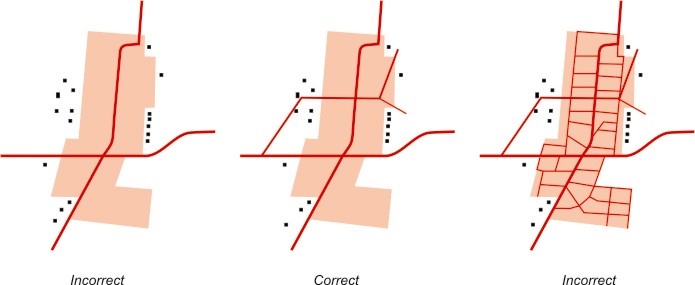
1:25 000 and 1:100 000
At 1:25 000 and 1:100 000 all roads will be captured within built up areas. Geoscience Australia will provide detailed road base digital data or reference material in large metropolitan centres (e.g. Melbourne, Wollongong). Producers should action request Geoscience Australia if this information is not provided with the work package.
Road pattern interpretation within BUA - see example below;
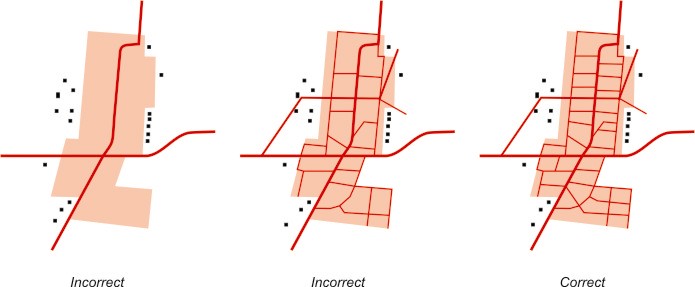
When representing the roads on the map face all dual carriageways, principal roads, secondary roads and minor roads will be shown on the map face subject to cartographic principles. In areas where there is little infrastructure and vehicular track provides the primary access route between a feature of topographic significance and a Built Up Area, a track should be included to the first intersection with a through route. Vehicular Tracks fully contained within Built Up Area will not shown on the map face. These rules extend to other features (including defined holes, areas of universe polygon) in the built up area layer where they are surrounded by a built up area.
The only exception to the above rules will be in large metropolitan centres (e.g. Melbourne, Wollongong), where the selection of roads in Built Up Areas may need to be cartographically generalised on the map face but the data capture will not be altered. If this is the case than:
- All dual carriageways, principal roads, secondary roads will be represented.
- All Minor roads entering a built up area will be continued to the first intersection with a major through route. In addition, sufficient minor roads will be shown to reflect the Built Up Area's road pattern. Select the major through routes (from Primary Reference material) to reflect the road pattern within the area whilst avoiding clutter.
- Vehicular tracks will not be shown in Built Up Area unless they are the only route to a significant location on the map
Road pattern interpretation within BUA - see example below;
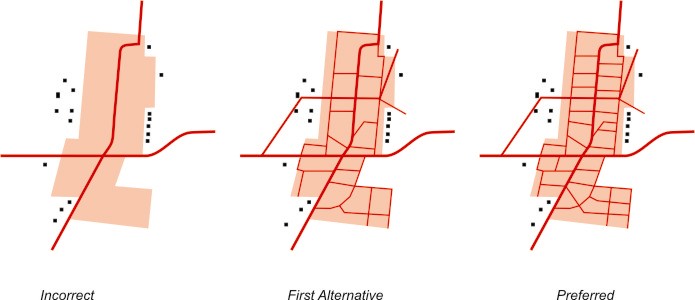
6.7.4 Attribute Fields Defined for Roads Feature Class
This chapter provides a centralised area for the further explanation of the meaning of domain options for fields shared by 6 separate subtypes within the Roads Feature Class. These fields and domains are as follows:
6.7.4.1 Controlling Authority and Maintenance Authority
In all cases the Domain Option will refer either to the controlling authority (from whom permission is to be sought for an alteration/access/funding/etc) or for the maintenance authority (responsible for the repairs of the road surface and associated activities) dependant on the attribute field being addressed.
| Domain Option | Definition |
|---|---|
| Local Authority | A local government authority or agency has through specific legislation, registration process, gazettal or proclamation been conferred with the responsibility for a section of road. |
| Other | Where the Authority is either unknown or does not fall within any of the other Domain Options |
| Other Government Authority | A Government Authority or agency (not Local, State or Territory) which through specific legislation, registration process, gazettal or proclamation been conferred with the responsibility for a section of road. Federally Funded roads will be still be considered under State authority unless a Federal government authority or agency takes full active responsibility for the section of road, where this is the case it will be considered as an 'Other Government Authority'. Examples of this category include roads situated on Defence Training Facilities. Roads managed in countries other than Australia by foreign governments will also be included in this category, when known. |
| Private | Where the road is situated on privately owned landed (owned either by an individual or organisation), where all authority is held by the private owners. |
| State Authority | A state/territory government authority or agency has through specific legislation, registration process, gazettal or proclamation been conferred with the responsibility for a section of road. Federally Funded roads will be still be considered under State authority unless a Federal government authority or agency takes full active responsibility for the section of road, where this is the case it will be considered as an 'Other Government Authority'. |
| Undetermined Government Authority | Where the Authority for the road is known to be a government agency/authority within Australia but additional details of the jurisdictional level can not be determined. |
6.7.4.2 Road Classifications
Road classifications will be as shown on the authorised road reference material supplied. Roads not shown on the authorised roads reference material will maintain the classification on the base material/digital data.
Classifications are:
| Classification Domain Option |
Functional Road Classification Domain Option |
Definition |
|---|---|---|
| Principal Road Secondary Road |
National Or State Highway | Roads which are of importance in a national sense, and/or are a major interstate through route, and/or are principal connector roads between capitals and/or major regions and or key towns/commercial centres/inter-transport hubs. These roads are generally state-controlled and open access (apart from tollways which are restricted access roads). |
| Principal Road | Arterial Road | Well maintained and widely used roads which are major connectors for national highways or state highways, major centres, key towns, or have major tourist importance or which main function is to form the principal avenue of communication for metropolitan traffic movements. These roads are generally state-controlled and open access. |
| Secondary Road | Sub Arterial Road | Acts as connector between highways and/or arterial roads, or as an alternative for arterial roads, or a principal avenue for massive traffic movements. These roads are generally state-controlled and open access. |
| Minor Road | Collector Road | Provides for traffic movement between sub-arterial and local roads or to distribute traffic to local street systems. These roads are generally controlled by local government and are open access. |
| Minor Road Vehicular Track |
Local Road | These roads are generally controlled by local government and are open access. Generally from these local roads diverge roads that provide property access. Includes service roads that may share the same name as higher order roads. |
| Minor Road Vehicular Track |
Access Road | Road designed to provide access to the rear of, into or within a property but may not necessarily be part of the public road network. They generally do not have addresses. Would be applied to urban service lanes, driveways, and other tracks on private property. |
| Minor Road Vehicular Track |
Service Road | Road designed to provide access to service another piece of infrastructure either another road or an entity such as a pipeline, powerline or fence. |
| Vehicular Track | Unknown | Functional Classification Undetermined |
The differentiation between 'Principal Road' and 'Secondary Road' classifications for 'National Or State Highway' functional classification is as follows:
- Some Highways over time have been superceded by more direct routes and have in essence become a Sub Arterial Roads, these Highways should have the 'Secondary Road' Classification. An example of this case is two Highways 'Buntine Highway' and 'Buchanan Highway' which have become Sub Arterial Roads with the Arterial Connections of the populated places of 'Katherine', 'Kununurra','Halls Creek' and 'Tennant Creek' being catered for by the 'Stuart Highway','Victoria Highway' and 'Great Northern Highway'.
The differentiation between 'Minor Road' and 'Vehicular Track' classifications is related to the level of maintenance and associated infrastructure, as follows:
- 'Vehicular Tracks' classifications as per the definition for the associated feature type are "public or private roadways of minimum or no construction which are not necessarily maintained. Generally require four wheel drive but may be accessible by two wheel drive in sustained good weather conditions". Vehicular tracks are not graded and should be considered to have a formation of 'Unimproved'. They are not normally associated with any form of traffic control devices or lighting.
- Where as a 'Minor Road' have sufficient levels of maintanence (eg grading) or construction for two wheel drive access in normal weather conditions for the region. Most suburban roads within cities/townships and most country roads connecting townships maintained by local government authorities/agencies would at minimum fall into this category. A 'Minor Road' will have at a minimum basic traffic control signage such as give ways signs etc.
When reference material indicates a section of the route is sealed, the classification should default to a minimum classification level of 'Minor Road' (ie Vehicular Track is not an acceptable classification option in this case). If this results in an illogical connection with the abutting roads, this should be resolved via action request to GA.
6.7.4.3 Formation
Road formation will be as shown on the road reference material supplied. Roads not shown on the authorised roads reference material will maintain the formation on the base material/digital data unless orthophotography or imagery clearly delineates a different formation (eg sealed vs unsealed).
Principal Road, Secondary Road and Minor Road should be considered to have a minimum formation of 'Unsealed'.
Vehicular tracks are not graded and should be considered to have a formation of 'Unimproved'.
Classifications are:
| Domain Option | Definition |
|---|---|
| Sealed | Road surface that has been layered with one, or a combination of, concrete, bitumen, permeable paving layer, interlinking natural or man-made cobblestones/bricks/setts. |
| Unimproved | Road surface that has not been layered with one, or a combination of, concrete, bitumen, permeable paving layer, interlinking natural or man-made cobblestones/bricks/setts. The surface is utilising the natural soil base, it has not undergone any grading and is not under any known maintenance regime. |
| Unknown | The surface of the road can not be distinguished from reference material including imagery. New roads under construction will fall into this category. |
| Unsealed | Road surface that has not been layered with one, or a combination of, concrete, bitumen, permeable paving layer, interlinking natural or man-made cobblestones/bricks/setts. Generally the surface is utilising the natural soil base or some form of loose gravel base to allow better vehicle access or movement. Unsealed roads are under some known maintenance regime. |
6.7.4.4 Number of Lanes and Direction of Travel
Below is a further definition of Direction of Travel domain options:
| Domain Option | Definition |
|---|---|
| Alternating | At any moment in time, traffic flow can only transverse a section of road in one direction. That direction can be changed. The direction of flow may be controlled via different traffic control devices (such as traffic lights, signage, movable barriers etc) or by the width of the road where drivers give way in accordance to road rules. |
| One way | Traffic flow is constrained to one direction at all times. eg one way streets, one carriageway of a dual carriageway. |
| Two way | Traffic flows freely in both directions |
| Unknown | Traffic flow direction is unknown. The default for road classifications not associated with dual carriageways for 'National Or State Highways', 'Arterial Road', 'Sub Arterial Road' will be Two Way where unable to be determined from reference sources. |
The 'Number of Lanes' relates to the number of lanes delineated on a section of road regardless of travel direction. Therefore if a road carriageway had one lane which allowed travel going from north to south and another two lanes which allowed travel from south to north. Then the number of lanes would be 'More Than two' even though only a maximum of two lanes travel in specific direction.
Most vehicular tracks will be only one lane as lanes are not normally delineated and travel direction is generally alternating, this will be the default for all vehicular tracks.
Where a road is dual carriageway, the number of lanes for each carriageway should be considered separately.
6.7.4.5 Operational Status of Road
Below is a further definition of Operational Status domain options:
| Domain Option | Definition |
|---|---|
| Closed | Road has been closed and is not available for public travel, generally due to deterioration in road surface or other safety risk, re-zoning into a new use or road is superceded by a new road bypass, etc. |
| Notional | A road which was conceptionalised but never instigated. This classification should not be used in the capture of new roads but only in the translation of collaborators data. Roads of this classification should only be reclassified after visual confirmation from imagery/orthophotography. |
| Operational | Road is available for public travel. |
| Proposed | Road has been proposed and is either about to start, or is currently undergoing, the State/Local Government planning and approval processes. Road construction has yet to be commenced. This classification should not be used in the capture of new roads but only in the translation of collaborators data. Roads of this classification should only be reclassified after visual confirmation from imagery/orthophotography. |
| Under Construction | Road is currently being newly constructed or undergoing significant re-construction/improvement works which may affect its functional classification or its surface formation. |
6.7.4.6 Limitation of Traffic Access
Below is a further definition of Limitation of Traffic Access domain options:
| Domain Option | Definition |
|---|---|
| No Known Limitations | Road has no known limitations to traffic access caused by seasonal or weather conditions. |
| Seasonal | Seasonal variation may prevent the ability to successfully transverse the section of road. Roads may be formally closed by the Controlling Authority during these periods or alternatively remain open but passage be blocked by natural barriers (eg flood waters). eg Wet/Dry Season in northern Australia, Winter in Snow affected areas |
| Weather Permitting | Particular weather events (eg rainfall levels) not contained within a specific seasonal period may prevent the ability to successfully transverse the section of road. |
6.7.4.7 Road User Access
Below is a further definition of Road User Access domain options:
| Domain Option | Definition |
|---|---|
| Authorised | Access to road requires Authorisation from either Local/State/Federal Government Authority/Agency, Community/Not for Profit/Commercial Organisations or Indigenous Communities. This can include access to certain roads in national parks, on indigenous lands, within cemeteries/hospitals/school communities/gated residential communities, shopping centres etc. Access by the public is gained once certain conditions are met. Examples of these conditions may be
|
| Public | Road is generally available for Public use at all times. |
| Restricted | Access to road is restricted to the Controlling or Maintaining Authority/Organisation and their nominated representatives. Access to the Public is not normally provided. Examples of these roads include roads situated be on freehold pastoral land or within prohibited areas such as quarantine facilities. |
| Tollway | Road, or section thereof, which is owned and/or operated by a Local/State/Federal Government Authority/Agency or Commercial Organisation. The road is generally available for Public use but requirements a system of payment (fee) for access. Tolls may be paid via toll booths or e-tag systems. |
6.8 State Borders
The sections of state borders which do not follow natural features do not necessarily fall exactly on the meridians of longitude or the parallels of latitude. Rather they have been defined by survey monuments. The coordinates for these monuments have been used in the construction of the GEODATA 100K-COAST dataset, which in turn will be used for defining these sections of state borders in the NTDB. As the survey monuments defining the state borders correspond to vertices in the data, these state border features in the data must not be filtered or point reduced.
Where state borders follow a natural feature, such as the Murray River, the natural feature as represented in the data must be cloned as the state border into the framework layer. The GEODATA 100K-COAST dataset is not to be used to define the state border in these places, since it would then not match with the feature it should follow. The GEODATA 100K-COAST dataset can be used as a guide to deciding which sections of natural feature should be cloned.
6.9 Hydrography and Coastal Relationships
6.9.1 Naming Lakes and Double Line Streams
All waterbody names that appear on the base material/digital data or on reference material will be carried as attributes of the appropriate features in the database.
6.9.2 Naming Swamps, Reservoirs and Land Subject to Inundation
The name, if known, will be added for all swamps, reservoirs and land subject to inundation shown in the database. Note that the name of some features may not match the feature type. For instance, the name "Williams Swamp" may in fact be associated with an area of "land subject to inundation" rather than an area of "swamp".
6.9.3 Naming Watercourses, Anabranches, and Connectors.
All stream names (for double & single line streams) that appear on the repromat or base material/digital data will be added/retained as attributes to the appropriate features (including connectors) in the database.
Where a stream forms a complete loop by leaving and re-joining a main stream (that is, an anabranch), and is less than 20 kilometres long, it will carry the name of the main stream as its name attribute. If it is more than 20 kilometres long, it will not carry the name of the main stream as its name attribute. Regardless of length, if it is labelled as "anabranch" on the latest previous edition map it will carry the name of the main stream. The following illustrations show examples of this.

In some circumstances an anabranch may be separately named and in these cases it will maintain its own name in the name attribute field.
In the case below the name field for the anabranch feature will be "BECAUSE CREEK". Once again the word "anabranch" does not appear in the name attribute field.
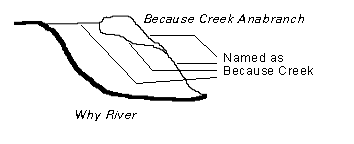
Where a stream leaving the main stream joins a different stream and is not separately named it will not be given a name attribute.
Refer to Section 3 6.9.5 and Section 3 6.9.6 this specification for more details on Connector and Junction features respectively.
6.9.4 Braided Watercourses
At times it may be difficult to determine whether a stream should be considered braided and if so whether it lies within primary banks. This chapter provides some principles for this decision; however, ultimately it will be a subjective judgement, based on the available source information. Generally the handling of streams in areas with highly variable flow requires special care and guidance is given for handling these situations.
A braided stream is a watercourse comprised of a number of interlaced channels separated by sandy bars resulting from irregular stream discharge and deposition of coarse material. Essential characteristics are that it consists of a network of interlaced streams. Typically a braided stream will have a relatively flat bed.
Streams on Geoscience Australia's topographic maps may have a single channel or a channel that splits for one or more islands. Such streams should not be considered braided because the lack an interlacing network of channels. Typically such streams will have a relatively stable flow pattern and a higher gradient than streams in the other cases. Figure 1 illustrates such a case.
Figure 1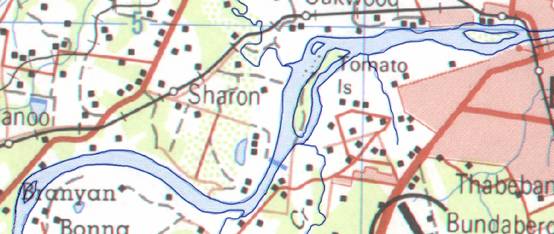
from SG5602 Bundaberg 1:250 000
At the other end of the spectrum are rivers that typically are dry or have highly variable flows. Such rivers are found in central and northern Australia and typically have a sandy bed; much of the actual water flow is often through the sand. Intermittently these rivers flood but the surface flow is not sufficient to establish a pattern of braided channels. Figure 2 illustrates such a case.
Figure 2
from SD546 Hann River 1:250 000
Where a stream channel is occasionally shown as crossing the stream it should be shown as a linear watercourse within a watercourse area. Note that the linear network must be maintained. If the linear feature ends at a bank the watercourse line must either be run along the bank for short distances or connectors used to join the linear segments. If the watercourse is shown as perennial on the Inland Water Features Guide, (Appendix D), the watercourse area should be classified as non-perennial and the watercourse lines be classified as perennial. In these cases a watercourse line should be used in preference to connectors to ensure connectivity. A channel may be captured from the imagery. Once there are sufficient channels to form a braided stream it is treated as such.
Between these two extremes lie braided streams. Such streams have sufficient continuous flow to establish clear channels but the slope and sediment load is such that channels develop into a braided pattern. Braided streams are treated as a series of individual watercourses rather than a single watercourse area.
Typically braided streams lying within primary banks will be an interlacing network of streams within a confined area.
Braided streams not lying within primary banks will spread over a larger area. Classic examples would be found in the channel country of SW Queensland. Braided streams not within primary banks are likely to be found in areas where flow is sufficient to establish channels but where gradients are very low.
Where streams form clear dendritic patterns and contours indicate a single clearly defined streambed but the streams are braided they should be considered to be within primary banks. Figure 3 is an example of a braided watercourse lying within primary banks.
Figure 3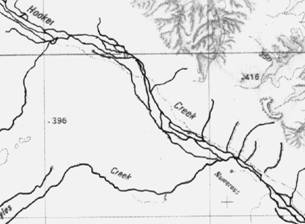
from SE5211 Birindudu 1:250 000
The following diagram identifies features associated with braided watercourses lying within primary banks and shows the relationships between the respective features.
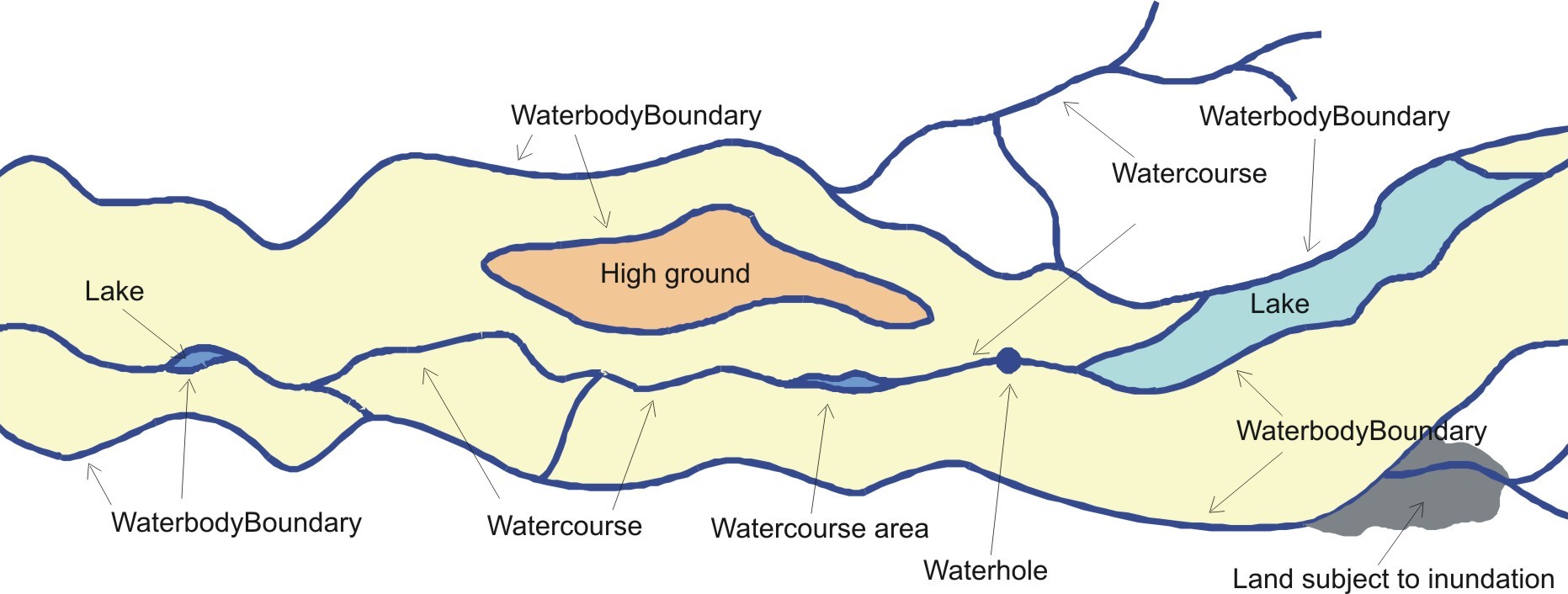
Where channels form an interlacing pattern across the landscape, where the contours indicate little differentiation to group individual channels and where it is difficult to differentiate between watercourses running side by side the braided watercourses should be considered to be not within in primary banks. Figure 4 is an example of such a case.
Figure 4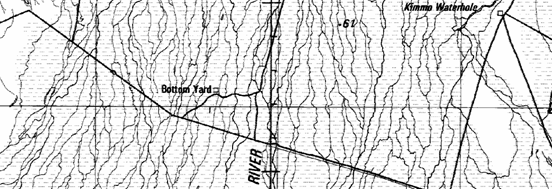
from SF5414 Brighton Downs 1:250 000
6.9.5 Connector Feature
Drainage patterns are made up of both linear (narrow streams) and polygon features (such as lakes and swamps) and as such do not constitute a rigorous linear network. To allow linear analysis of drainage networks to be carried out an artificial feature called a "Connector" has been added to the data.
This Connector feature is used to bridge the gap in linear watercourse features where they are separated by water bodies such as lakes, swamps and watercourses that are depicted as area features. The Connector feature is composed of one or more chains in the general location that would be expected if the polygon feature was collapsed to a line. The points that make up this chain cannot be given any value for planimetric accuracy, and are therefore assigned a default value for the feature of 9999 (not applicable) for the standard deviation of planimetric accuracy.
The Connector will only be used if there is flow across a waterbody polygon feature. Thus if there is only inflow to a lake and no outflow the Connector feature will not be used.
The use of the Connector feature will cease when a watercourse runs into the sea. In cases where the flow is divided (that is, in river deltas or around river islands), the flow will be represented by only one of the possible paths which will be arbitrarily chosen.
All Connectors contained in waterbodies that flow into other waterbodies will be extended to join the Connector on the recipient waterbody (see diagram in Section 3 Chapter 6.9.9 Differentiation between the Sea (inlets) and Watercourse Areas).
Tributary Watercourses flowing into a polygon waterbody will be linked to the waterbody's Connector for the main watercourse with Connectors (see diagram in Section 3 Chapter 6.9.9 Differentiation between the Sea (inlets) and Watercourse Areas).
The general rule for the attribution of Connectors is that Connectors carry the attributes of the river they represent, that is the classification and perenniality shown in Appendix D. In the application of the rule it must be considered that:
- Connectors entering or bounding mangroves are perennial, and will remain perennial, from that point to the coastline.
- Rivers can change their perenniality along their course.
To complete the linear drainage network in Town Water Storage and Rural Water Storage reservoirs, Lake Perennnial and Watercourse Perennial features the inflowing linear drainage features should extend and connect through the waterbody with no change in feature type classification. The main watercourse/canal should transverse the entire waterbody from the inflow to outflow point. No additional vertices are required in the waterbody feature at any of the inflow and outflow points. see figure 1.
Figure 1:
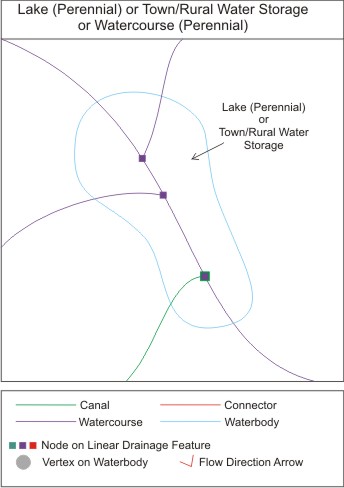
To complete the linear drainage network in Lake Non Perennnial, Watercourse Non Perennial and Flat feature class (Land Subject to Inundation, Marine Swamp, Swamp, Saline Coastal Flat) features, the inflowing linear drainage features should extend and connect through the waterbody with no change in feature type classification as far as defined watercourse lines/canals can be seen on imagery/orthophotography. Connectors will be used to connect where water from the defined linear features dissipate into the waterbody to the outflow location. No additional vertices are required in the waterbody feature at any of the inflow and outflow points except where the connector enters or exits the waterbody. see figure 2.
Figure 2:
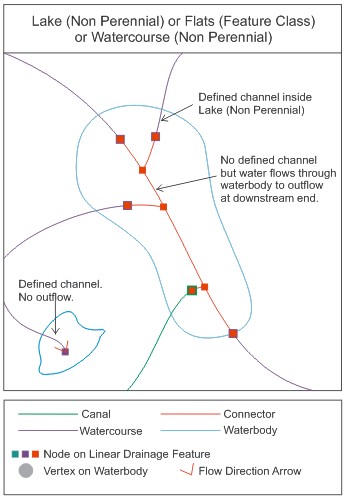
To complete the linear drainage network in Flood Irrigation Storage reservoirs and Pondage Area (feature class) the inflowing linear drainage features should extend and connect through the waterbody. Upon entry into the waterbody the feature type classification will be changed to 'connector'. A main 'backbone' connector should transverse the entire waterbody from the inflow to outflow point. Additional vertices are required in the waterbody feature at all inflow and outflow points as should be coincident with nodes in the linear network. Note: Many pondage areas do not have designated outflow locations and therefore do not require connectors. see figure 3.
Figure 3:
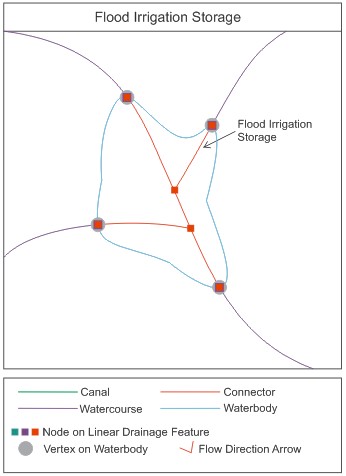
To complete the linear drainage network in Canal Area features the inflowing linear drainage features should extend and connect through the waterbody. The 'backbone' of the canal area should have its feature type classification changed to 'canal line' and transverse the entire waterbody from the inflow to outflow point. All other inflowing drainage lines should have no change in feature type classification but should intersect with the 'backbone' canal line. No additional vertices are required in the waterbody feature at any of the inflow and outflow points. see figure 4.
Figure 4:
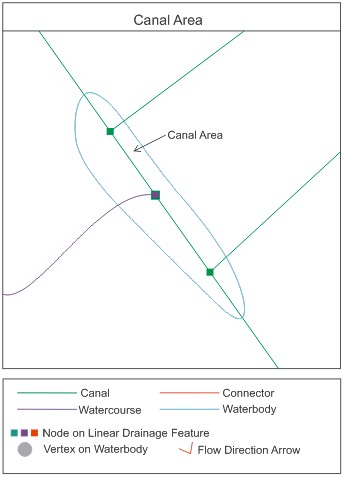
The final figure shows how the linear drainage network and associated waterbody polygons work together.
Figure 5: Summary of Connectors in the drainage network
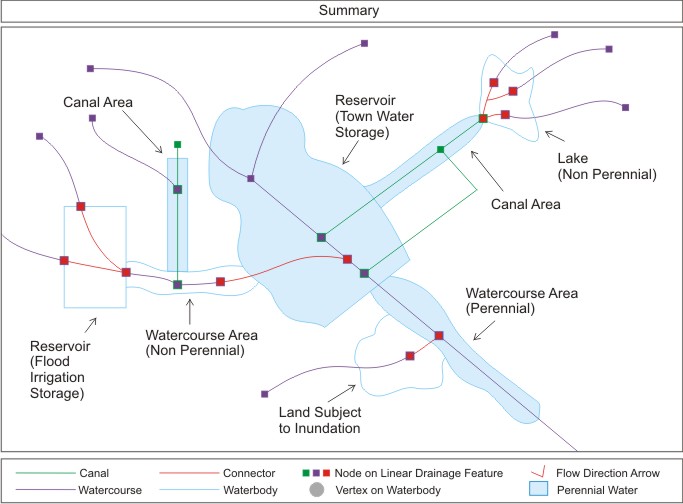
6.9.6 Junction Feature
The Junction is a linear feature which occurs in the Framework Feature Dataset. It is an artificial line used to separate adjacent polygon areas across which flow can occur. A Junction separates
- watercourse polygons, canal polygons, lakes and reservoirs polygons from the Sea; or
- two adjacent sea polygons with different attributes (eg Ocean Name).
The points making up the Junction chain feature are arbitrarily placed and cannot be given any value for planimetric accuracy, and are therefore assigned a default value for the feature of 9999 (not applicable) for the standard deviation of planimetric accuracy.
Junction features will be placed:
- separating sea polygons of the same class but with different attributes.
- closing the mouth of rivers (coastline).
- filling the coastal gaps in the framework feature dataset.
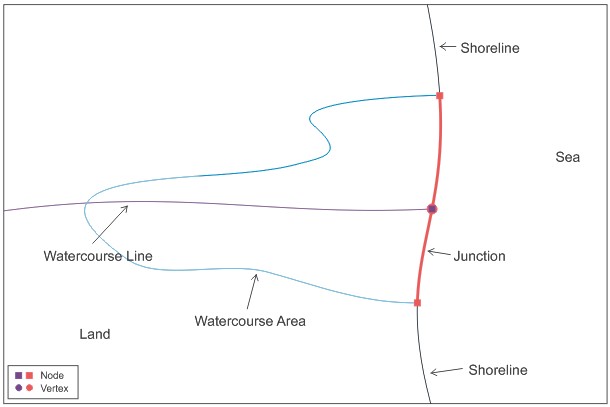
6.9.7 Islands
Islands will be represented as polygons coded 'island' when they are fully surrounded by sea. Islands in inland water are usually depicted as defined holes within waterbody feature types. If the island is at the mouth of a river and is met on either side by a junction feature then part of the bounding line of the island appears in the framework feature dataset, shown as shoreline, and the remainder appears in the waterbody feature dataset as a polygon edge. In this case no closed polygon is created in either feature dataset. The placement of junction features should attempt to avoid this case where possible. Where named, these inland (and partially inland) islands will be represented by a Locations feature type "Waterbody Island " placed near the middle of the island.

6.9.8 Depiction of the Coastal Environment
The Framework, Waterbodies, Marine and Vegetation feature datasets contain features which depict the coastal environment. The area of tidal influence is part of the Sea feature unless it is closed off by a Junction feature.
The line separating the sea and the land (shoreline) will be the position of mean high water level. The exception is in mangroves, where the shoreline will run on the seaward side.
The following diagram identifies features associated with coastlines and shows the relationships between the respective features.
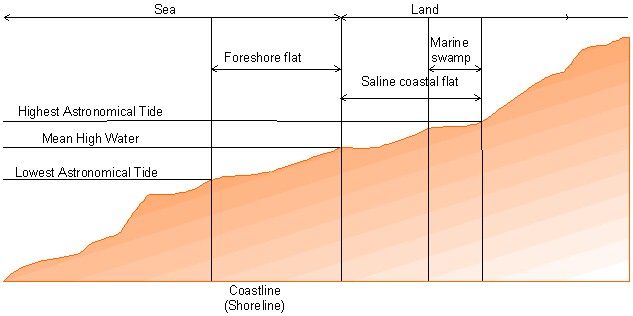
To preserve the name of a watercourse for its entire length, a Junction will be used to close off tidal portions of named watercourse polygons, where the watercourse flows into an inlet or bay considered part of the watercourse (see Section 3 Chapter 6.9.9 Differentiation between the Sea (inlets) and Watercourse Areas). The polygon formed by closing off inlets will be a Watercourse feature.
The use of the connector feature (or watercourse line) will cease when a watercourse runs into the sea.
The diagram below (in Section 3 Chapter 6.9.9 ) illustrates how features are used in the NTDB to represent the riverine and maritime environments.
6.9.9 Differentiation between the Sea (inlets) and Watercourse Areas
The interpretation of features as watercourse areas or inlets should be done by applying the following criteria:
- when the area in question is named as part of the sea (inlet, bay, etc.) it should be considered as such.
- when the polygon feature is named as a river it should be considered as a watercourse area.
- when the area in question has no name and there is no linear stream flowing into it, it should be considered as part of the sea.
- when the polygon feature is unnamed, has a single line stream flowing into it and is longer than 4 mm at map scale, it should be considered as a watercourse area.
- when the polygon feature is unnamed, has a single line stream flowing into it and is shorter than 4 mm at map scale, it should be considered as part of the sea.
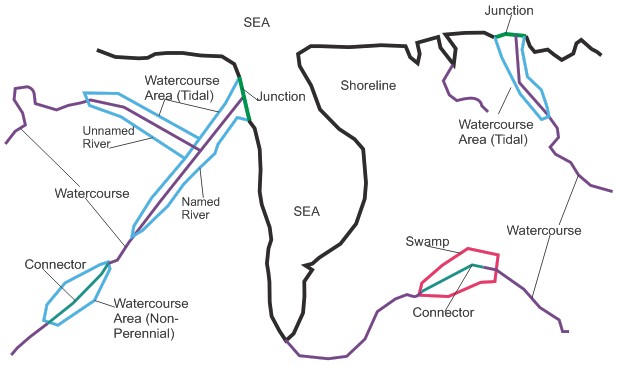
The coastline is represented by chains coded as shoreline. These chains are indicative of the mean high water mark except in areas covered by mangroves, where the limit between the sea and the land is considered to be the seaward side of the mangroves.
In the places where walls have been erected to prevent the erosion of the land by the sea, sea walls will be clones of the shoreline.
6.9.10 Recreation Areas and Waterbodies
Waterbodies will be considered part of recreation areas when they are fully included in the recreation area. That is, they will not be shown as defined holes (or areas of universe polygon) within the recreation areas. In all cases the water bodies will appear as such in the Waterbodies feature dataset.
Note: care should be taken to avoid confusing Recreation Area (feature class) and Nature Conservation Reserve feature types (see Appendix A).
6.9.11 Pondage Areas Capture
Pondage Areas are separated into three main categories:
- Settling Ponds
- Aquaculture Areas
- Salt Evaporators
Settling Ponds are used generally for waste treatment (e.g sewage, mining waste) and are normally isolated from the natural hydrological network. Settling Ponds may be distinguished from other types of ponds by the presence of the treatment tanks and plant infrastructure, this is especially relevant when the waste product is sewage.
Aquaculture Areas are typically more frequent and smaller in size compared to Settling Ponds. Aquaculture Areas can be differentiated from Settling Ponds due to their proximity to other features such as town and rural water supply, whereas Settling Ponds are rarely found near these types of Reservoirs. Aquaculture Areas are easily identified on imagery due to their rectangular or geometric shapes. The ponds increase marginally in size to accommodate the growth and maturity of the aquatic species.
Salt Evaporators will only be found in areas of low rainfall and high solar intensity. Salt Evaporators will be characteristically located on flat terrain. Ground, bore or sea water is pumped into large ponds to enable the water to be evaporated by the sun leaving the salt behind. Salt Evaporators may be differentiated from Aquaculture by the varied sizes of smaller beds with irregular edges located within a larger grid pattern. In addition, salt has a distinctive imagery signature in comparison to the surrounding environment.
When capturing Pondage Areas, individual adjacent ponds separated only by either artificial barriers or access paths, will be captured as one polygon. The separations caused by artificial barriers or access paths will be represented by Settling Pond Internal Lines or Salt Evaporator Internal Lines as appropriate.
Example 1: Pondage Area Polygon Capture
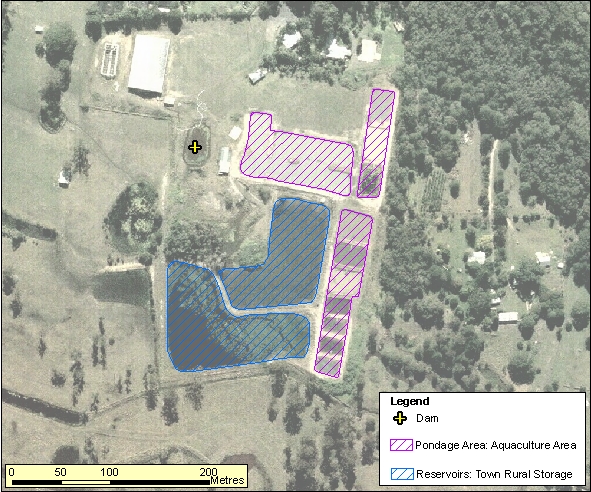
Example 2: Pondage Area Polygon Capture with Internal Line Representation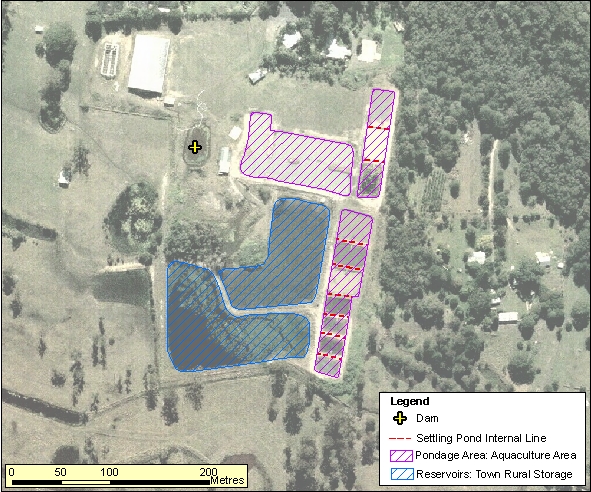
6.10 Aircraft Facilities
The following diagrams illustrate how aircraft facilities are depicted as point, arcs and polygons at both within the data and for products at various scales:
Real World Entity - Heliport Facility
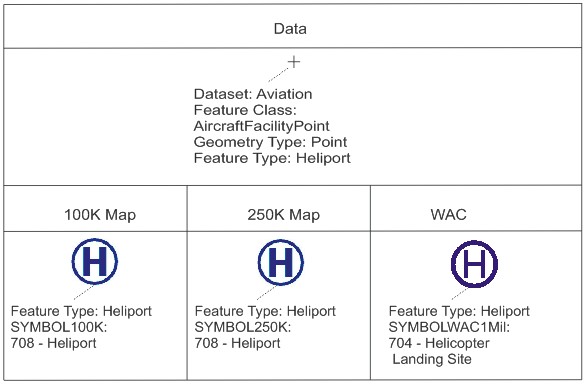
Real World Entity - Landing Ground Facility
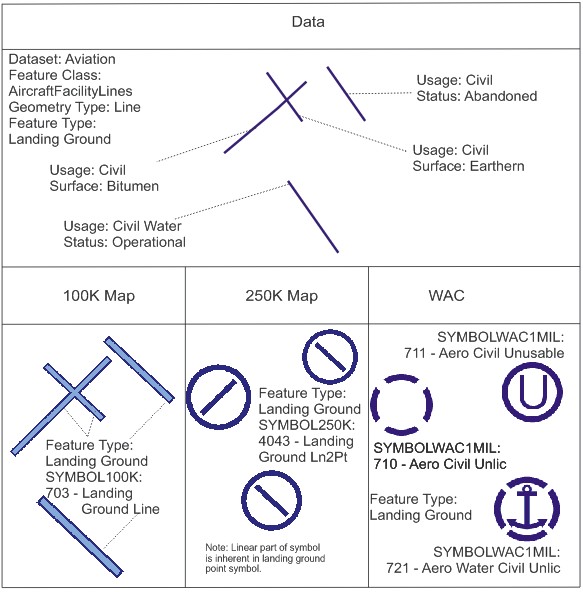
Real World Entity - Airport Facility
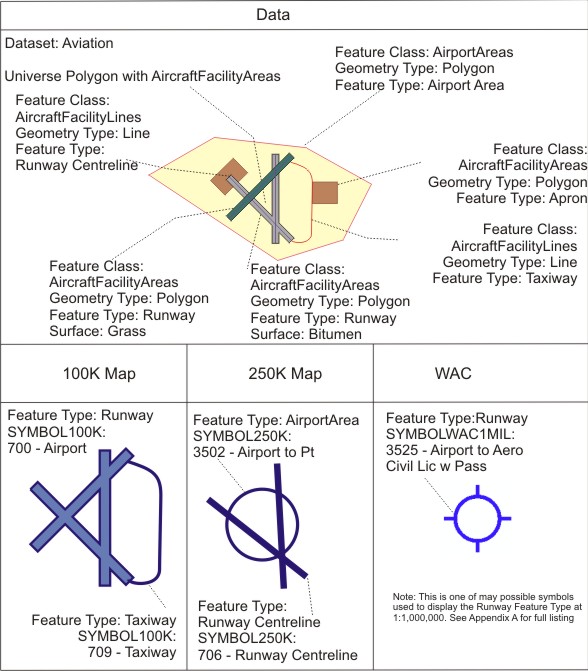
Geoscience Australia may supply cadastral information as part of the work package Reference Material. If this is the case, it can be useful in defining the true extent of Airport Area. However cadastral information should only be used as a guide.
In the example below the majority the western Airport Area boundary is coincident with the cadastre but some detailed sections of cadastral boundary have been generalised. In comparison the eastern edge of the Airport Area is not coincident with the Cadastral boundary. It should also be noted that in this example the runways have two different surfaces bitumen for N-S and grass for the NW-SE and therefore the runways have been captured as two separate polygons.
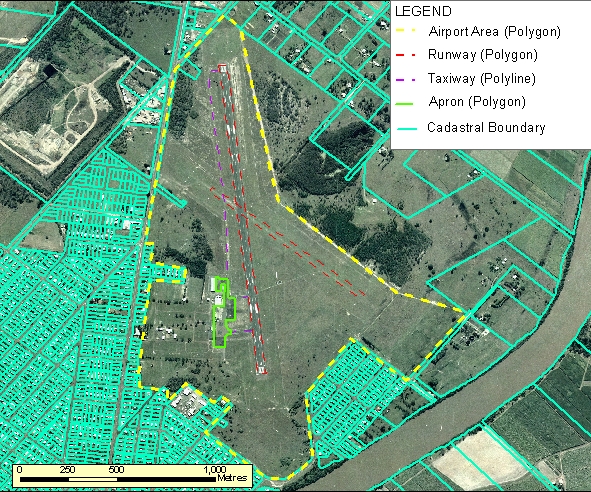
The second example has the Airport Area coincident with the cadastral boundary and shows the advantages of utilising this information in assisting in the definition of the polygon extents.
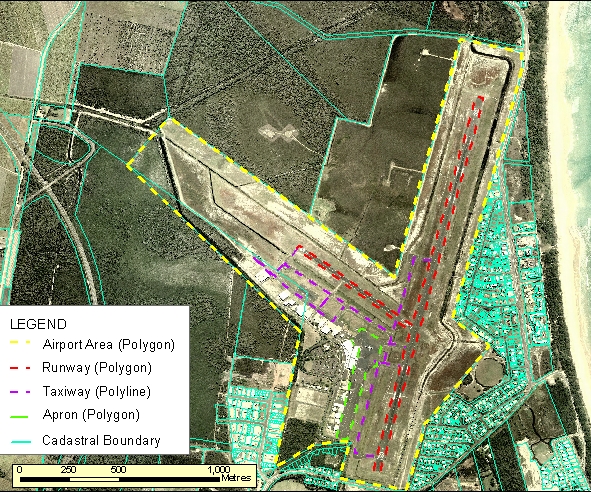
6.11 Large Area Features
Large Area Feature boundaries were derived from the interpretation of maps, reference texts and other material from a variety of authoritative sources on themes such as terrain, climate and vegetation.
The authority for desert names is the Geographical Names Board in the State concerned.
Other names may not be approved names.This feature type does not imply that other large area features should not be named. If a large area feature is not represented by this feature type (and not specifically requested by Geoscience Australia to be included in this feature type) then it should be included as a place name if it does not meet the definition of any other entity within the NTDB.
6.12 Intensive Animal Production
Intensive Animal Production (IAP) Facilities have the following characteristics:
- They consist of groups of buildings and associated facilities functioning together as a unit/complex
- Are capable of confining a large number of livestock for intensive growing or finishing for market (e.g. feedlots, piggeries)
The boundary of an IAP facility should encompass all buildings, sheds/barns, feed storage facilities, yards, waste disposal (such as settling ponds and waste dumps) and associated infrastructure contained within the complex. The features the IAP boundary encompasses should still be captured, where appropriate, in their applicable feature classes. e.g. Silos, Buildings, Settling Ponds.
The boundary of an IAP facility should not contain neighbouring fields that may be utilised to provide feed to the livestock.
Boundaries of IAP facilities can usually be aligned to land parcel boundaries and therefore cadastral source material should be used to define these production facilities where possible. Where the cadastral source material deviates greatly from the main IAP facilities extent or where no cadastral information is provided then a representative polygon should be created. The following are examples of the boundary to be placed around IAP facilities, as each example contains a snapshot of satellite imagery the file size was prohibitive in including directly within this section, please refer to Appendix U 1. Introduction for an explanation of approximate download speeds prior to opening these examples if there are any concerns.
| Example 1, [308 kb] | Example 2, [310 kb] | Example 3, [330 kb] |
| Example 4, [320 kb] | Example 5, [380 kb] | Example 6, [370 kb] |
Note: Additional Examples of Intensive Animal Production facilities may be found in Appendix U.
6.13 Homesteads
Homesteads can generally be identified, because characteristically, they:
- are surrounded by irrigated vegetation/gardens
- have supporting infrastructure such as sheds
- have a main access road to the Homestead which may be lined with vegetation.
Below is an example of how a homestead is represented in ortho photography and then how it would be captured in the NTDB. The determination on whether a homestead or building should be represented as a building area or solely as a building point should be based on the size criterion for data capture or inclusion as appropriate.
Example 1: Homestead on Orthophotography
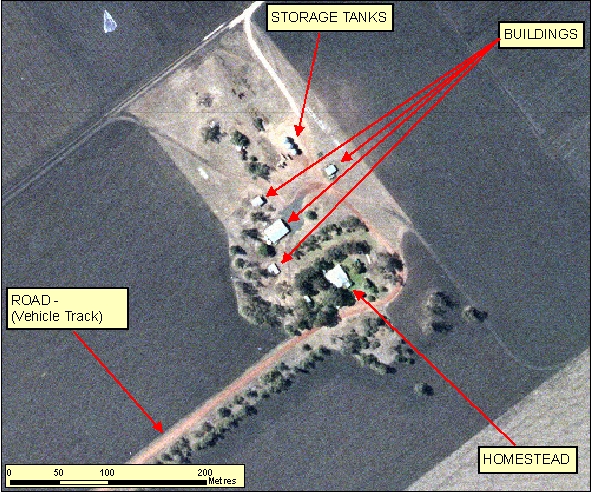
Example 2: Homestead data representation in NTDB
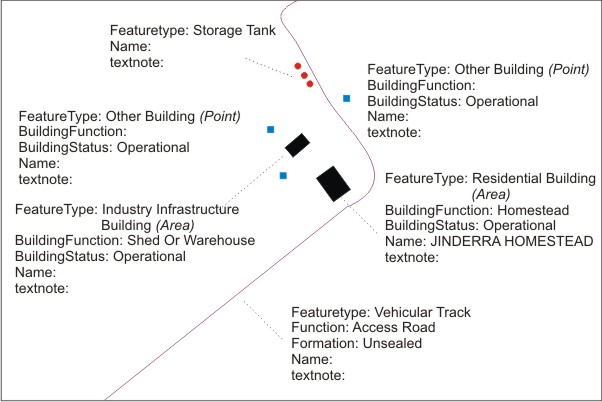
6.14 Schools
Schools can vary in complexity. Urban schools can have a variety of buildings in which students are taught, with supporting buildings for dormitories and sheds as well as a variety of topographic features such as ovals, rugby pitches, car parks, private access roads and the miscellaneous land not designated for any specific purpose but still owned by the school. While large rural schools can have a similar complexity, the smaller country schools may have only a one or two buildings and some garden area. See Appendix U - Imagery Interpretation Guide for more information.
While a schools private access roads and associated car park are not depicted in Geoscience Australia's data models, the other features which fall within feature type definitions such as building points, building areas and recreation areas will be captured.
The landmark area feature type 'Educational Institution' is used to provide a spatial link between numerous feature classes comprising the cohesive complex. No features within the cohesive complex should cross the boundary of the Educational Institution as defined by the Landmark Area.
Reference and Supporting Information provided with work packages generally provide sufficient detail to capture schools accurately with assistance from imagery. Directly below is a schematic diagram of a schools and then an example highlighting how that school should be captured in the NTDB, dependant on the size criterion and other rules set out by Appendix A Feature Type Dictionary.
Example 1: Schematic Diagram of a School Layout
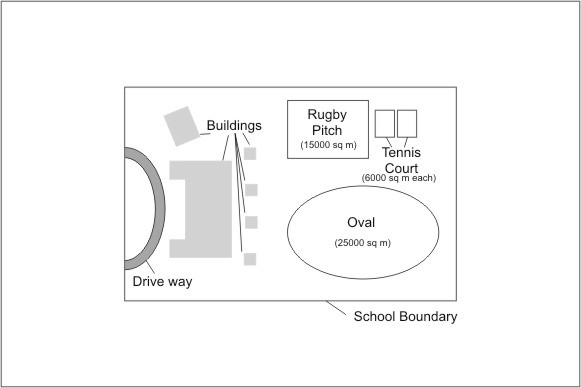
Example 1: School Data Representation
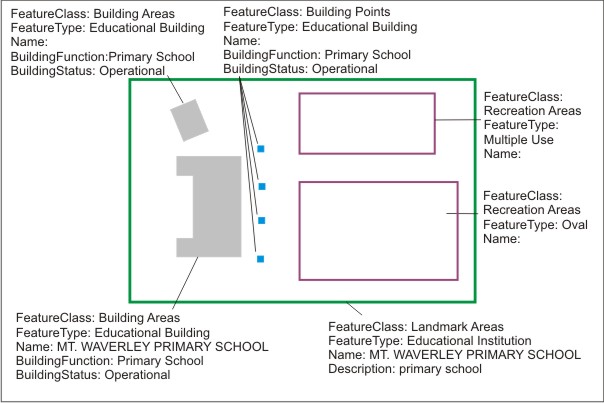
6.15 Building Areas And Building Points
6.15.1 Consistent Geodatabase Rules for all Building Area and Building Point Subtypes
To minimise duplication of information within Appendix A, the following Geodatabase rules are applicable for all 7 BuildingAreas feature class subtypes and all 7 BuildingPoints feature class subtypes:
Size and any other selection criteria apply to all feature occurrences. All feature occurrences existing in the base material/digital data or NTDB meeting the minimum size for inclusion will be retained unless there is clear evidence they no longer exist.
All Buildings above the size criteria of 49 square metres will be captured from supplied imagery where there is strong evidence on the image to support the interpretation or where other reference or supporting material assists the interpretation.
When applicable for inclusion/data capture a Building will be depicted as either a Building Point or Building Area dependant on size criteria.
Existing Building Areas below the minimum data capture size for a Building Area will be retained in the same geometry as captured in the base material/digital data (eg Building Area or Building Point). The only exception is all features below 625 sq m which will be shown as Building Point.
New features below the minimum data capture size for a Building Area and above 49sq m will be captured as a Building Point. New features equal to or above the minimum data capture size for a Building Area at the specified scale will be captured as a Building Area.
A group of buildings will not be aggregated to form a building area.
Buildings will be named where named in the base material, reference material, supporting material or where they are of historical, cultural or national significance. E.g. Australian War Memorial, National Art Gallery, Sydney Opera House.
Buildings of historical, cultural or national significance will either be identified within the base material or should be captured via Authoritive Reference material (including extracts from various government or national trust heritage lists) supplied.
The following sentence assumes that existing base material does not have sufficient detail to populate both the subtype and 'BuildingFunction' fields or that the base material is contradicted by the more recent reference material provided.
Where reference material:
- delineates a 'BUILDINGFUNCTION' type this item should be populated.
- provides sufficient detail to delineate the following subtypes 'Educational Building','Emergency Services Building' or 'Health And Welfare Building' but is unable to determine 'BUILDINGFUNCTION' then clarification should be sought from Geoscience Australia. Where the specific 'BUILDINGFUNCTION' remains unknown the subtype should be assigned and the 'BUILDINGFUNCTION' items remain as NULL.
- provides sufficient detail to delineate the following subtype 'Residential Building' but is unable to determine 'BUILDINGFUNCTION' then the subtype 'Residential Building' should be assigned and the 'BUILDINGFUNCTION' item remains as NULL.
- provides sufficient detail to delineate the following subtypes 'Community Or Commercial Building' or 'Industry Infrastructure Building' but is unable to determine 'BUILDINGFUNCTION' then the subtype 'Other Building' should be assigned and the 'BUILDINGFUNCTION' item should remain as NULL.
- provides a known function for a building which does not fall into any of the predefined subtype 'BUILDINGFUNCTION's then it should be assigned the subtype 'Other Building' and have the known function populated within the 'BUILDINGFUNCTION' item
- provides no known building function then the subtype 'Other Building' should be assigned and the 'BUILDINGFUNCTION' item remains as NULL.
A homestead is a building or collection of buildings which is the permanent residential headquarters of a large agricultural holding; this may also include the administrative centre for farming operations. Homesteads with historical importance should be textnoted 'historical'.
A significant building such as a papermill that cannot be drawn to scale will be shown using symbol 40. Significant buildings should have landmark value. It is not intended that farm or poultry sheds would be considered significant, particularly in areas where there are many such features. Some examples of significant buildings may be: power stations, hospitals, oil refineries. In remote areas features may take on more significance than in populated centres for example: large roadhouses, paper mills, etc.
Buildings coincident with chimneys will be given symbol 2 – Point No Draw or 3 – Polygon No Draw as applicable.
All homesteads will be captured in the data and will not be subject to the rules set out in Appendix C.
Outstations will be considered as Homesteads.
Outcamps will be considered as Place Names. If buildings are present they should be shown as BuildingAreas or BuildingPoints (as applicable) with no text_note. The Place Name should be coincident with a designated building.
Substations will only be included as buildings when there is clear evidence of it meeting the definition of a building. Substations shall not be named unless instructions are provided to do so by GEOSCIENCE AUSTRALIA.
Buildings other than homesteads may be textnoted where the description expands on the distinctive function category eg. Building Function is 'Fire Station Rural' and Textnote is 'seasonal facility' or Subtype is 'Other Building', Building Function is 'Crypt' and textnote is 'Convict Burial' or Building Function is 'Technical College' and Textnote is 'Agricultural'.
Only permanent structures will be captured as buildings within Caravan Parks.
Building Areas below the minimum map representation size will be symbolised as a BuildingArea to Point representation (eg 3537 or 3540) except when not assigned the associated Upperscale Value (in which case it will be given 3 – PolygonNoDraw) see below.
When assigning an Upperscale Value of 250 000 or larger scale (smaller area) the following will apply:
- A sufficient selection of buildings should be assigned the applicable Upperscale value as to reflect the variation in density and distribution of buildings across a given area. Previous edition map densities should be used as a guide only, as they do not take into account temporal change.
- The selection for each scale should consider the proximity of other Building Area and Point features as well as the geometry in which the entities will be represented. (eg If two buildings were drawn to scale in full symbology, the defined selection should not allow symbol overlap). A group of buildings that cannot be shown individually may also be shown by a representative pattern of building features. Homestead may be shown by a single feature representing a group of buildings, in which case it will be situated as to identify the main residence.
- Building Function and Status will assist in determining precedence. Which function will take the highest precedence in any region of the country will depend on the landmark significance/importance when assessing the surrounding features
- Buildings of World, National or Commonwealth significance will be given precedence.
- Buildings with a known function will take precedence regardless of geometry. (eg a point building with a function of 'Homestead' will take precedence over a building area of feature type 'Other Building' and function of null. )
- Where Buildings of the same or Unknown functions are adjacent Building Areas will take precedence to Building Points.
- Built Up Area existence should not be considered when assigning Upperscale. Built Up Area existence will affect symbology and distribution datasets.
Only Homesteads, Grain Storages and substantial buildings visible from a significant distance as a landmark will be eligible for an Upperscale of 1 000 000. The Upperscale assignment should be based on the buildings shown on the previous Edition World Aeronautical Charts taking into account possible temporarility.
Only Operational Building Areas with a Building Function of Homesteads will be eligible for Upperscale values of 2 500 000 and 5 000 000. The assignment of Upperscale Values for these scales will be based on those shown on the applicable previous edition maps.
6.15.2 Clarification of Building Functions
Below are the definitions required to differentiate Key Building Functions:
| Building Function | Definition |
|---|---|
| Allied Health Centre | Facility designed for the assessment and treatment of allied health issues, such as physiotherapy, podiatry, chiropractic therapy or similar. |
| Ambulance Station | Facility for the operations associated with medical emergency response and patient transport |
| Apartment Block | This category includes all dwellings in blocks of flats, units or apartments. These dwellings do not have their own private grounds and usually share a common entrance foyer or stairwell. This category also includes flats attached to houses such as granny flats, and houses converted into two or more flats |
| Aviation Medical and Rescue Facility | Facility for the operations associated with fixed wing and rotary wing emergency response activities, located either at or away from an aerodrome. |
| Aviation Rescue and Fire Fighting Station | Facility for the operations specifically associated with response to aviation emergencies but capable of responding to other fire and rescue incidents |
| Childrens Hospital | Specialised hospital Facility for the treatment and care of children. |
| Community Education Colleges | Facility designed for community-run education programs. |
| Community Health Centre | Facility designed for the management of community health issues, including family, children and youth health. |
| Convent Or Monastery | A building or collection of buildings housing a religious order, generally of Christian faith. |
| Correctional Centre | Facility used to physically confine individual awaiting trail for, or after being found guilty of, a criminal offence. Includes prisons, goals etc |
| Crematorium | Facility designed for the cremation of remains after death. |
| Dental Clinic | Facility designed for the assessment and treatment of dental issues. |
| Dental Hospital | Specialised Hospital Facility designed for patients requiring dental surgery. |
| Detention Centre | Facility used to physically confine individual awaiting review of immigration status or deportation. |
| Emergency Hospital | Specialised Hospital Facility designed for patients requiring trauma or emergency medical treatment. |
| Emergency Services Coordination Centre | Facility used to coordinate communication and activities of various emergency services streams (eg fire fighting, police, medical) during the response to a significant incident. |
| Eye Or Ear Hospital | Specialised Hospital Facility designed for patients requiring eye or ear surgery. |
| Fire Station Marine | Facility for the operations associated with water-borne fire, rescue and chemical hazard response |
| Fire Station Metro | Facility for the operations associated with urban fire, rescue and chemical hazard response |
| Fire Station Rural | Facility for the operations associated with rural bushfire response, largely operated by trained volunteers |
| General Hospital | Hospital Facility which provide diagnosis, treatment (such as surgery) and possibly post treatment care by specialised staff and equipment. They generally deal with more complex or urgent threats to health then medical centres and allow for patient 'admittance'. |
| Homestead | A homestead is a building or collection of buildings which is the permanent residential headquarters of a large agricultural holding; this may also include the administrative centre for farming operations. |
| Hospice | Facility designed for the palliative care of terminally ill. |
| House | This is a house which is separated from other dwellings by at least half a metre. |
| Hut | Huts include Cattlemen Huts and Walking Huts with no permanent residence but regularly utilised or of historical significance. |
| Indigenous Health Centre | Facility designed specifically for the management of Indigenous health issues. |
| Kindergarten or PreSchool | Facility designed for early childhood education. |
| Library | Facilities used for lending of books and other materials to public and for learning and research purposes. |
| Mail Sorting Centre | Centralised facility to process and sort mail after collection from, or prior to delivery to, post offices. |
| Marine Rescue Or Coast Guard Station | Facility for the operations associated with marine safety, usually operated by trained volunteers |
| Medical Centre | Facility designed for the assessment and treatment of general medical issues, including general practice, medical imaging and diagnostics. |
| Modal Interchange | A building or collection of buildings which allows the transfer of passengers from one mode of transport to another (eg train to bus) |
| Morgue | Facility designed for the storage of human remains awaiting identification, autopsy or disposal. |
| Nursing Home | Facility designed for the care of the incapacitated and the elderly. |
| Places of Worship | Facilities used for the gathering of people for the purposes of religious worship and associated congregational activities |
| Police Station | Facility for the operations associated with law enforcement and public safety. |
| Primary School | Facility designed for education of children aged 5 to 12. |
| Psychiatric Hospital | Specialised hospital Facility for the treatment and care of mentally ill. |
| Rehabilitation Centre | Facility, generally day treatment, designed for recovery from major surgery or trauma. |
| Respite Centres | Facility designed for recovery from major surgery. |
| Retirement Village | A building or collection of buildings especially designed for the housing retirees or seniors. |
| Secondary School | Facility designed for education of children aged 12 to 18. |
| Shed Or Warehouse | Facility used by industry, farming and individuals, either:
|
| Special School | Facility designed for specialist education service for children aged 5 to 18. |
| Stadium | Building supporting spectator accommodation and associated facilities for the use watching sporting events. |
| State Emergency Service Facility | Facility for the operations associated with response to local and state emergencies, largely operated by trained volunteers |
| Surf Life Saving Club | Facility for the operations associated with beach safety, usually operated by trained volunteers |
| Technical Colleges | Facility designed for vocational education (but may offer higher education) that prepare trainees for jobs that are based on manual or practical activities (traditionally non academic) and totally related to a specific occupation. |
| Terrace | These dwellings have their own private grounds and no other dwelling above or below them. They are either attached in some structural way to one or more dwellings or are separated from neighbouring dwellings by less than half a metre |
| Tertiary Institution | Facility designed for tertiary education, generally undergraduate and postgraduate studies. |
| Transportable Home | These are portable dwellings with solid construction which require movement by truck or other device (does not include caravans, tents etc) |
| Water Police Facility | Facility for the operations associated with water-borne law enforcement and public safety |
7. Submission of Data to Geoscience Australia
For information on the submission of data (and associated outputs) to Geoscience Australia and the consequential validation and testing it undergoes, refer to Appendix J - Validation Tests. In addition, this appendix details the impact of specification changes on allocated tiles, the post validation reporting process and provides example submission forms.
Topic contact: mapfeedback@ga.gov.au Last updated: January 2 0, 2012
